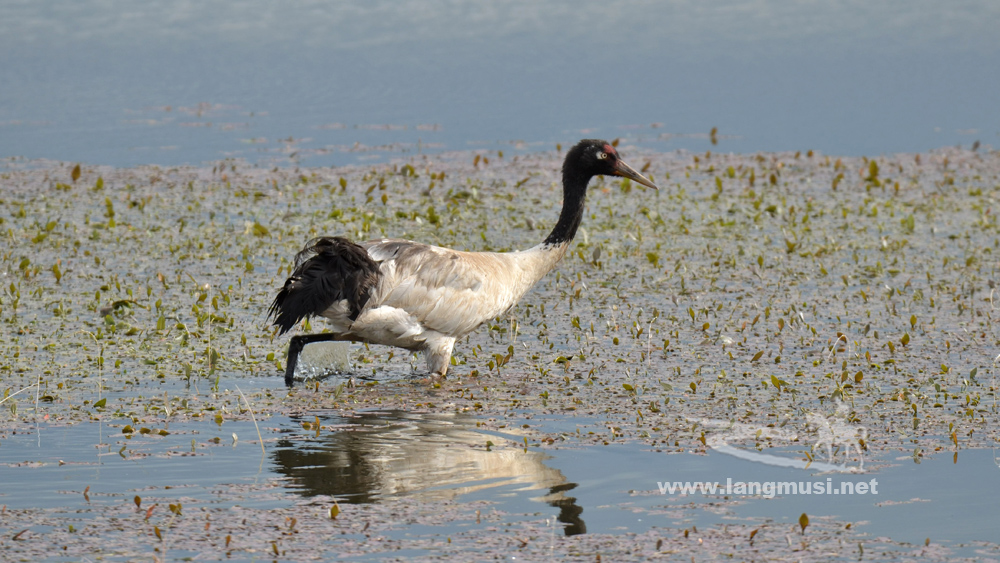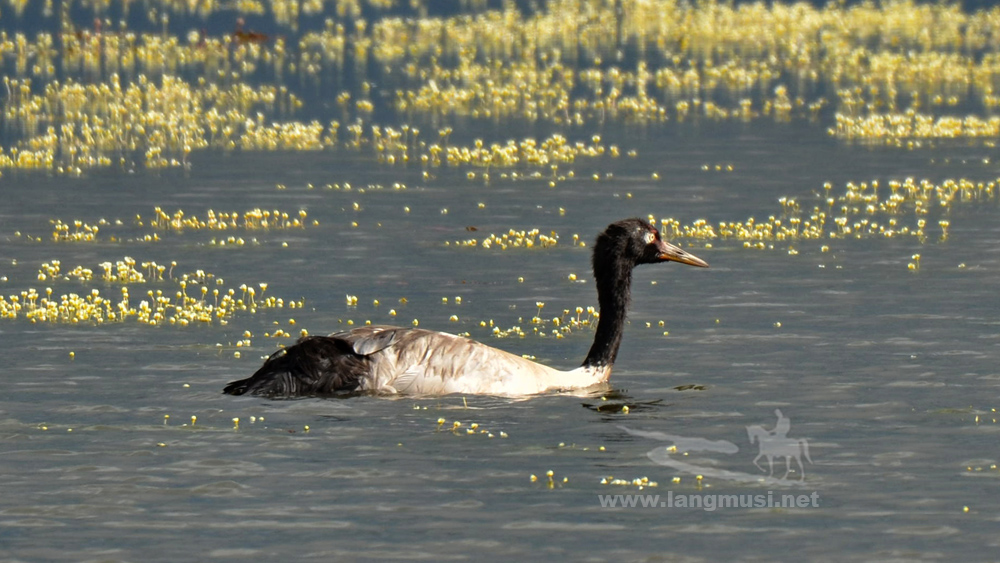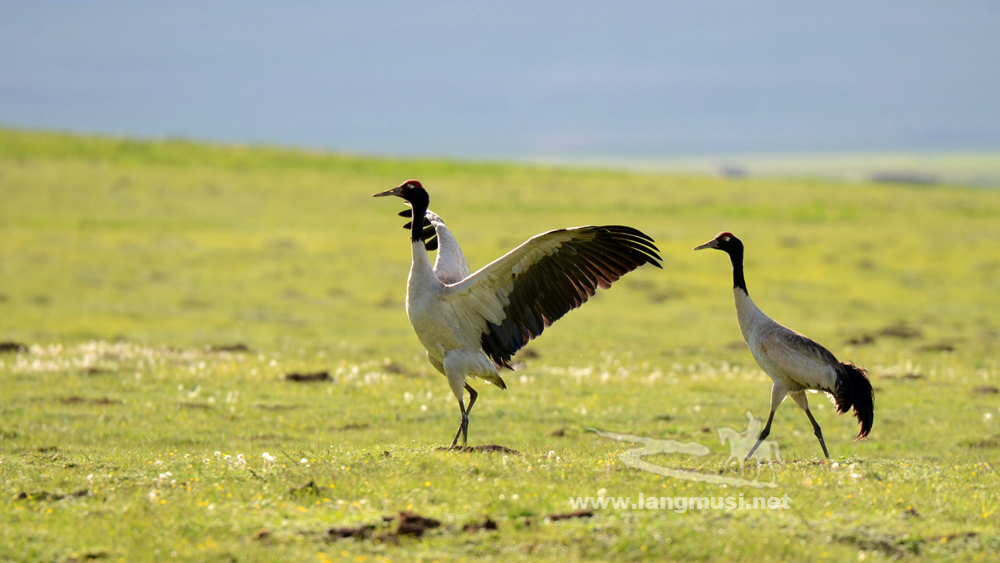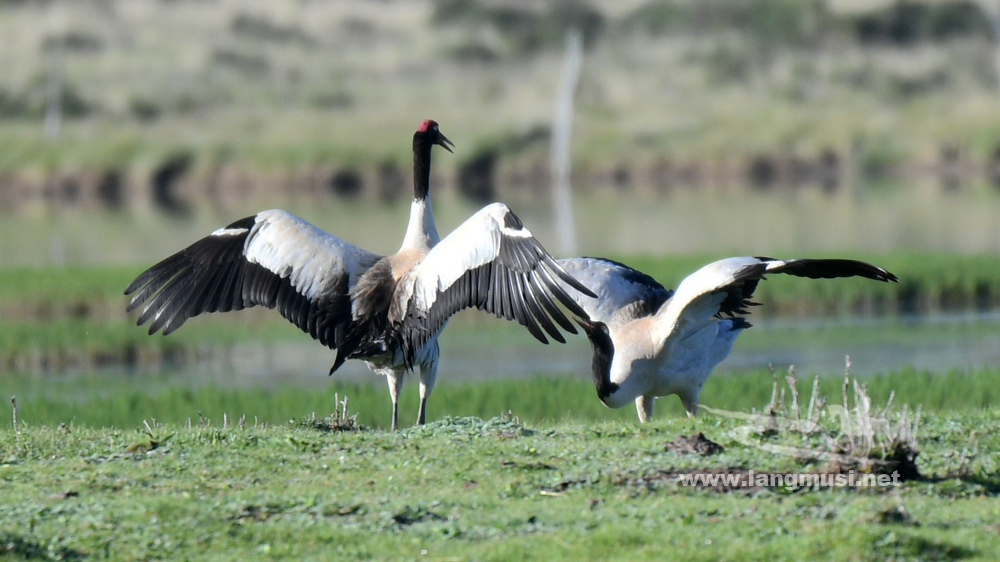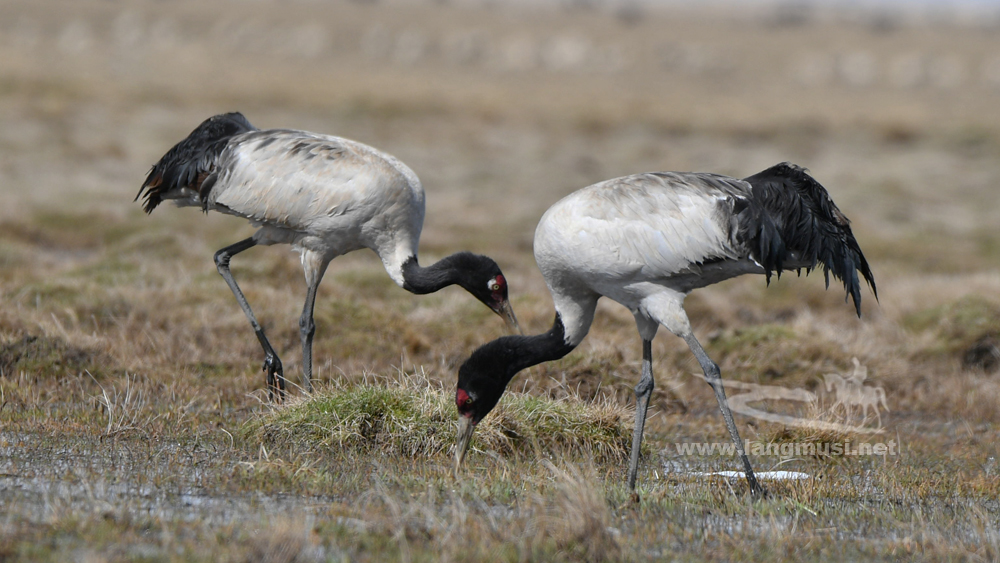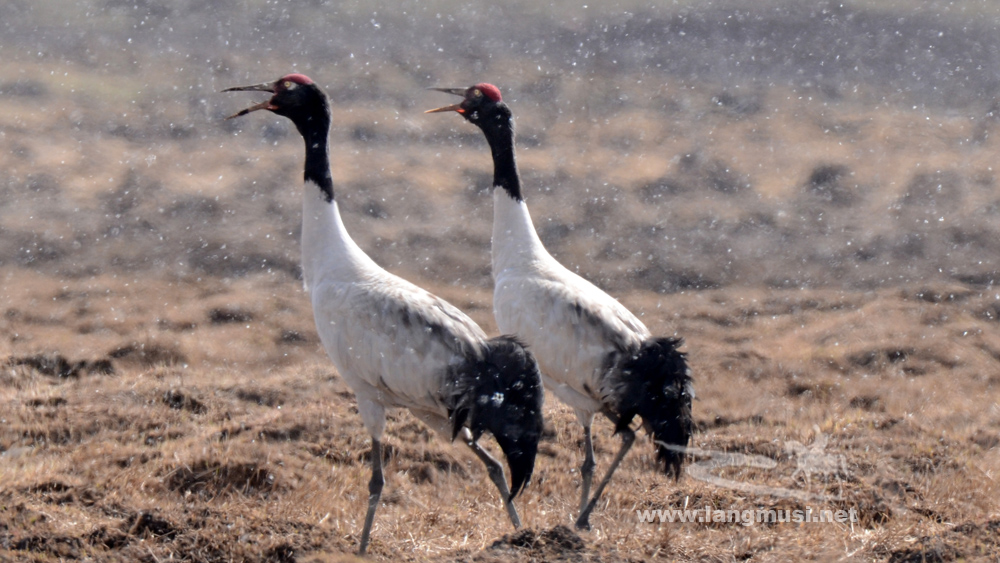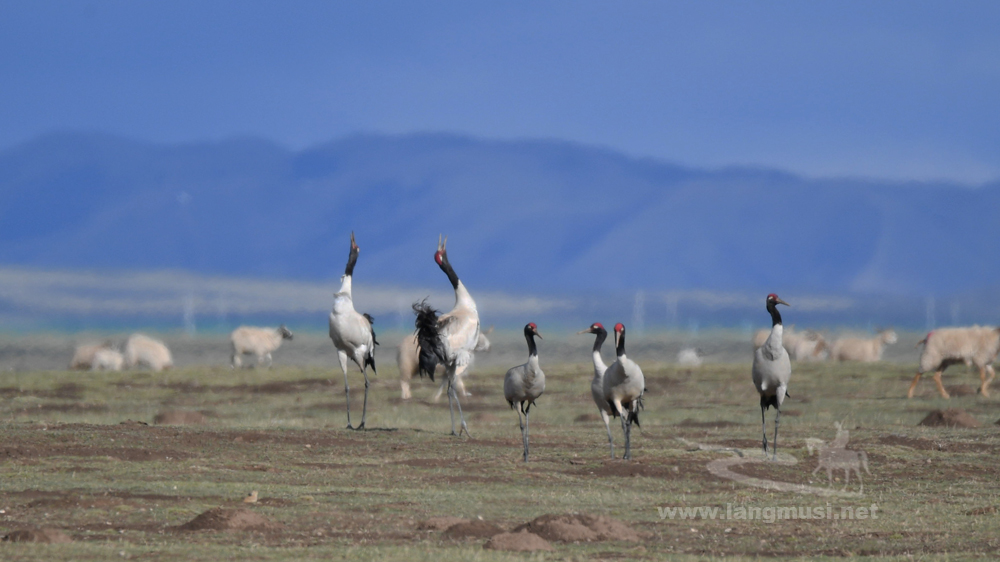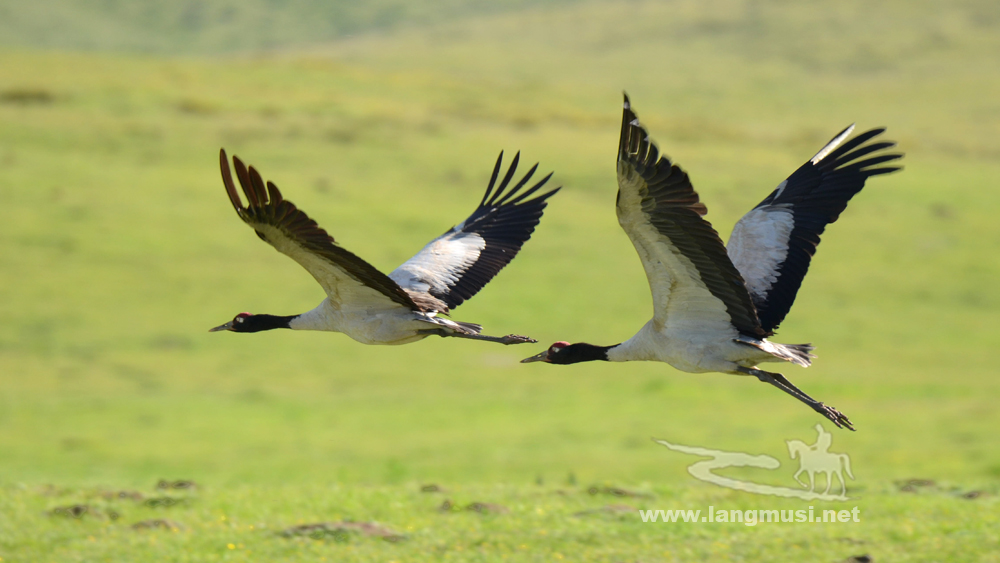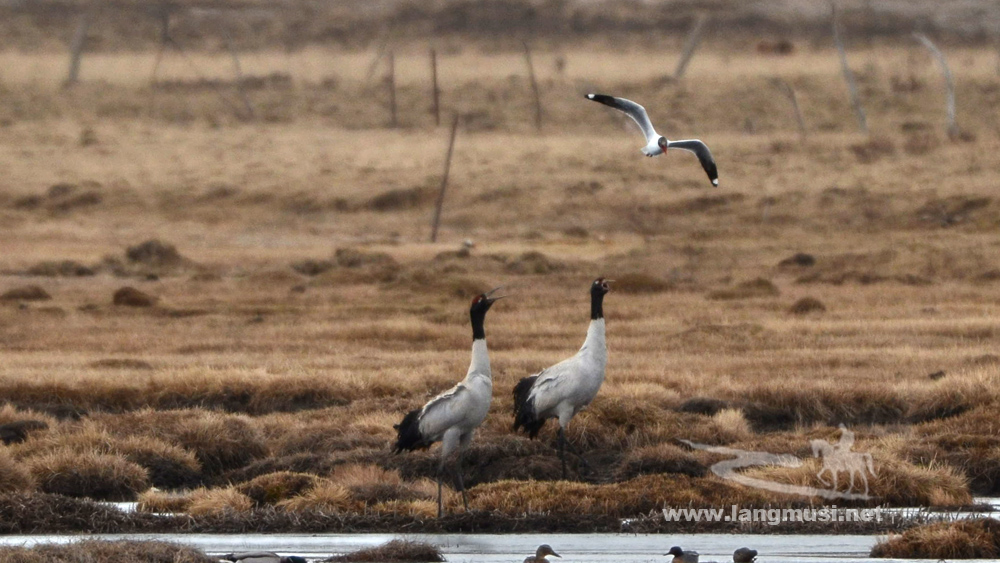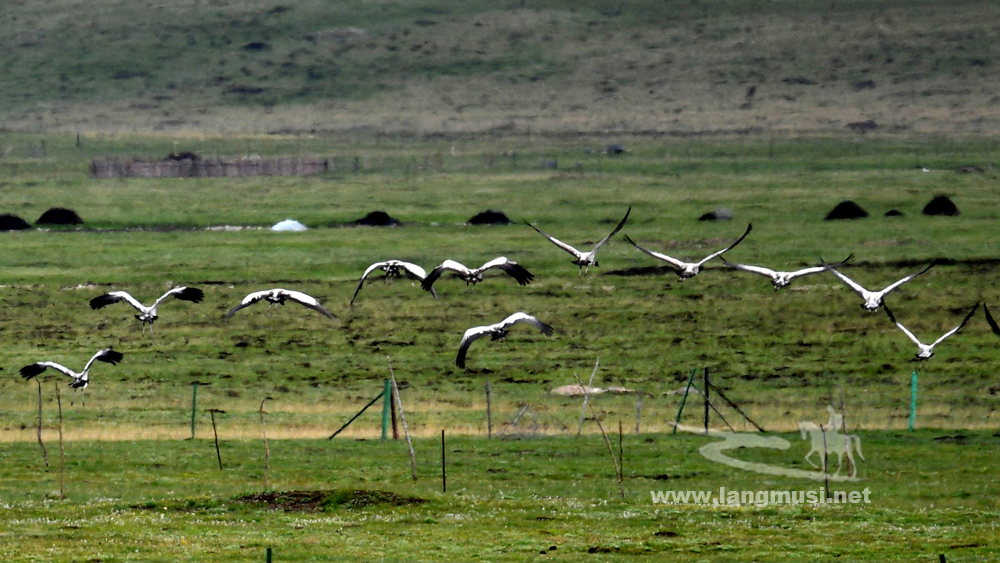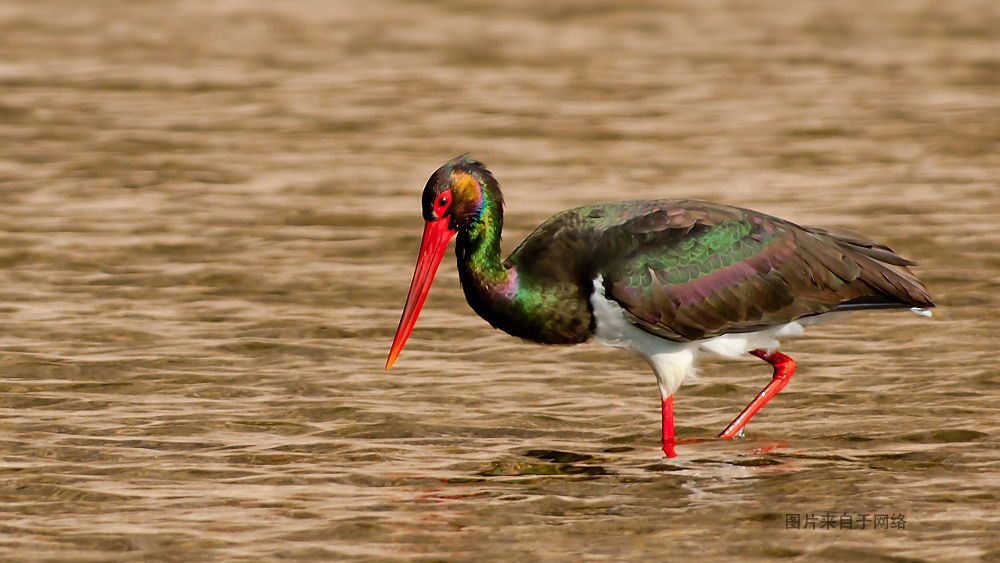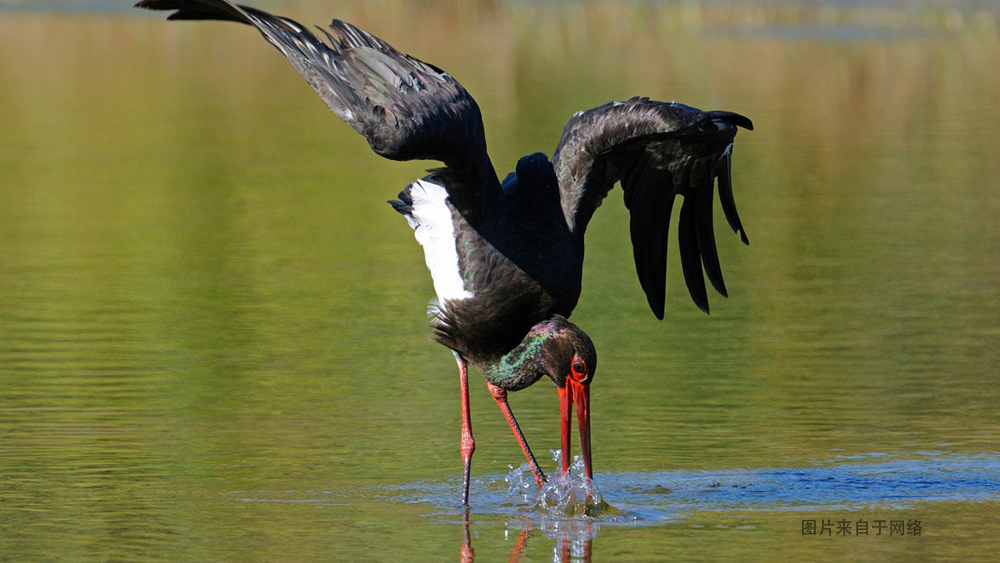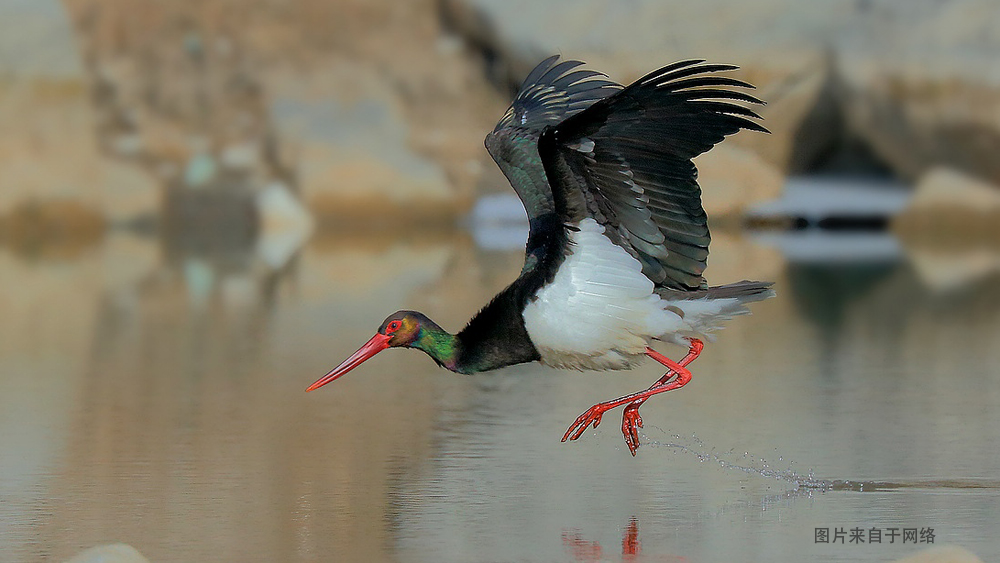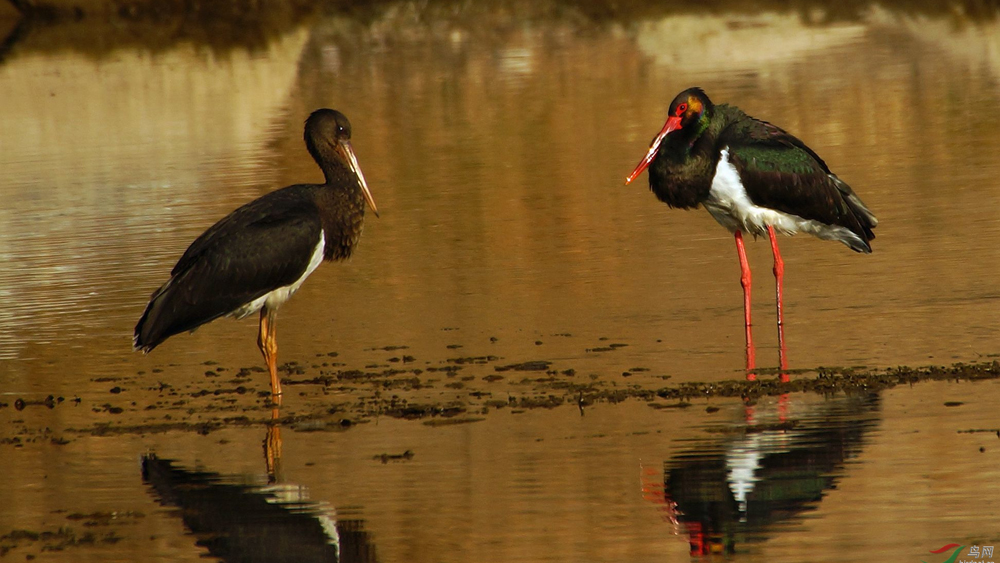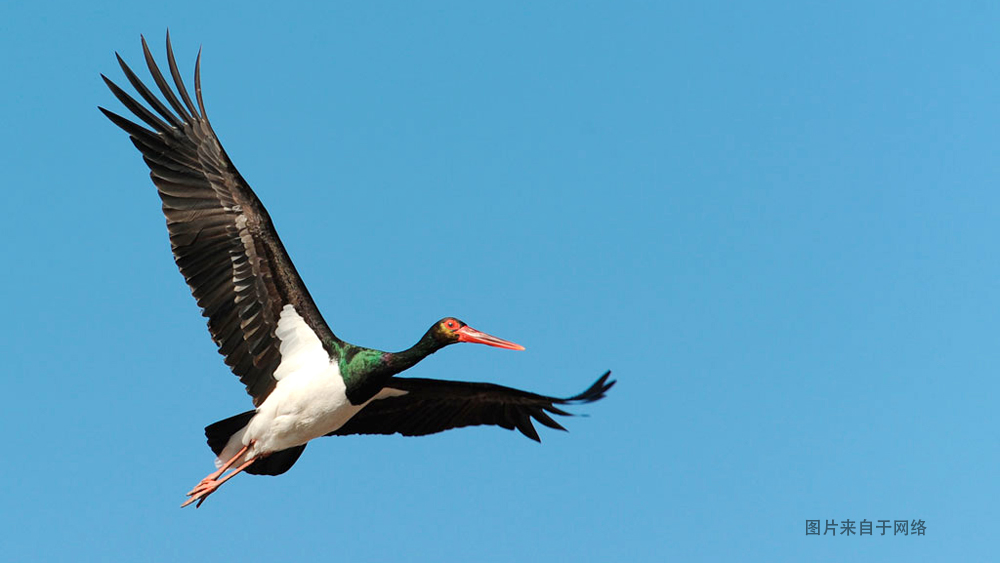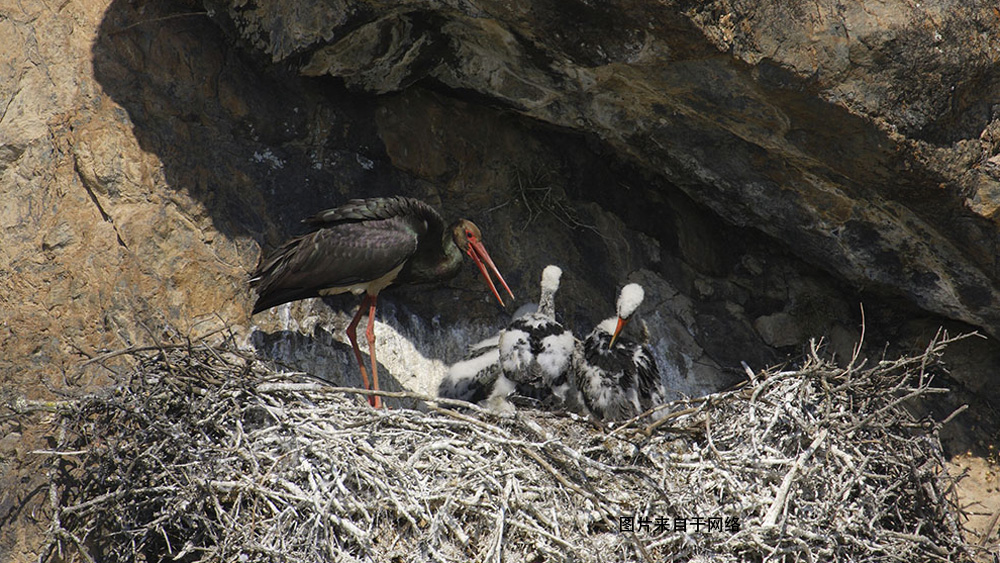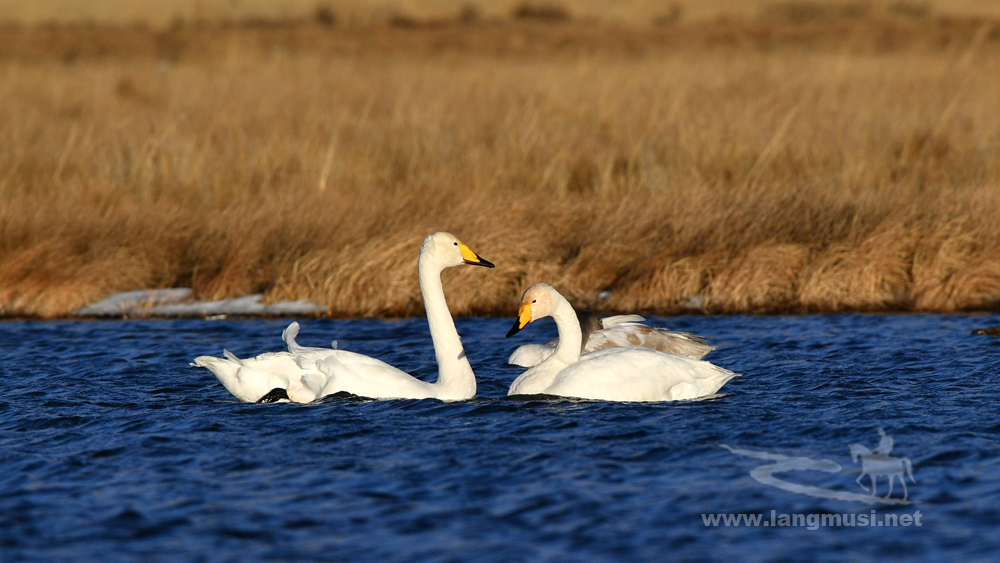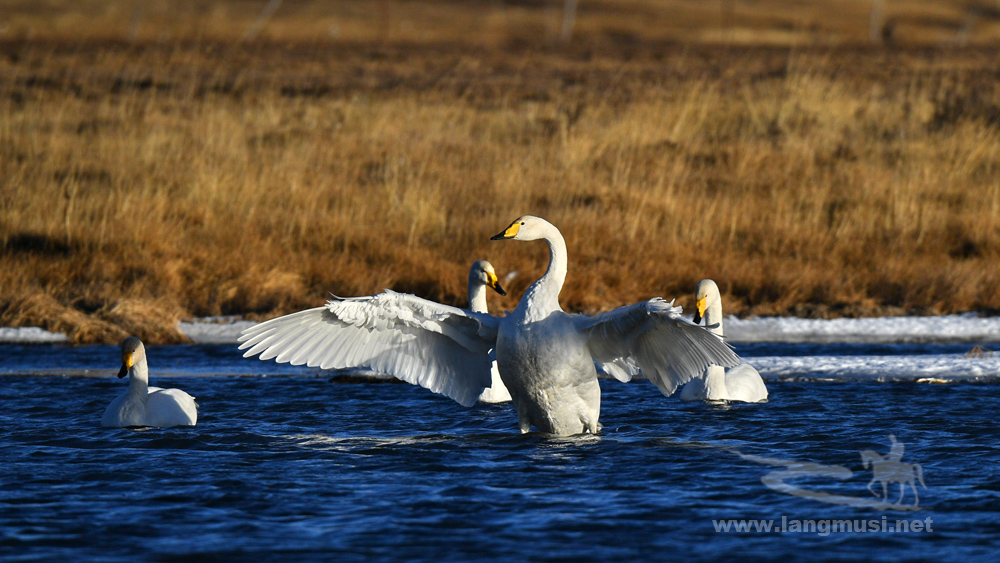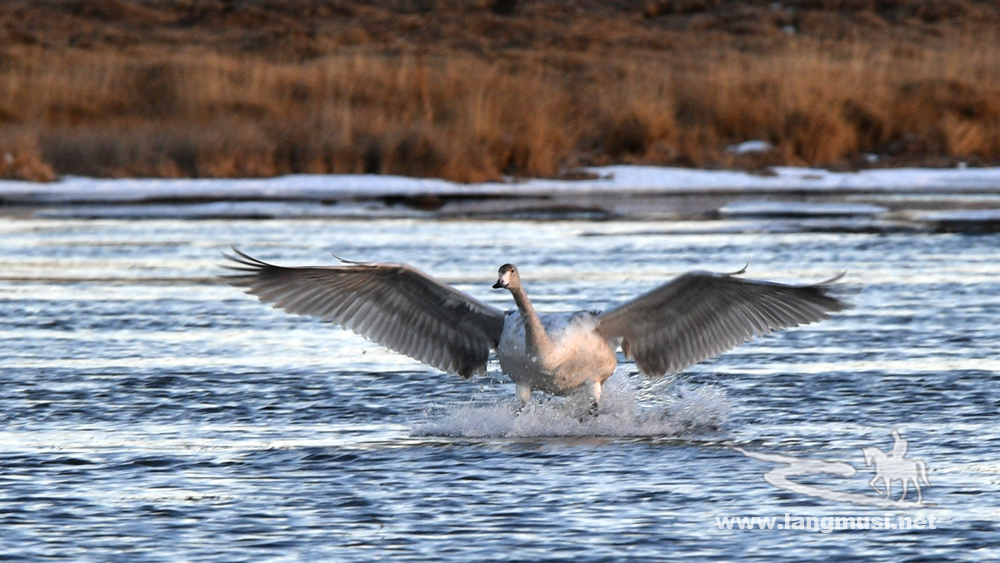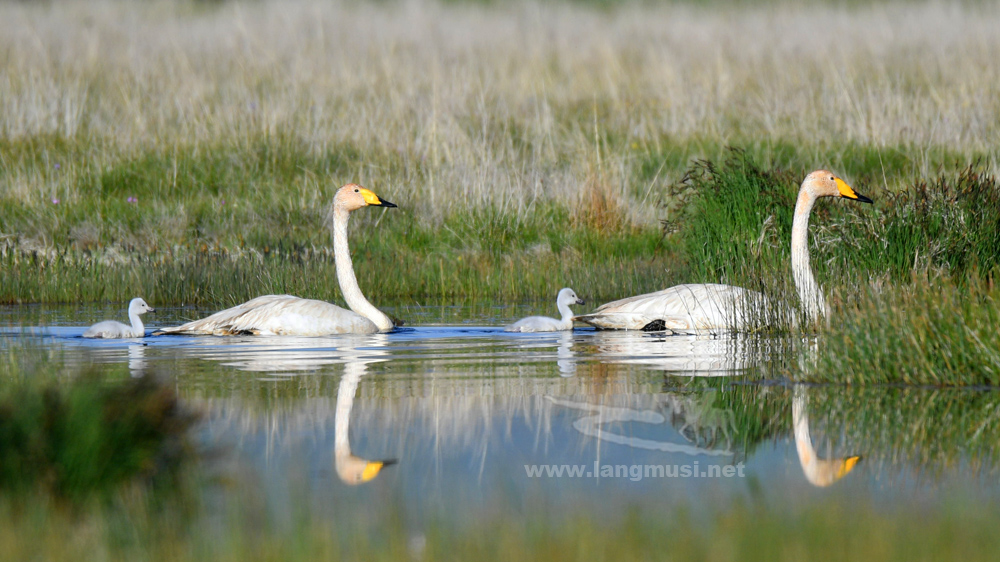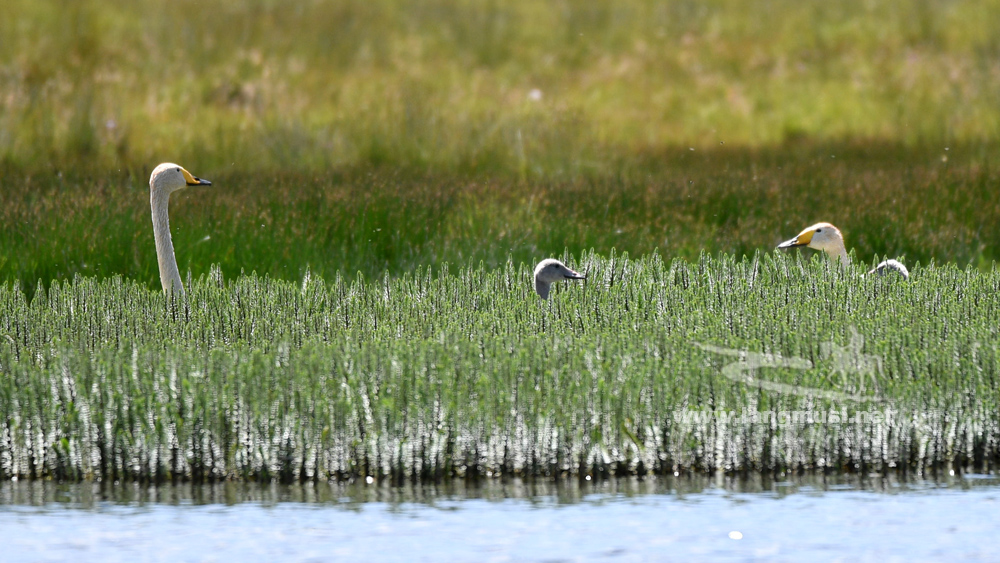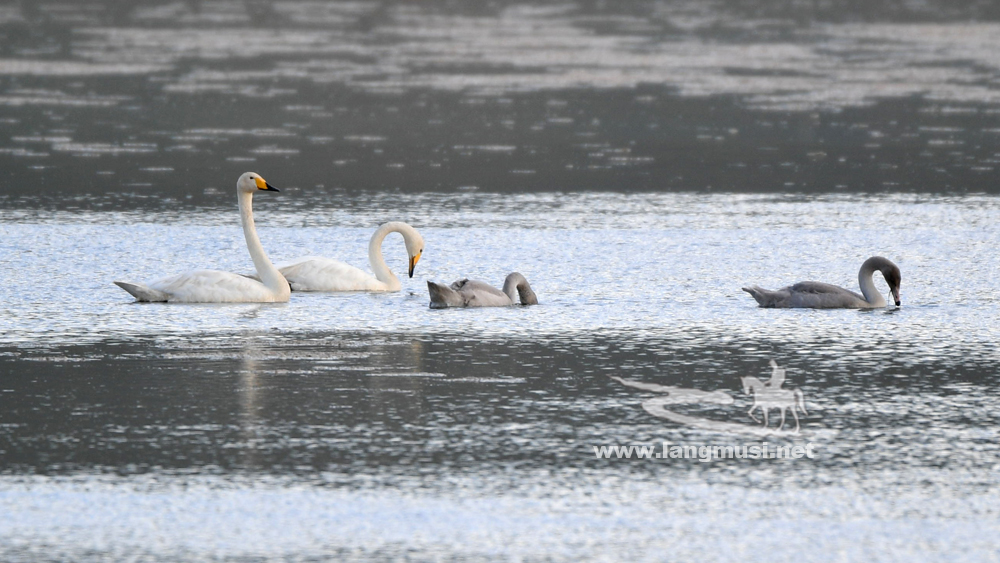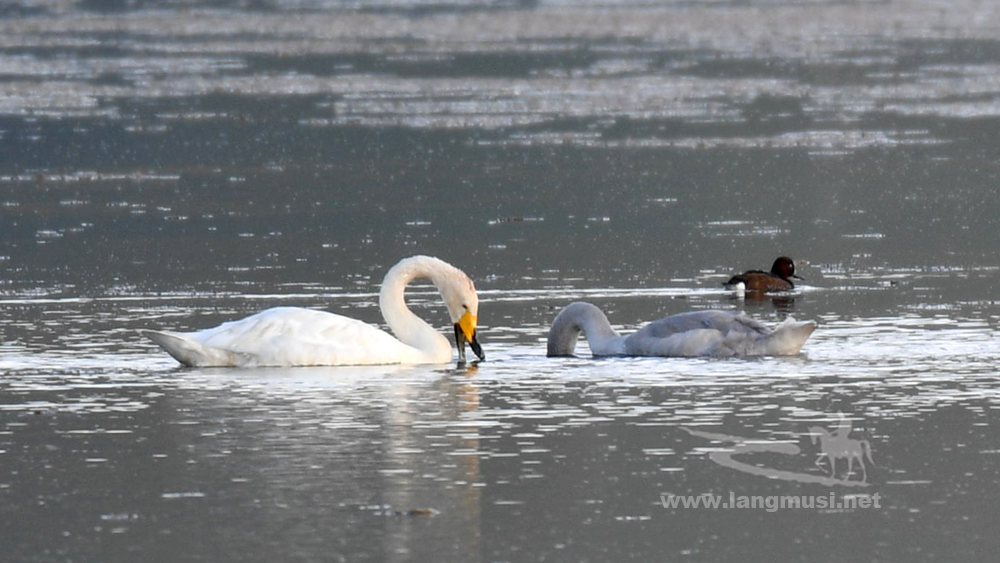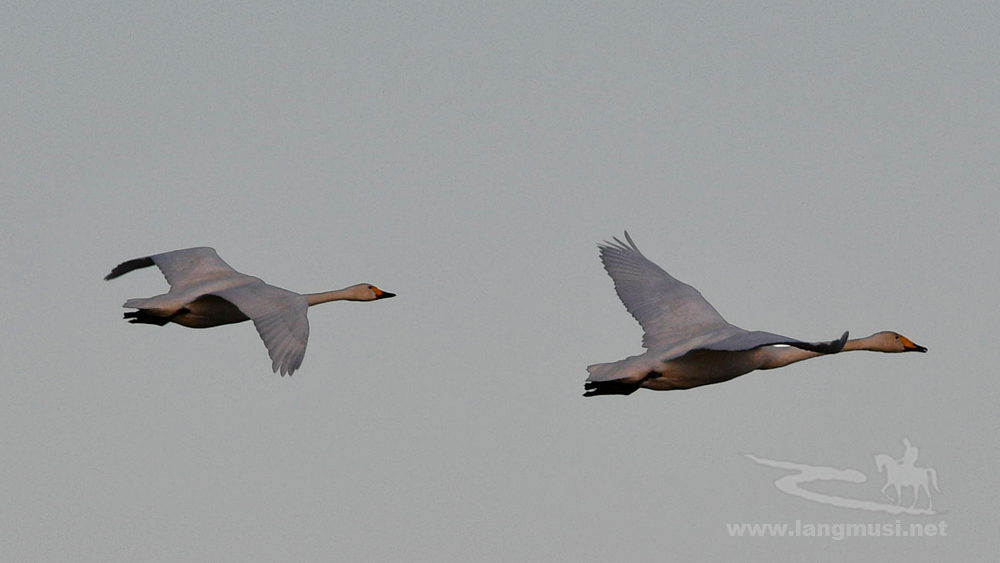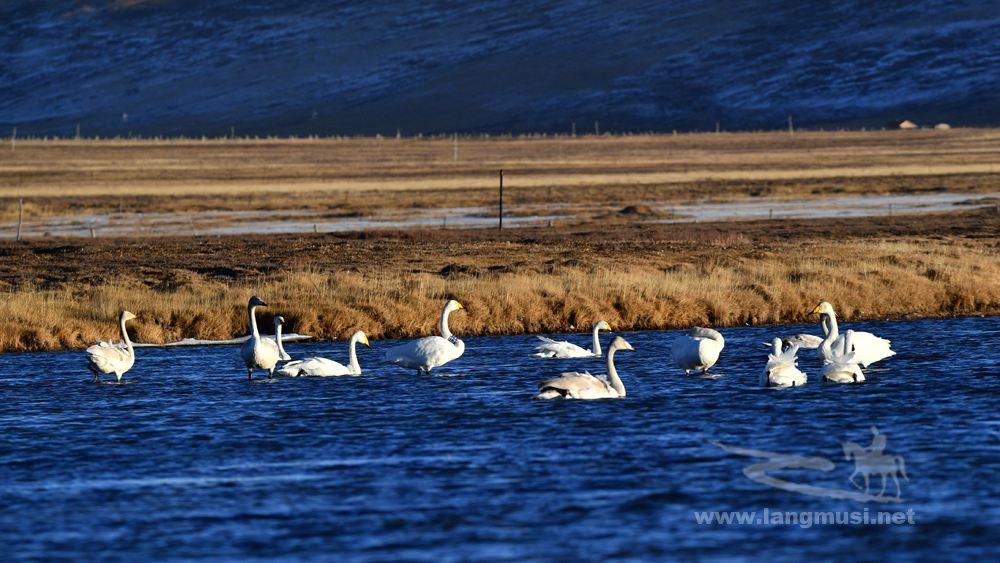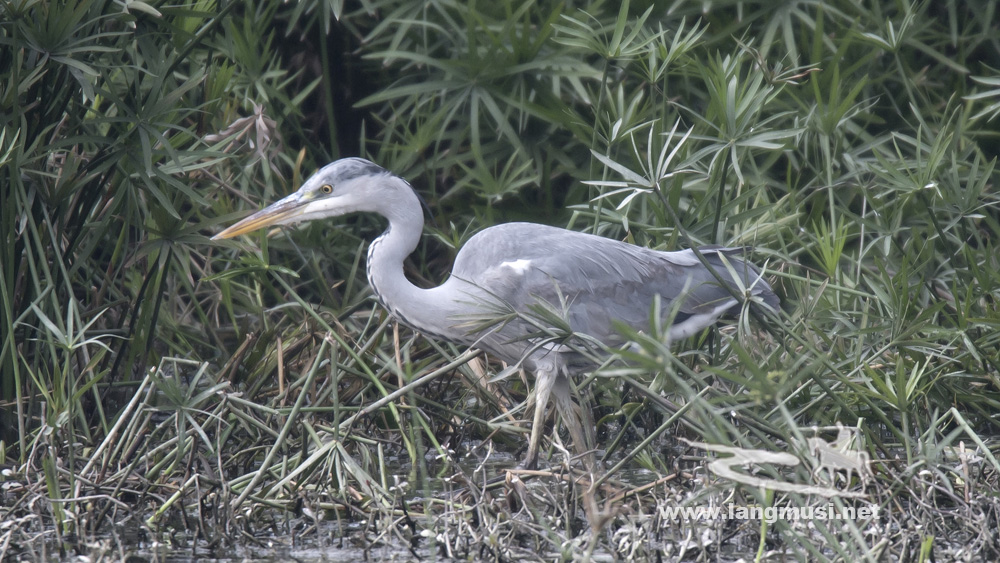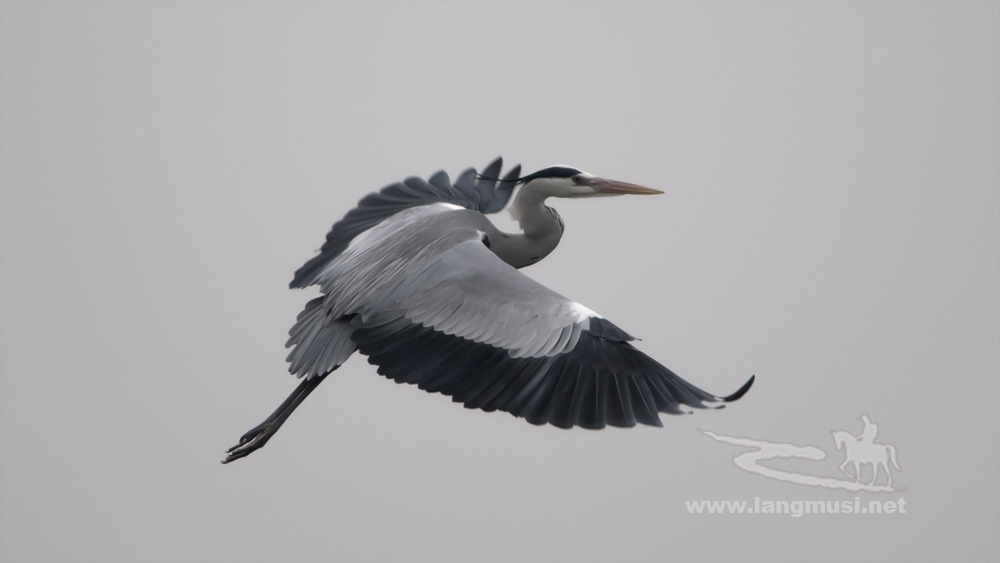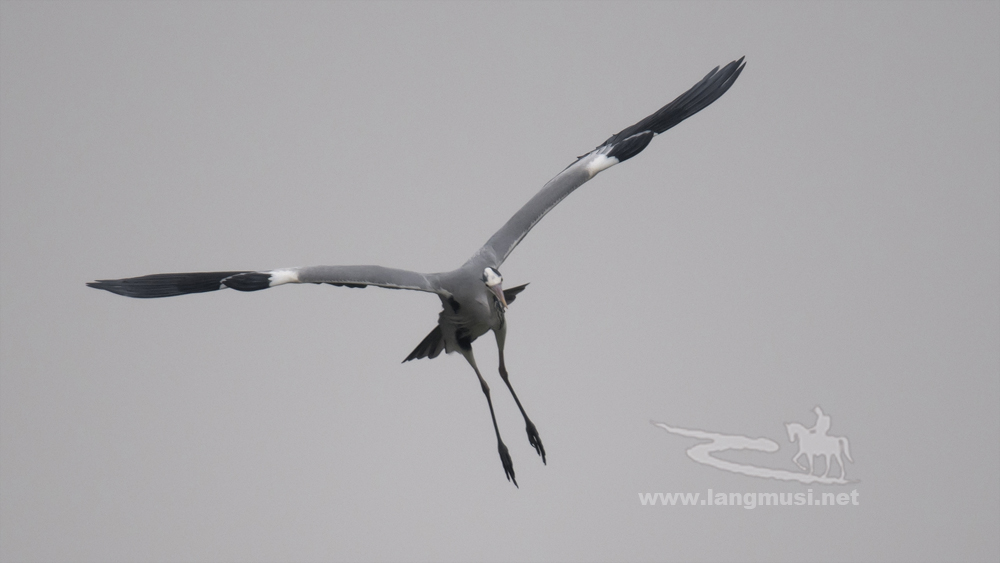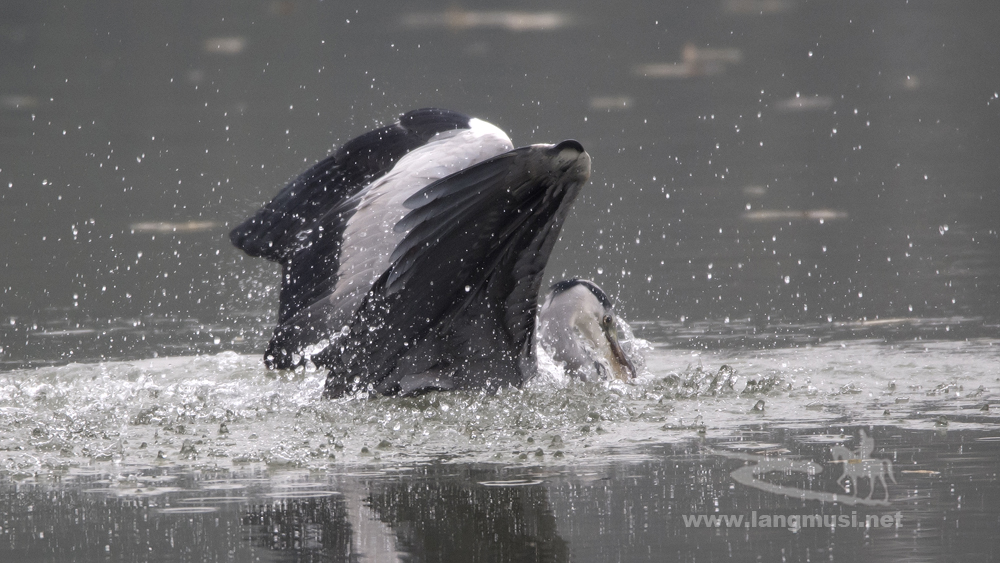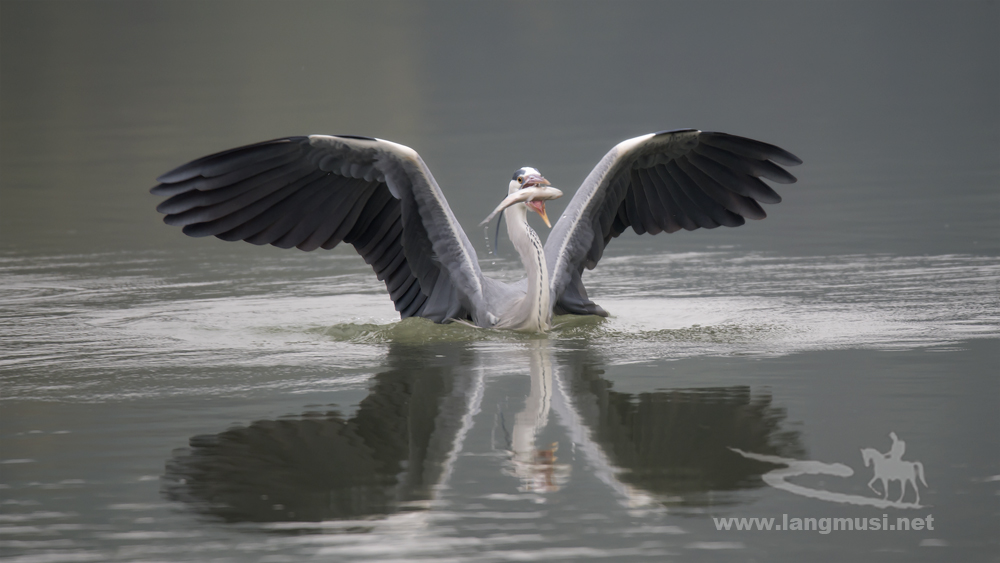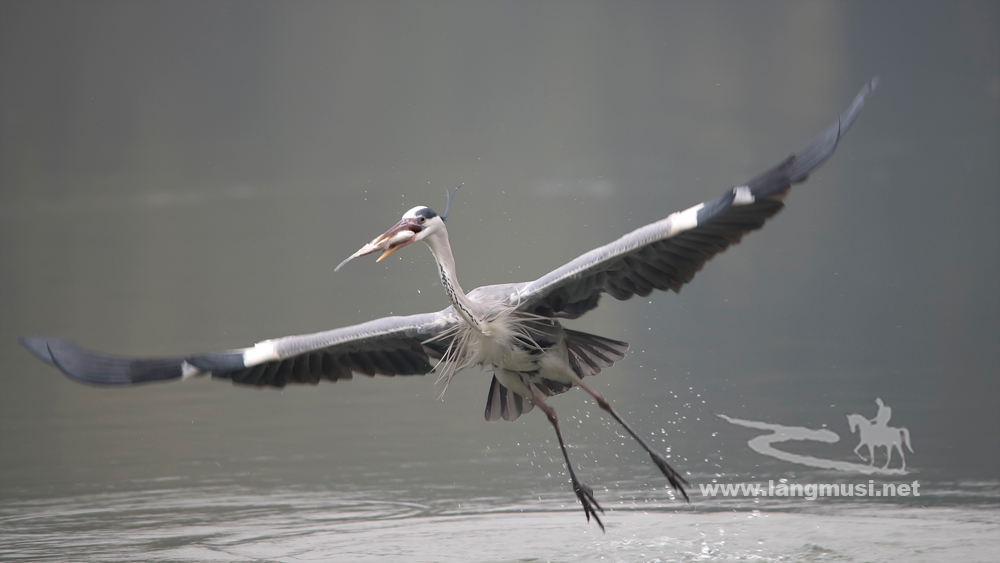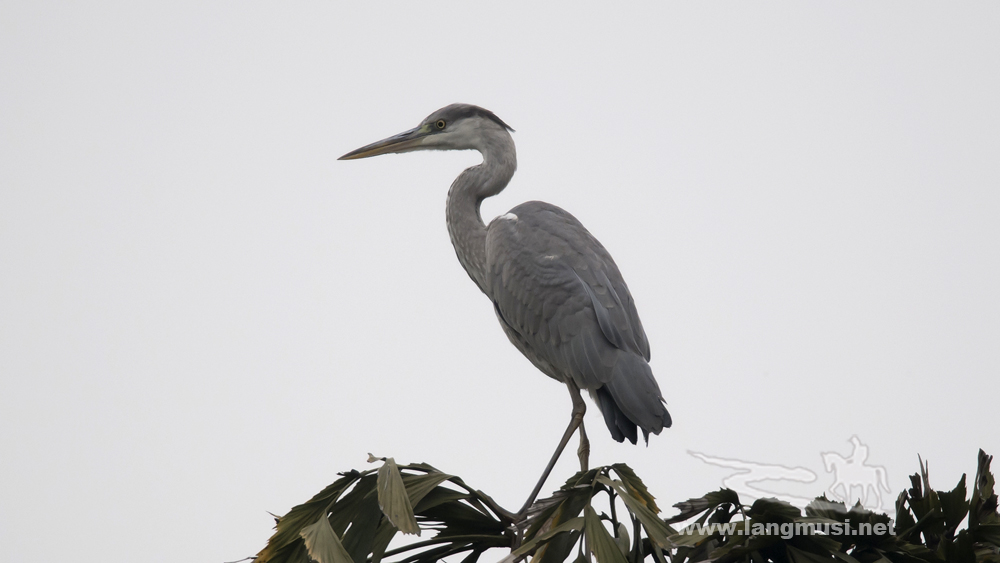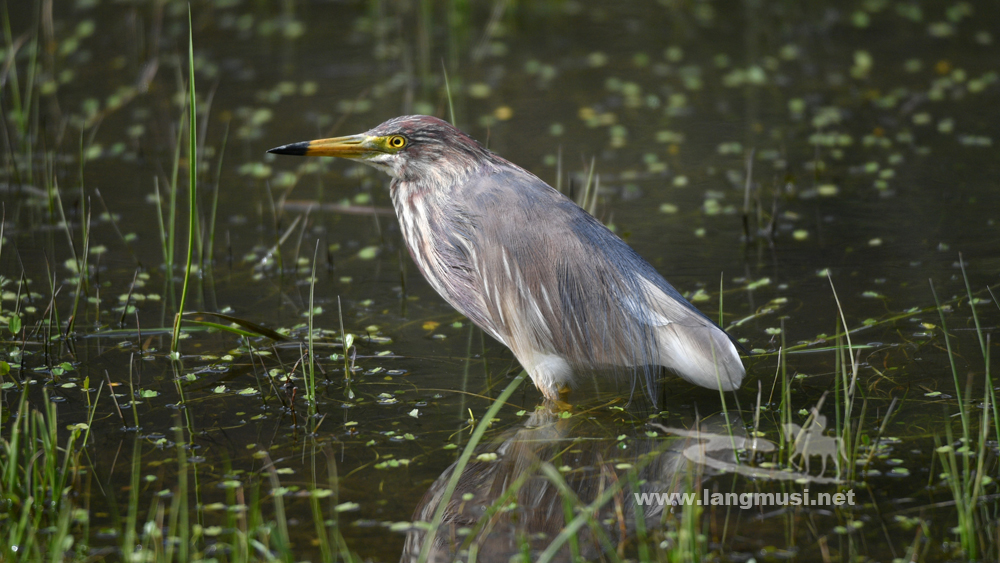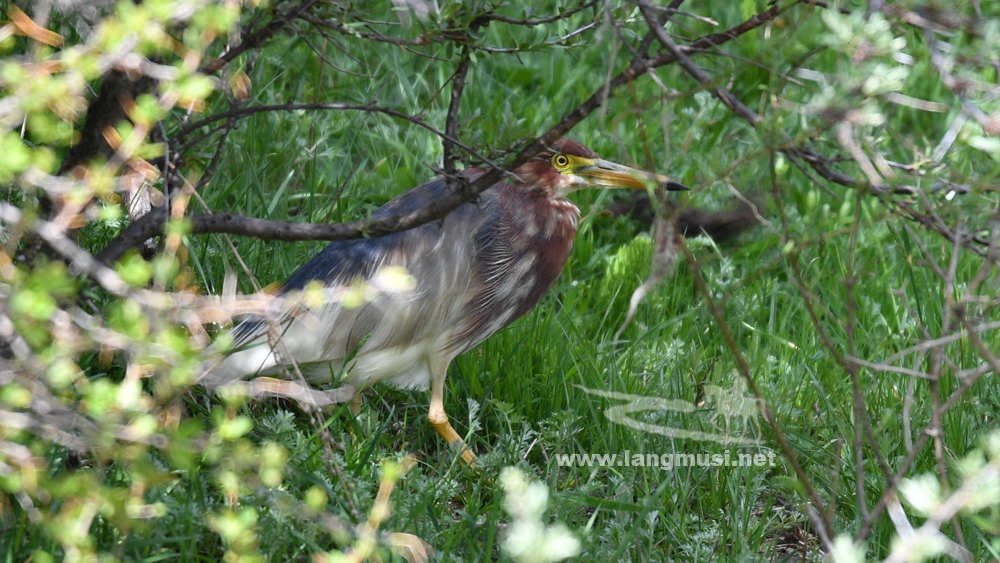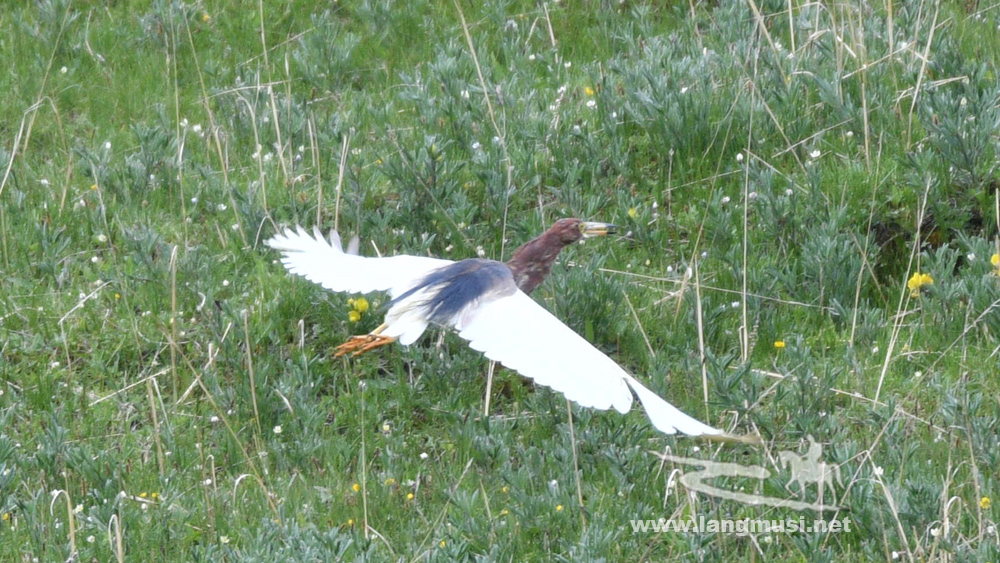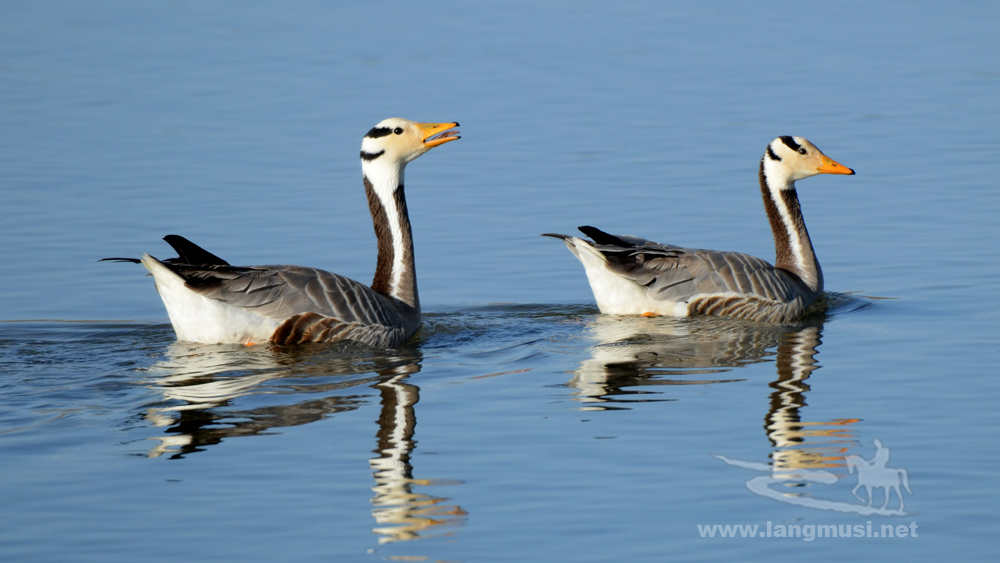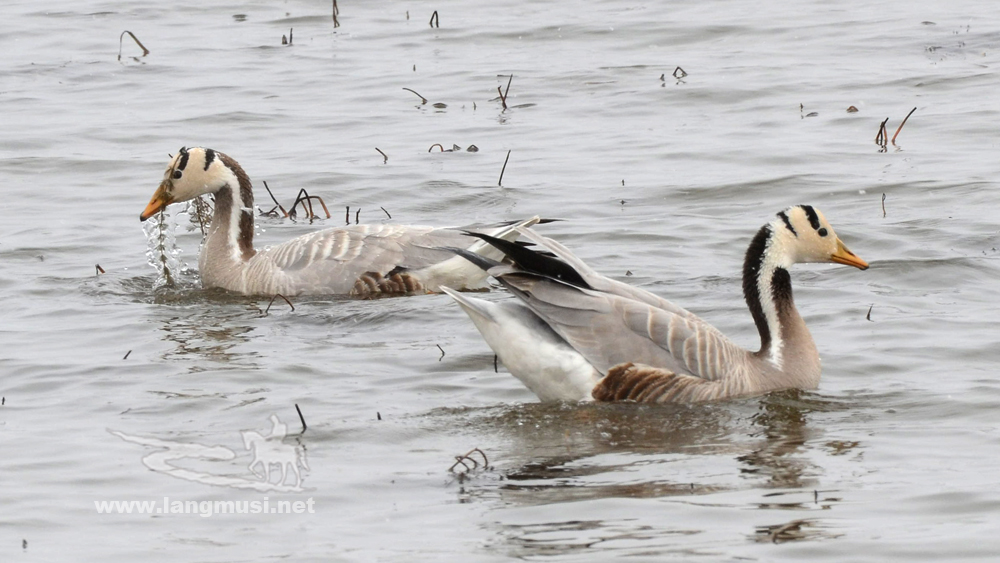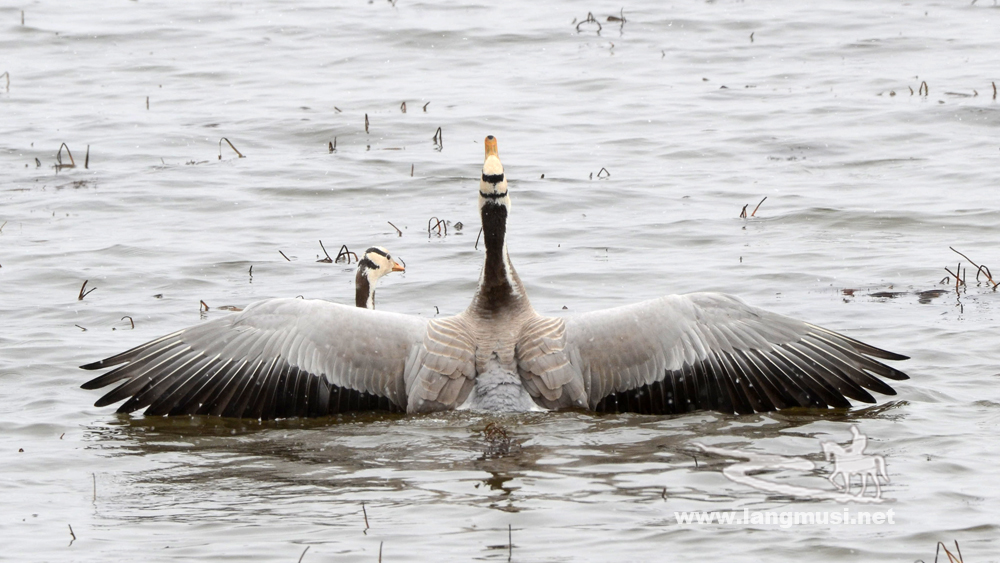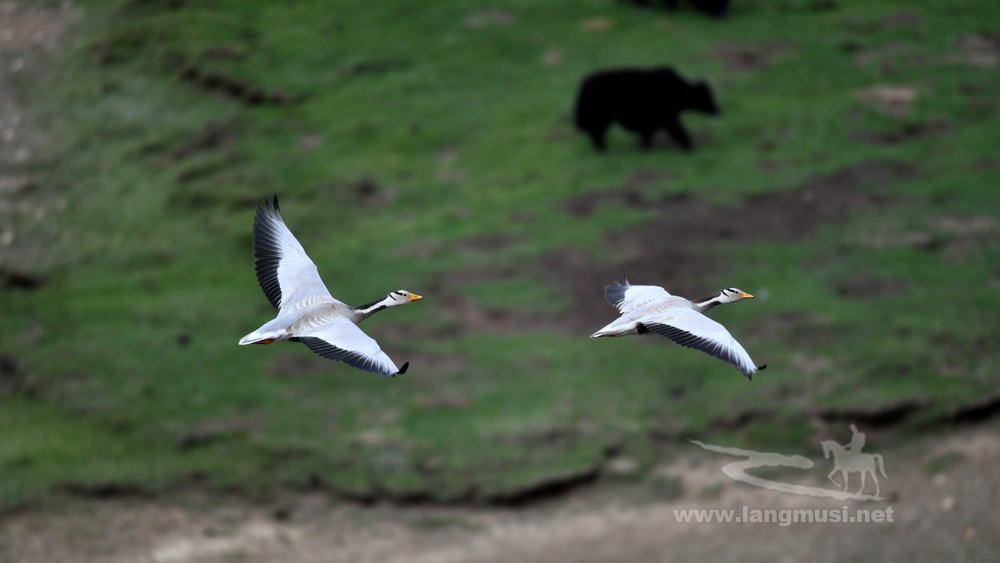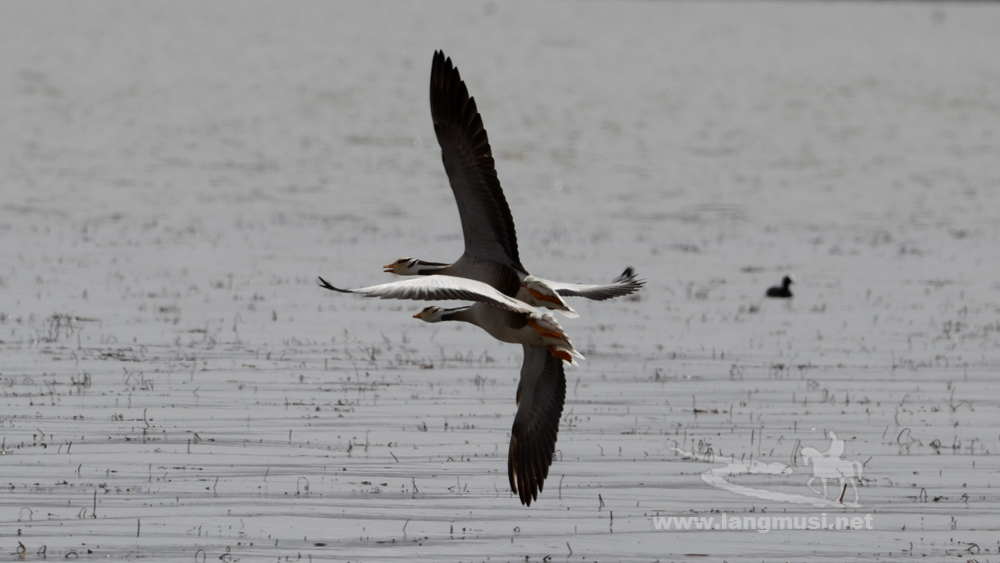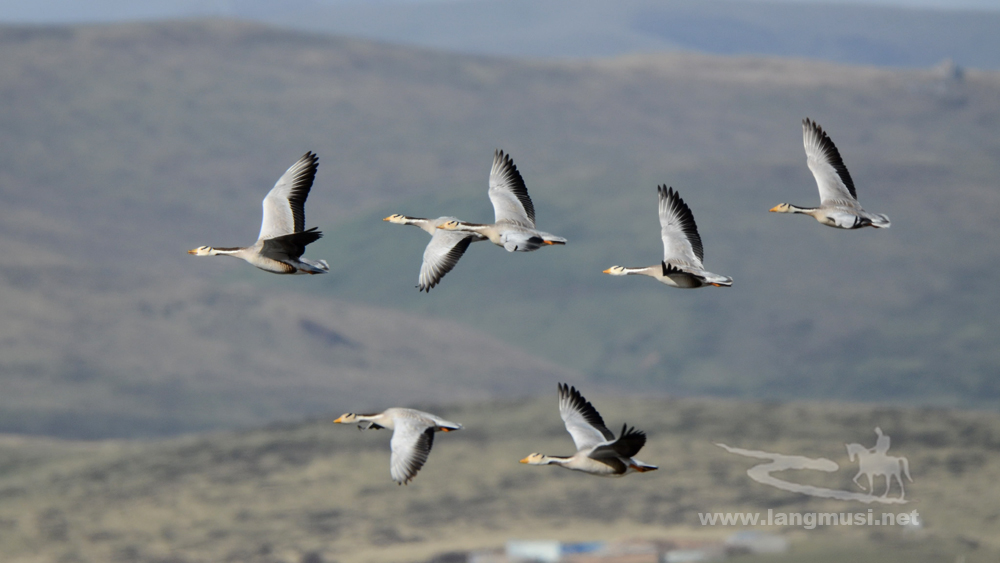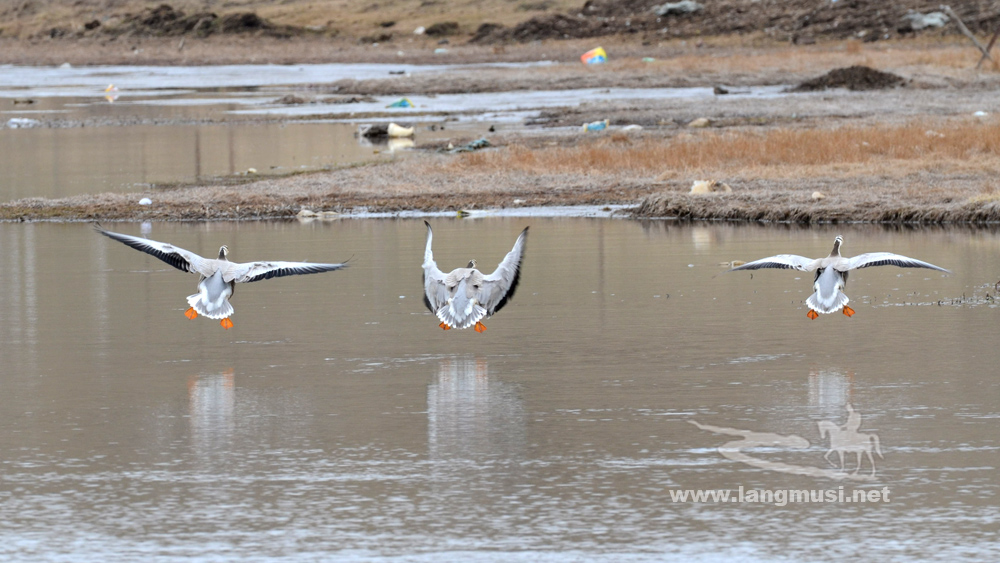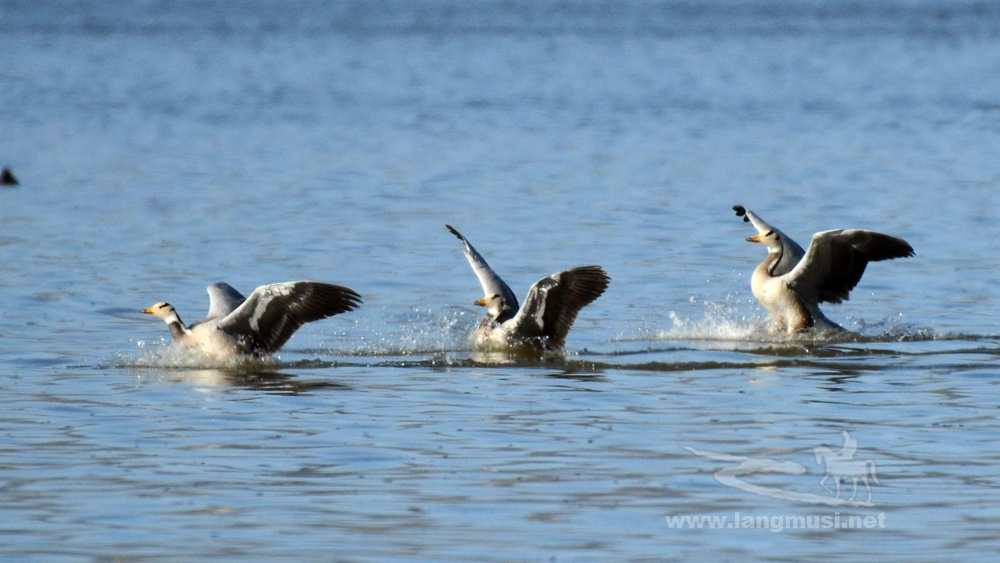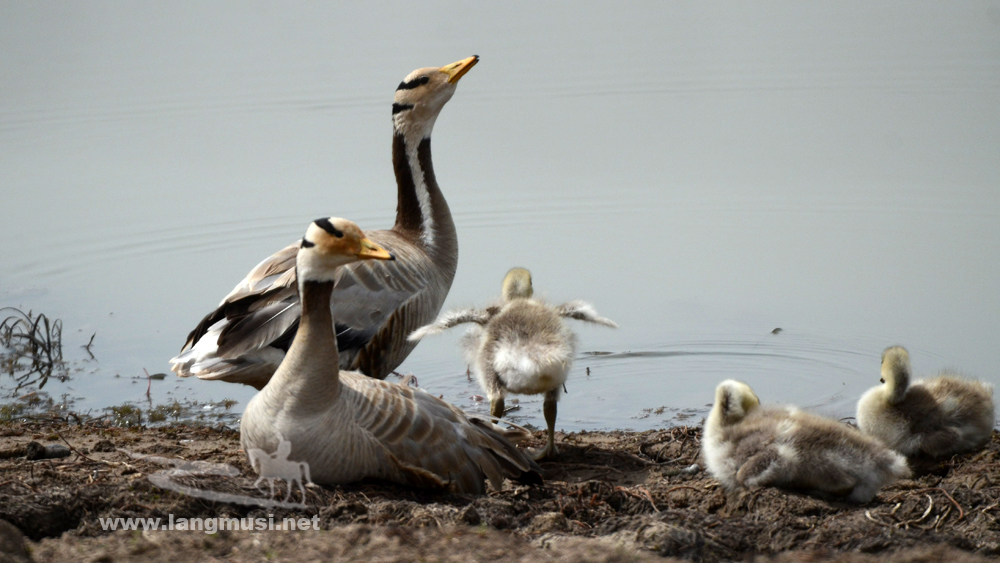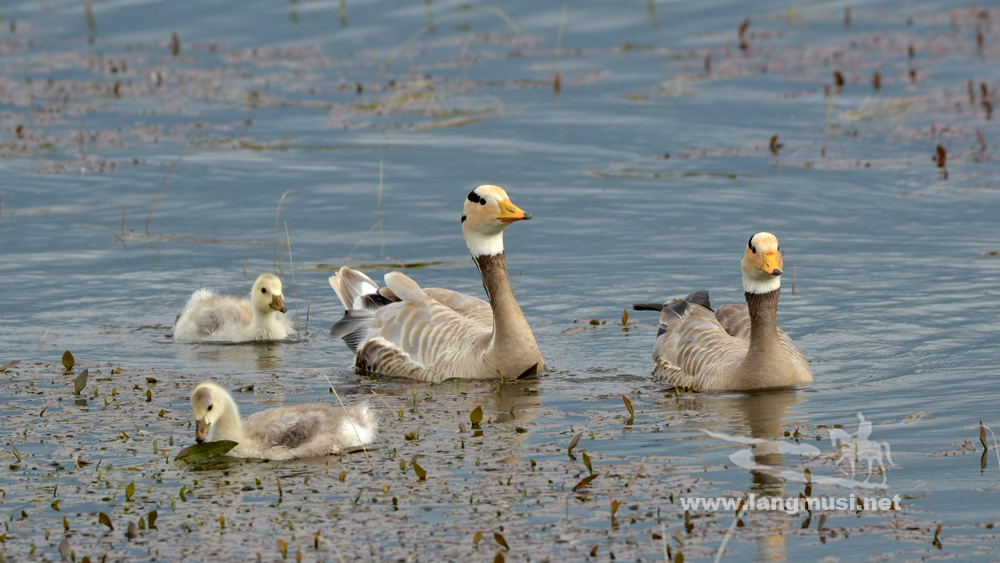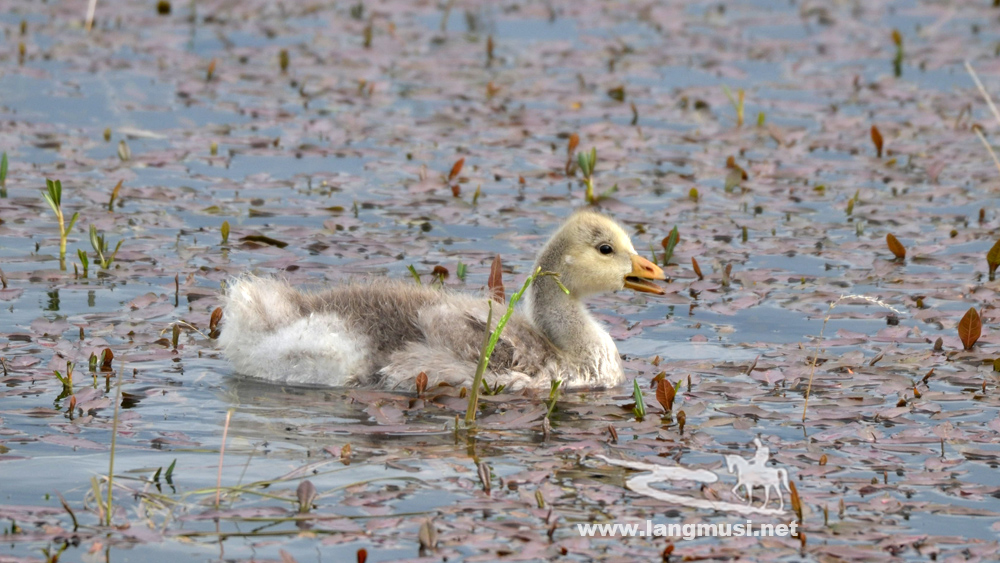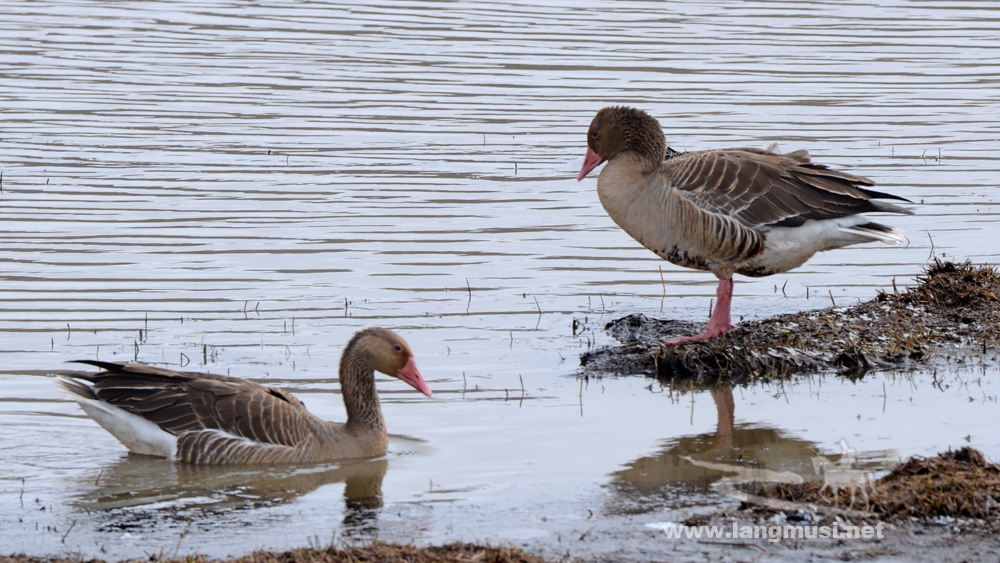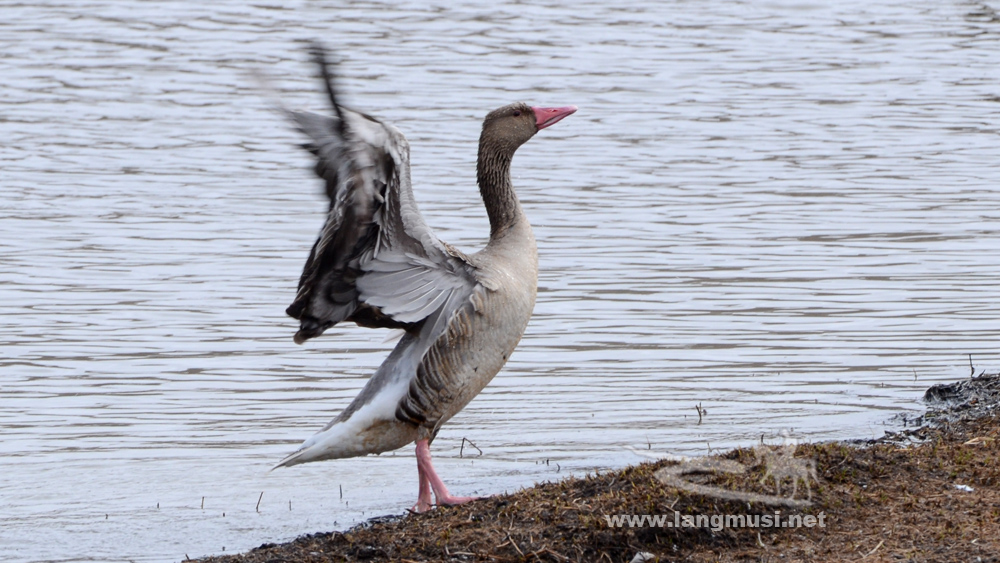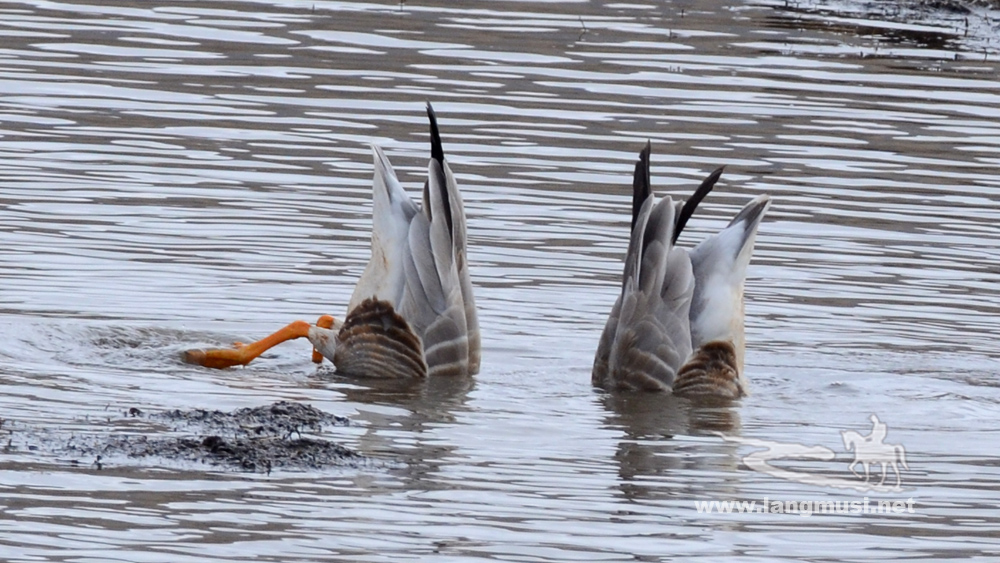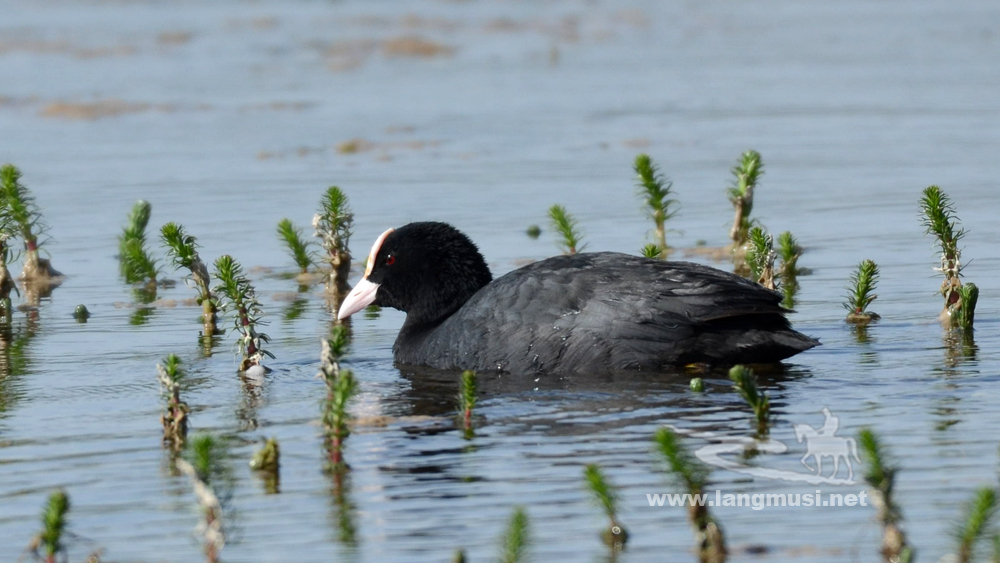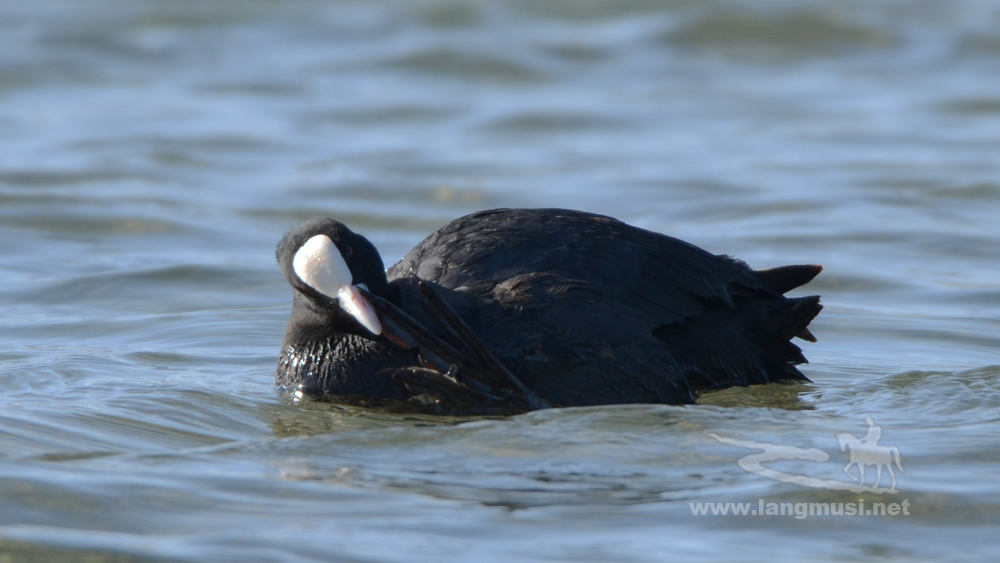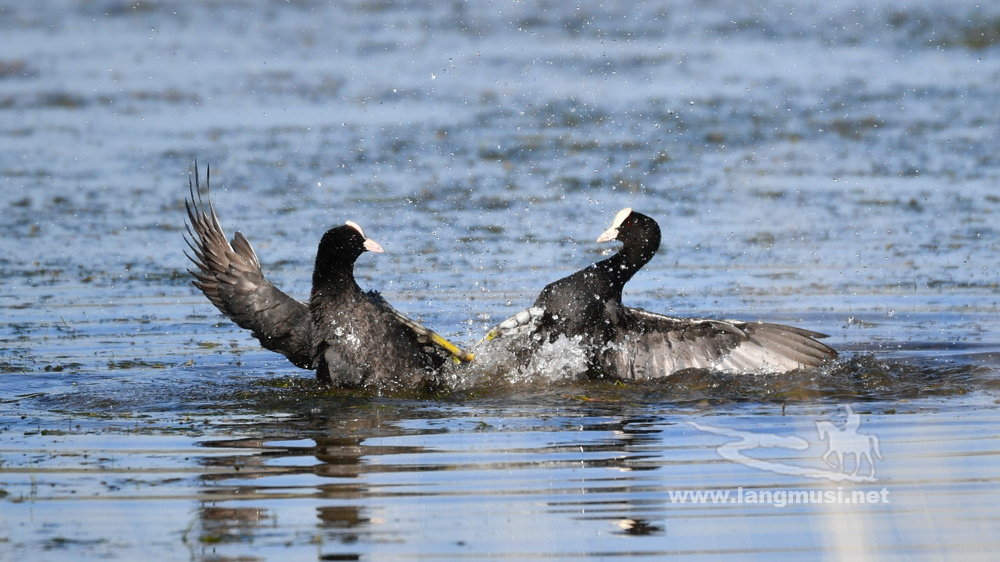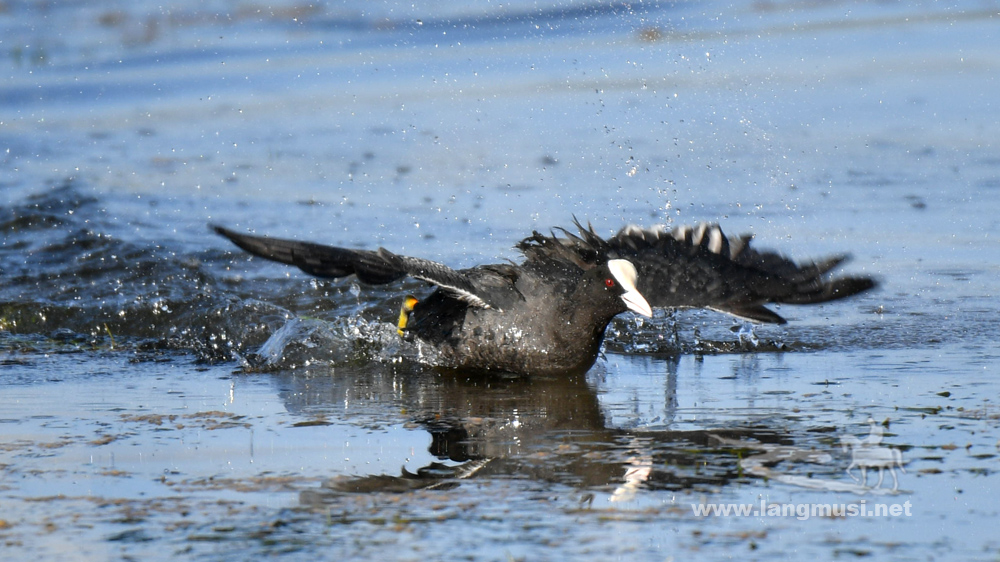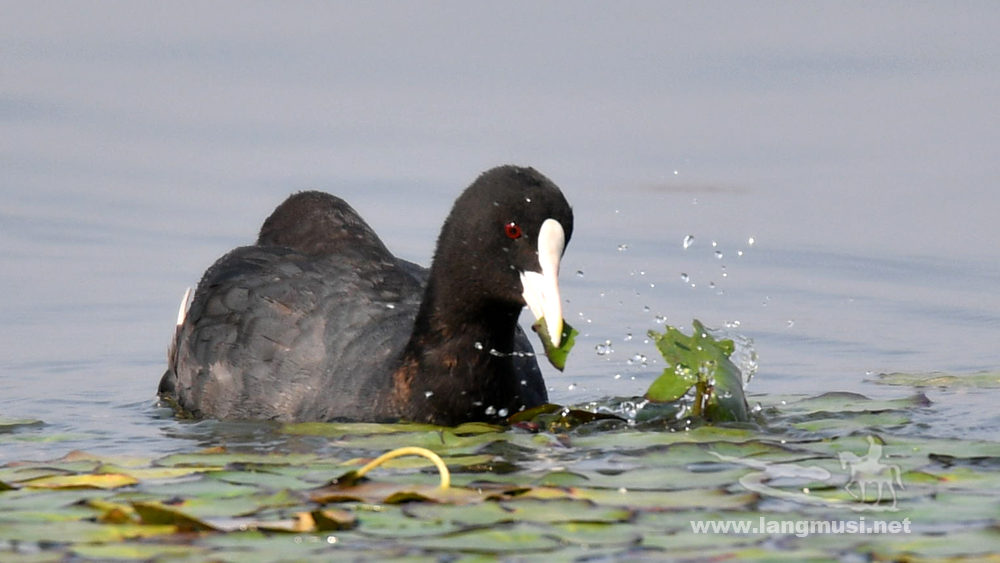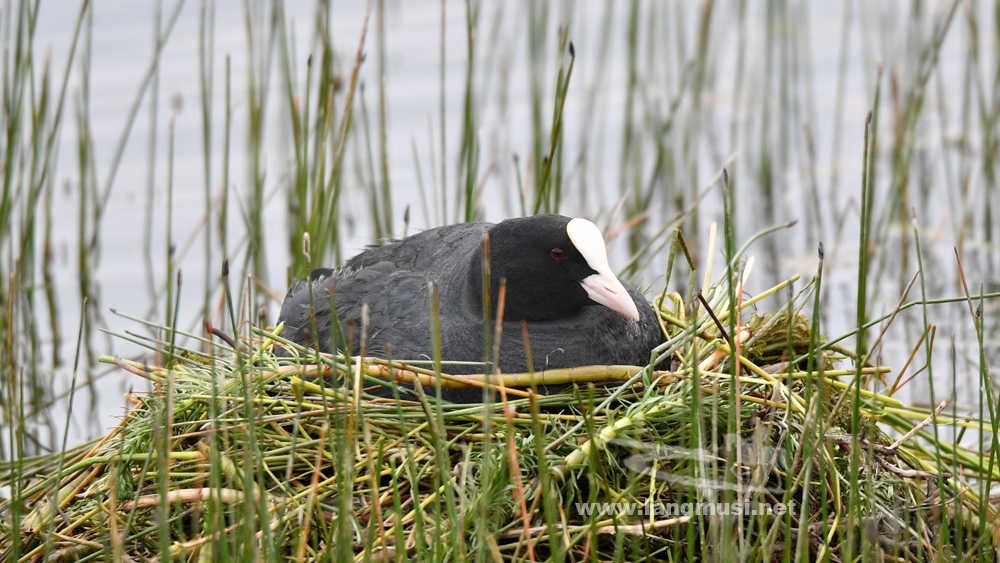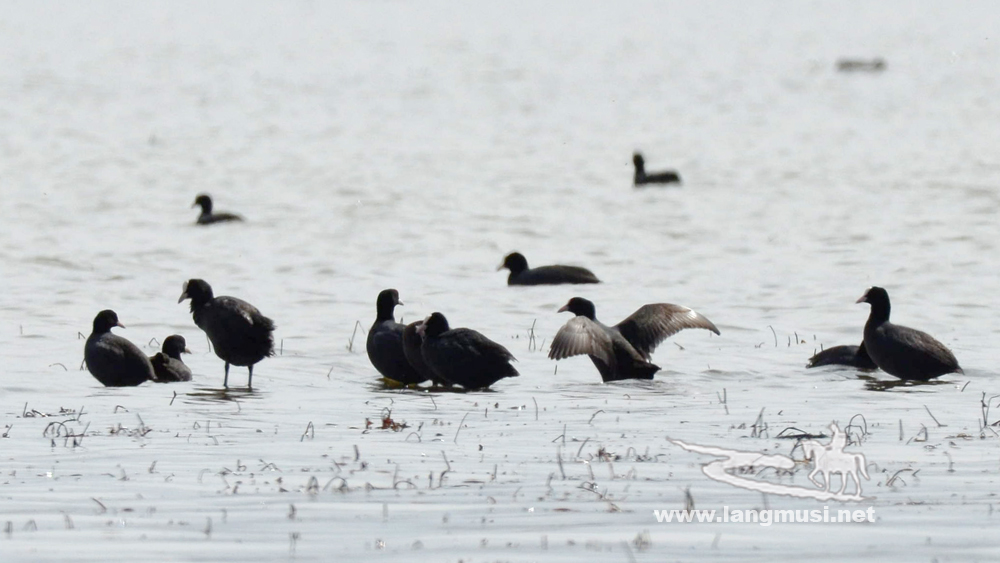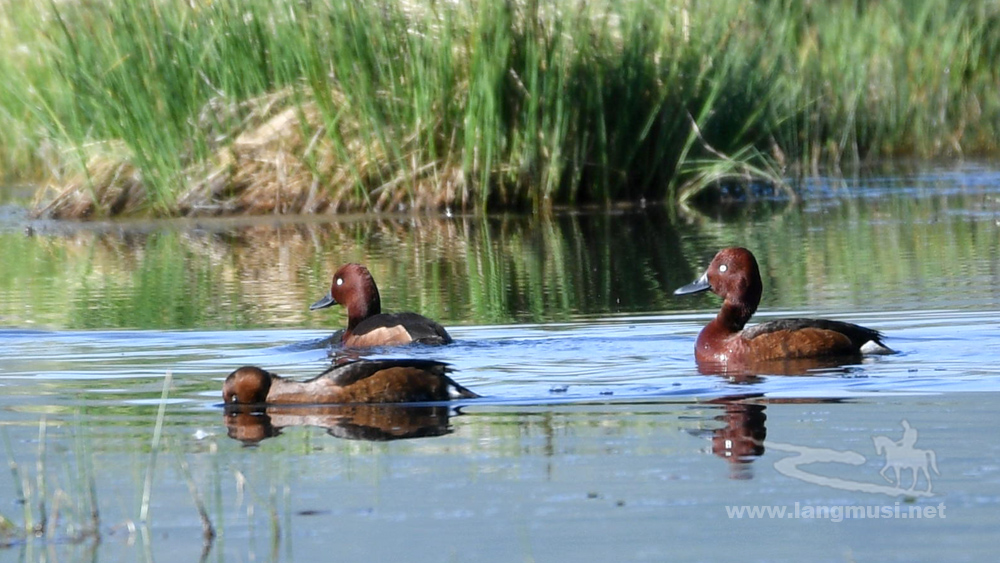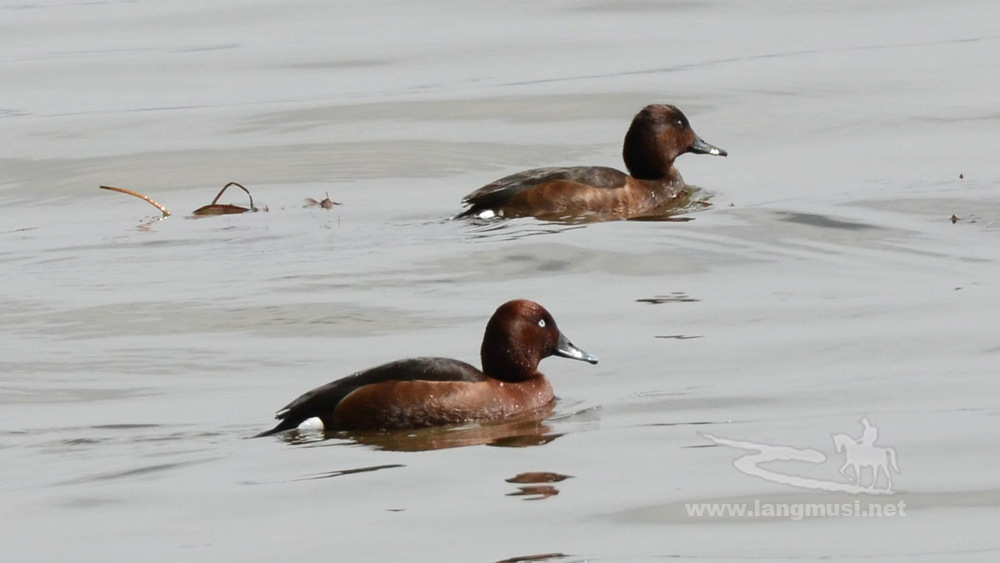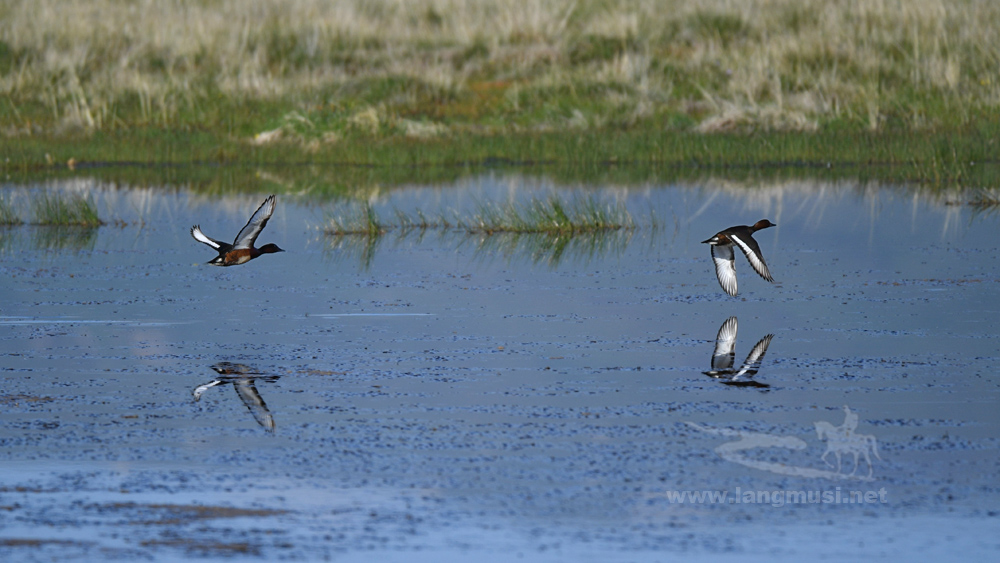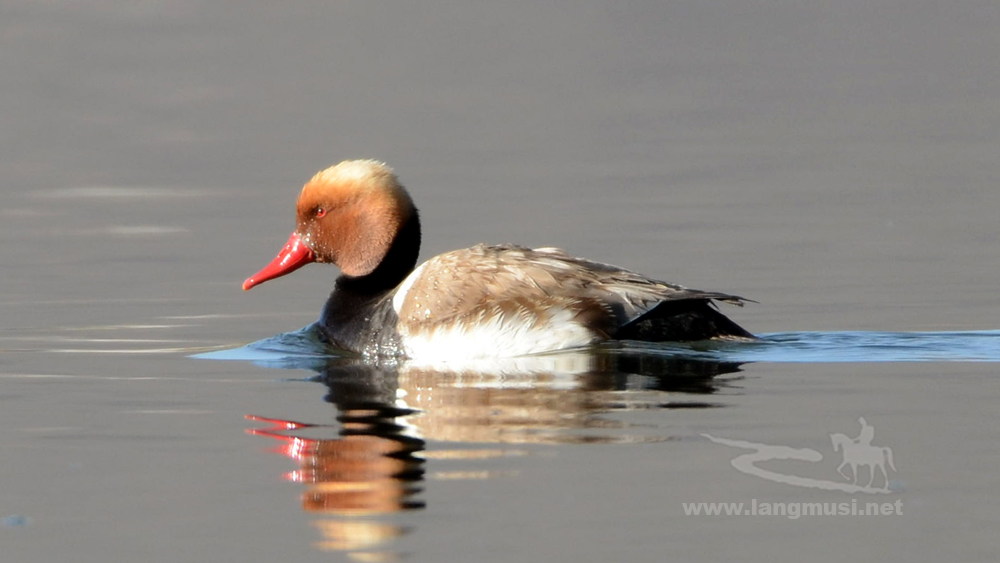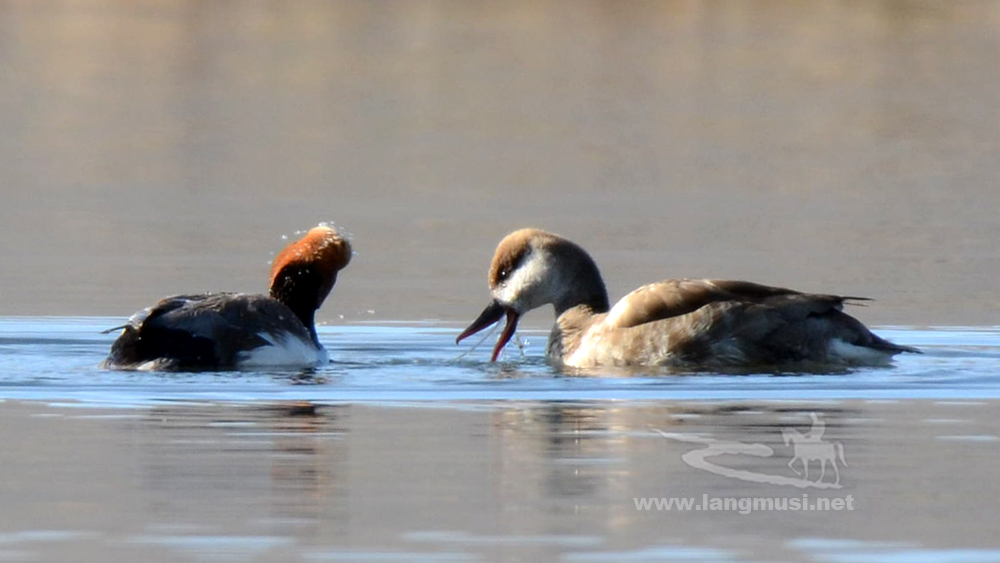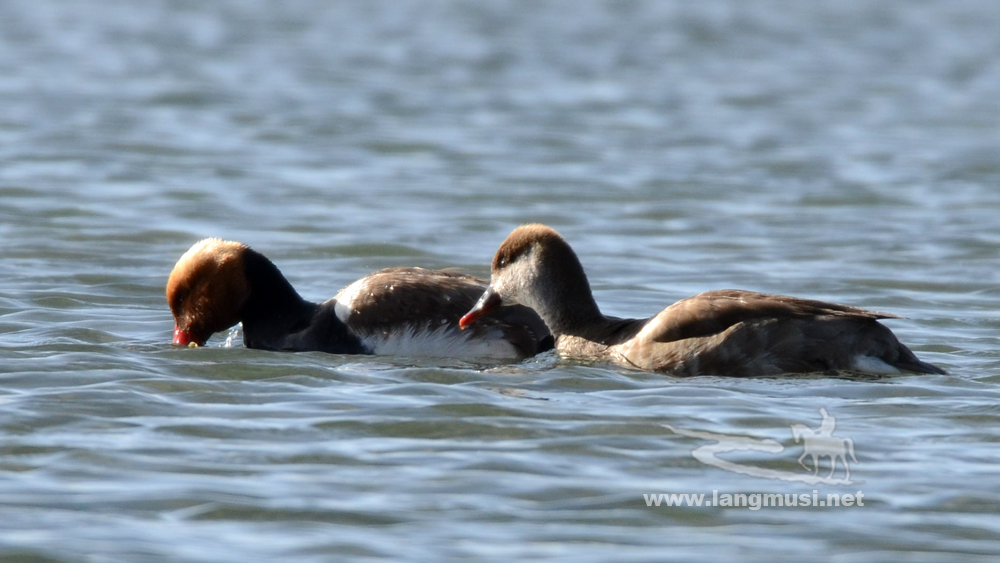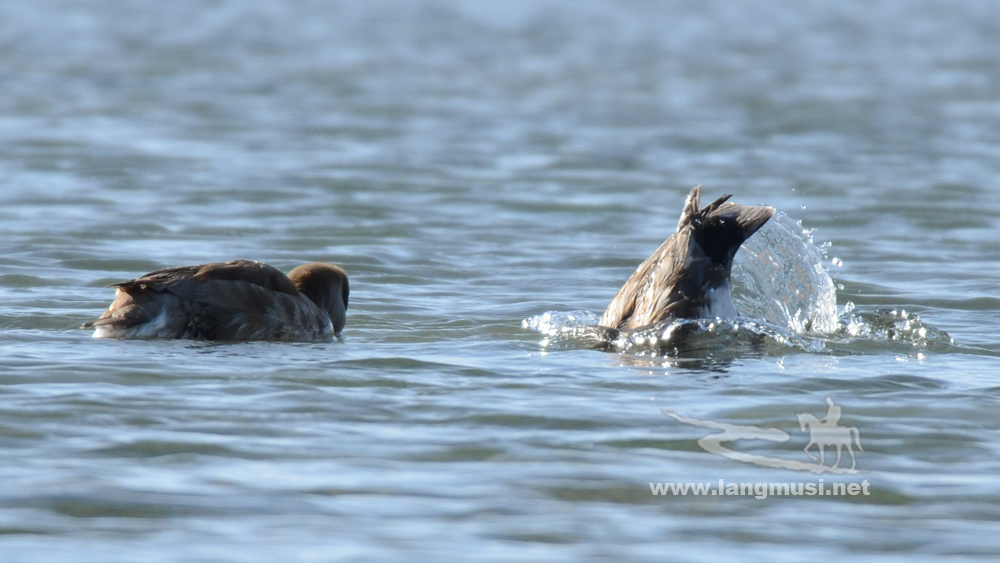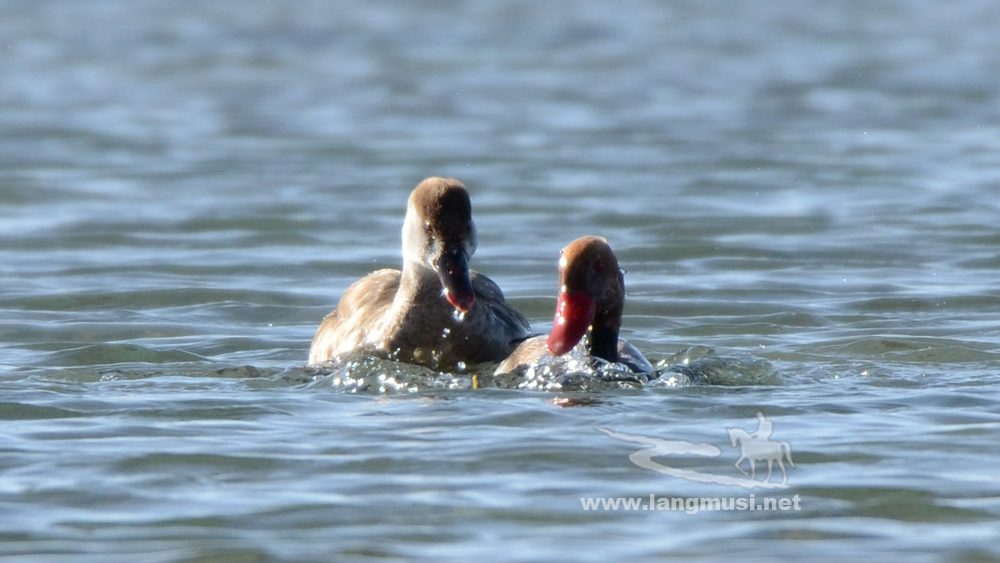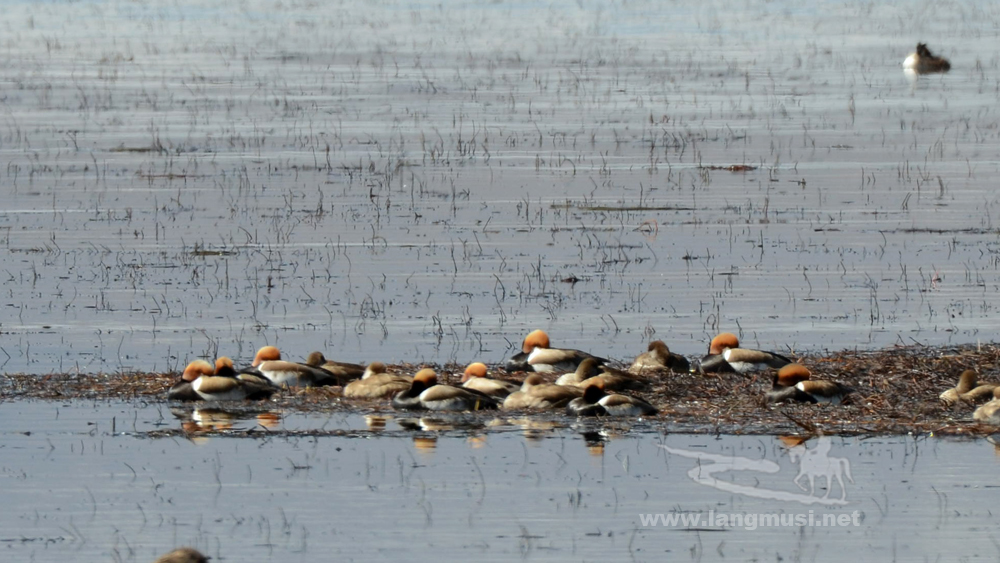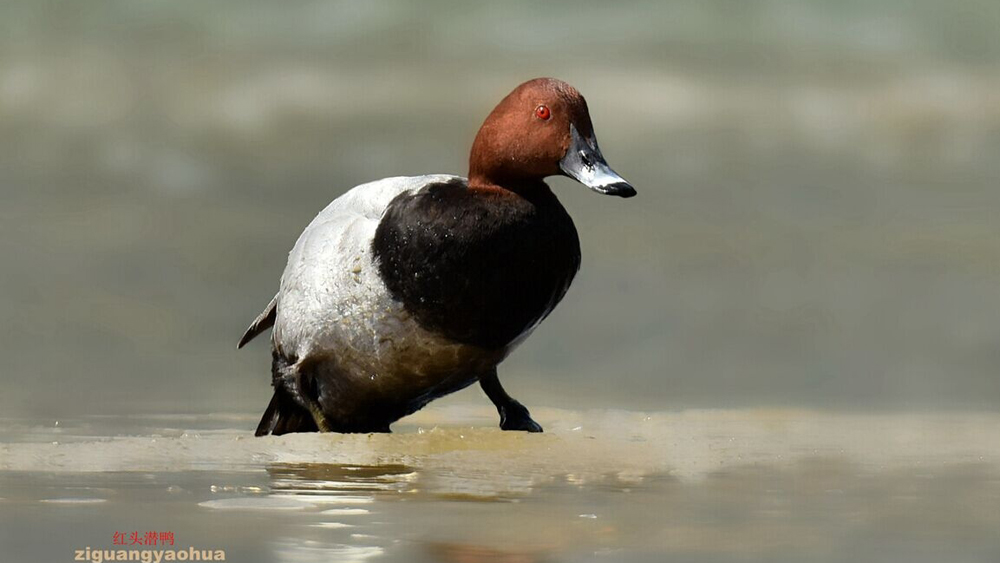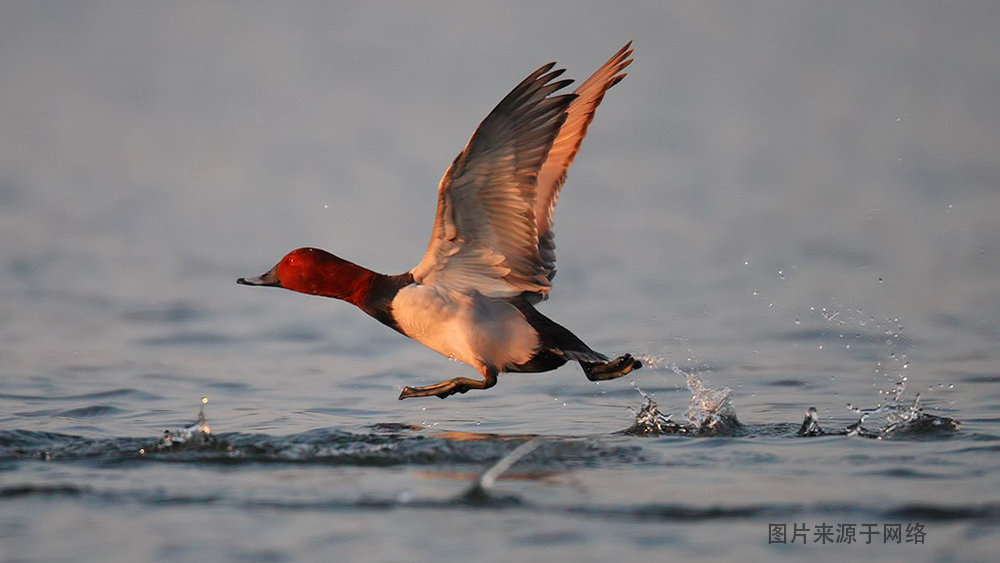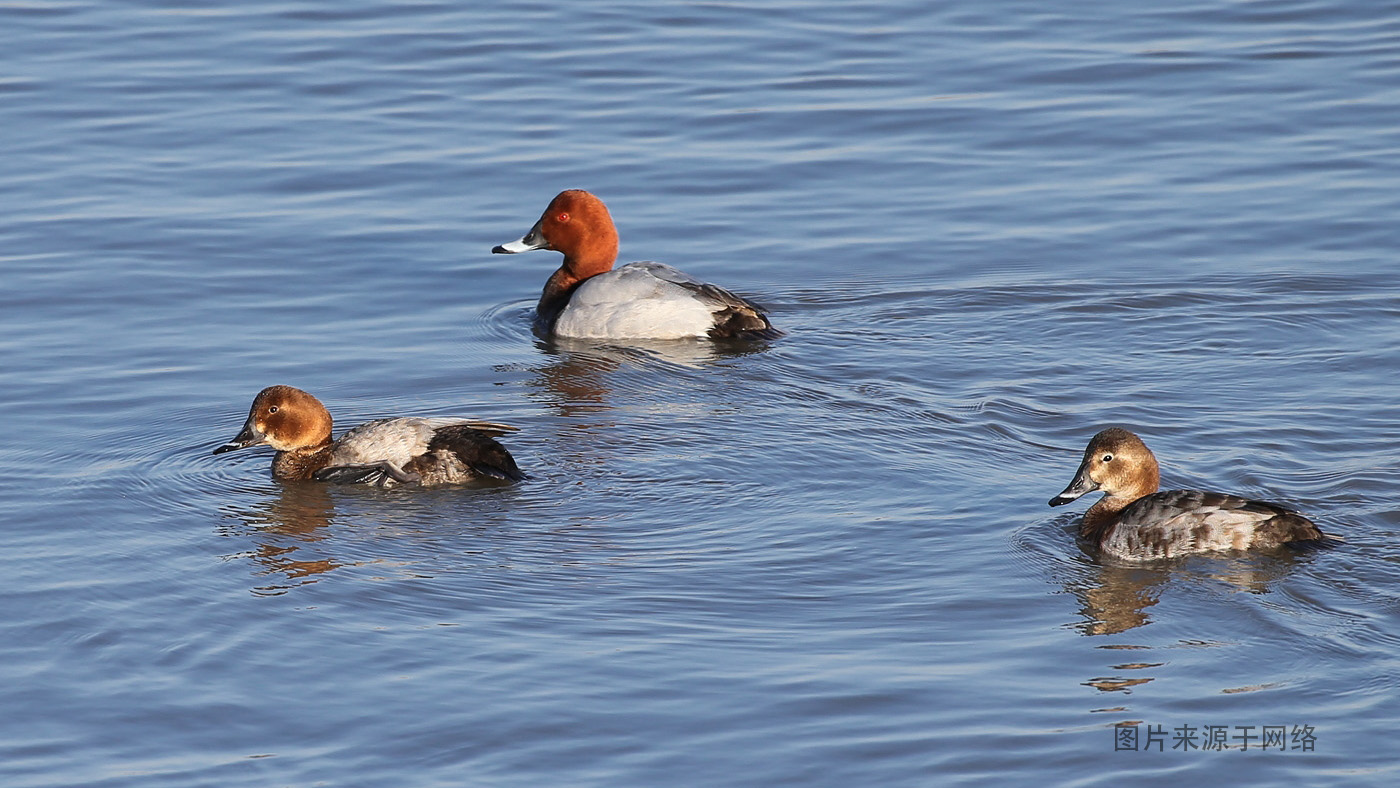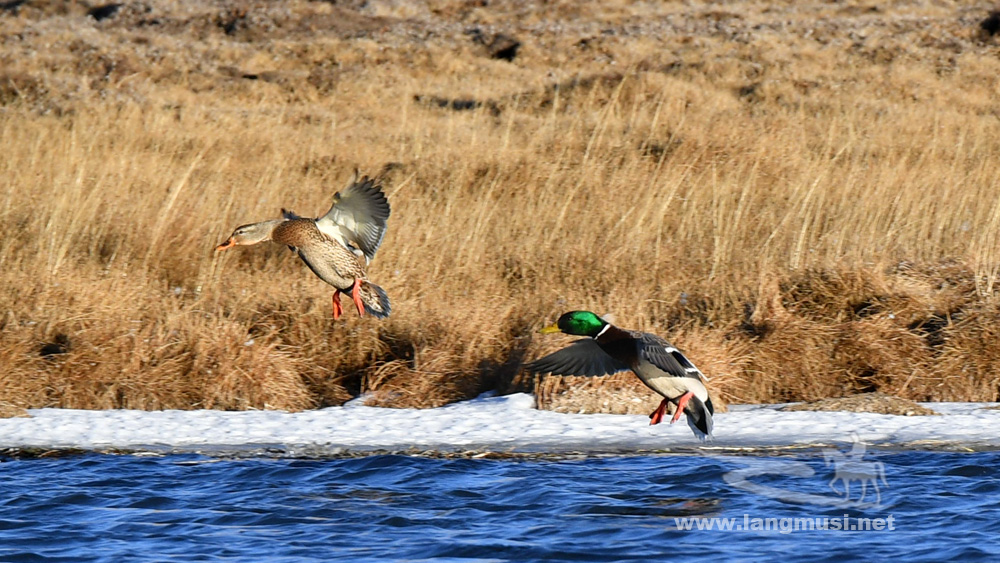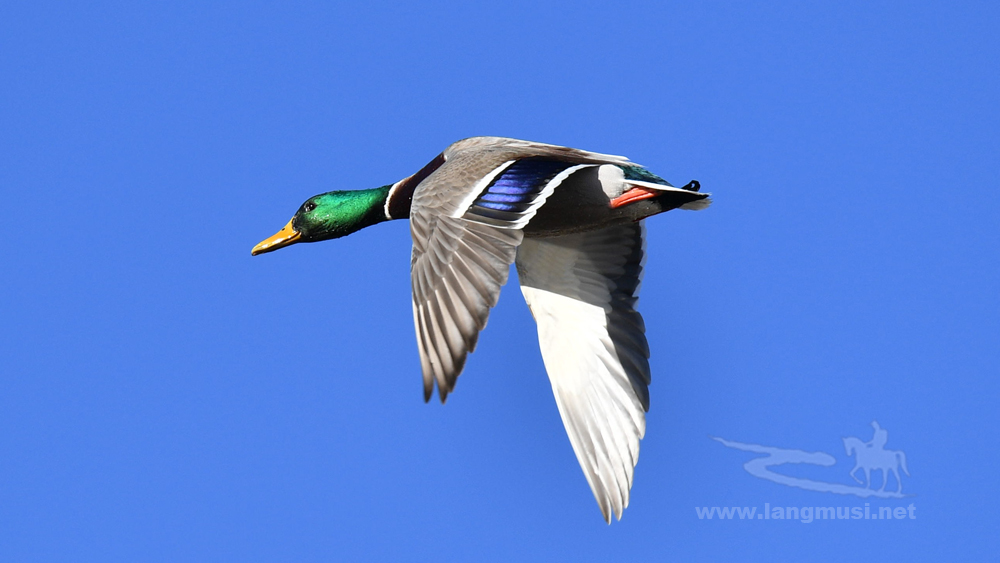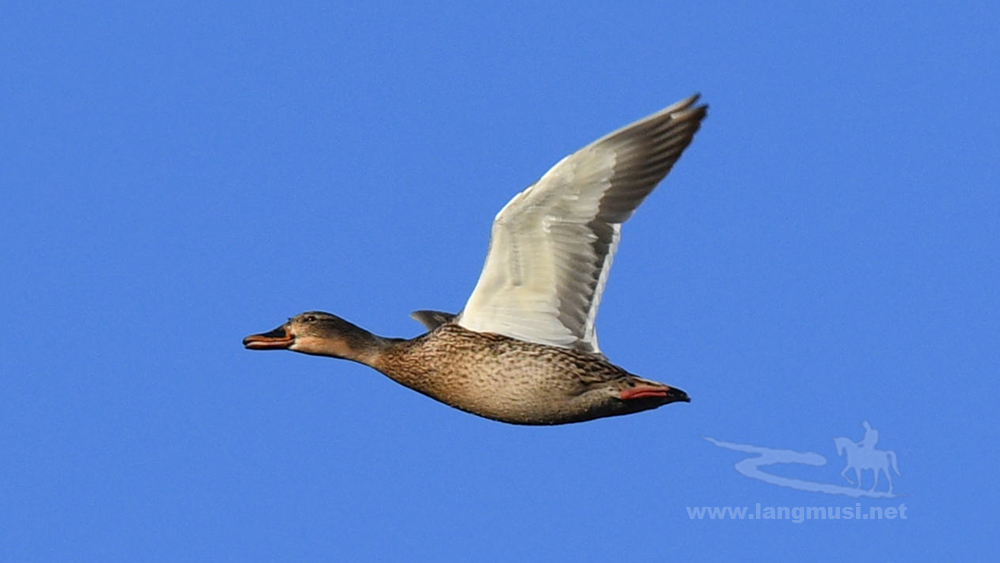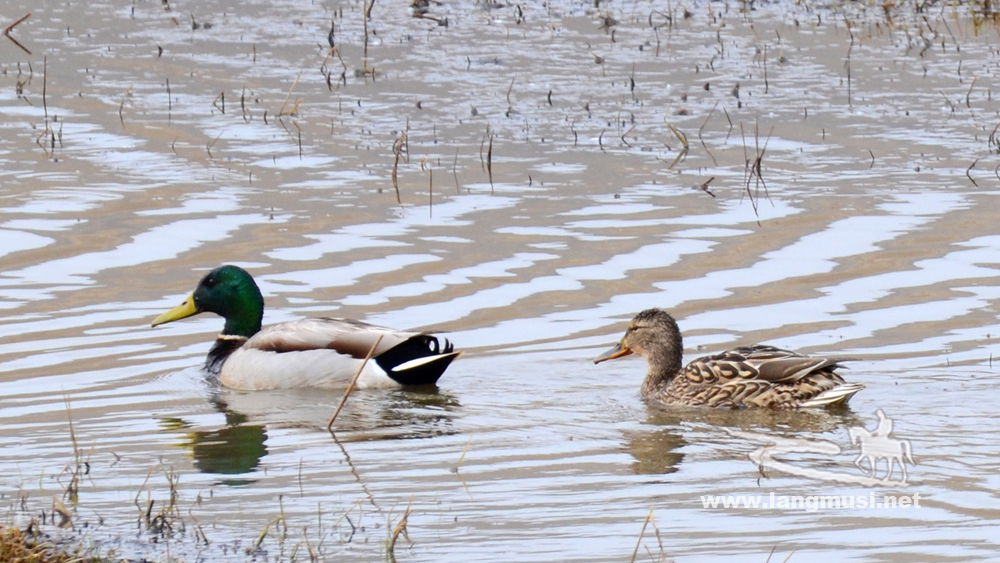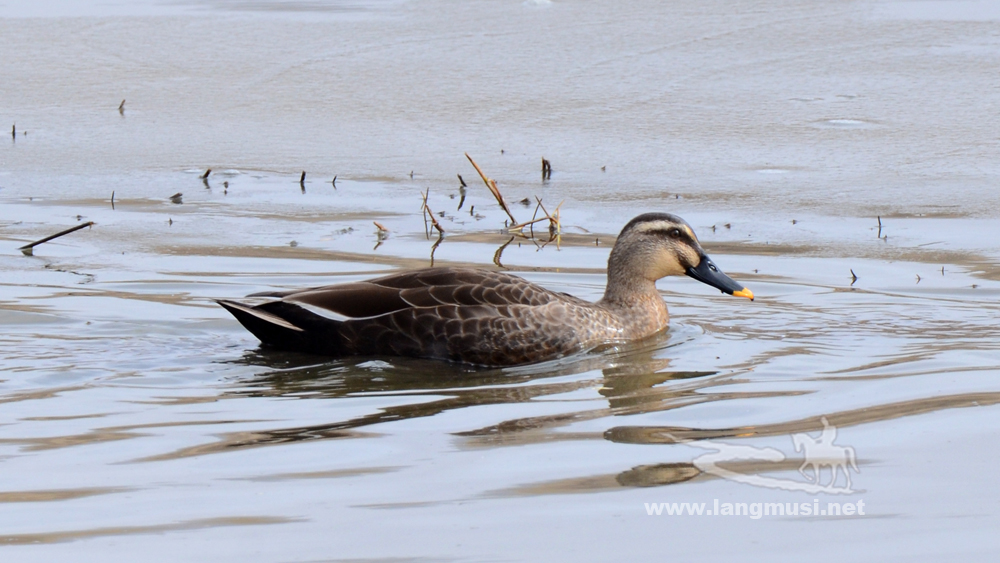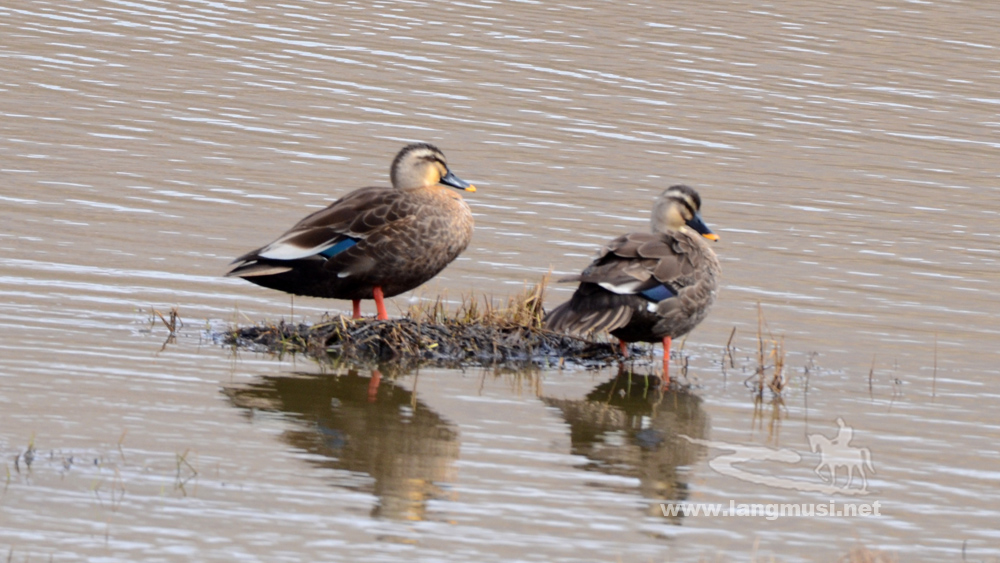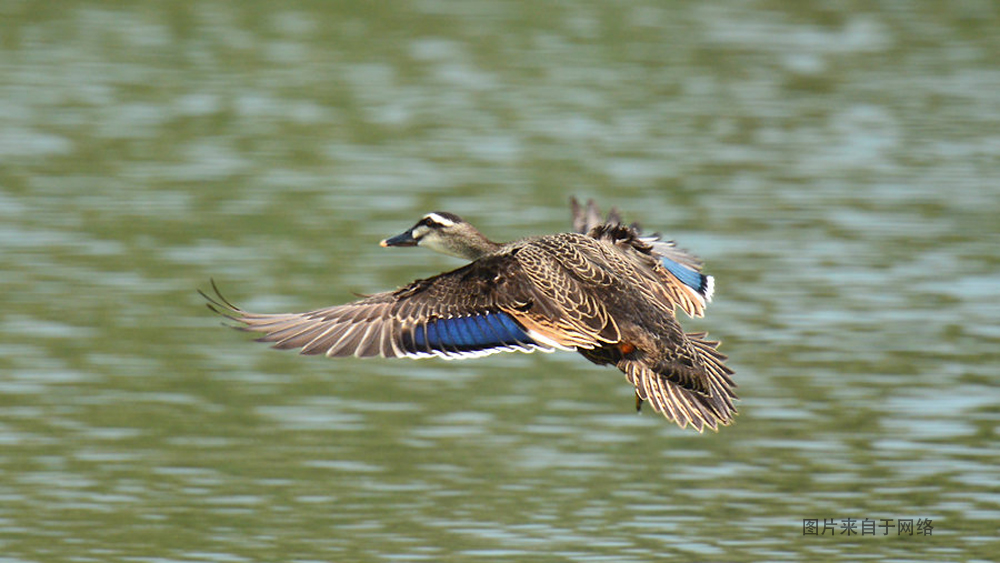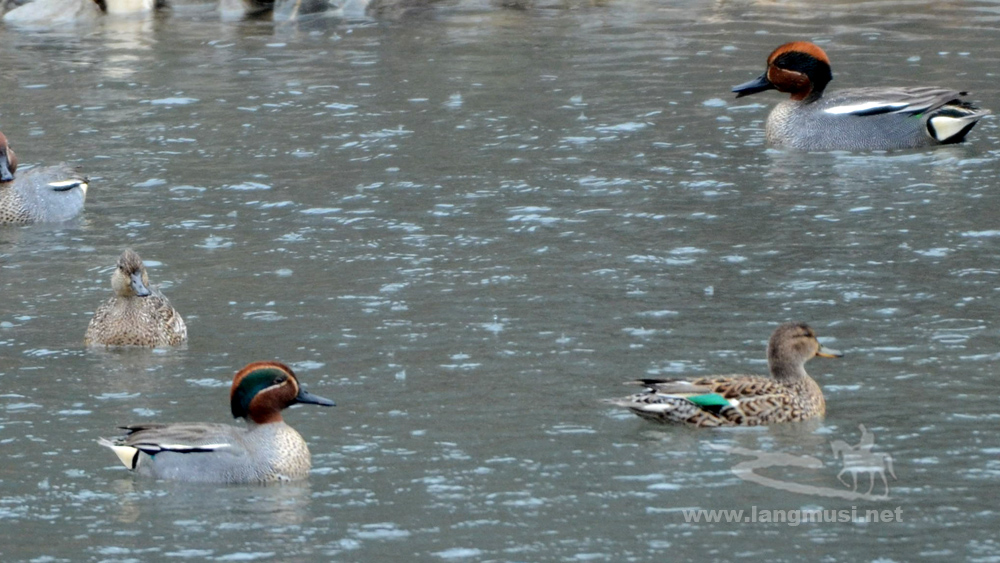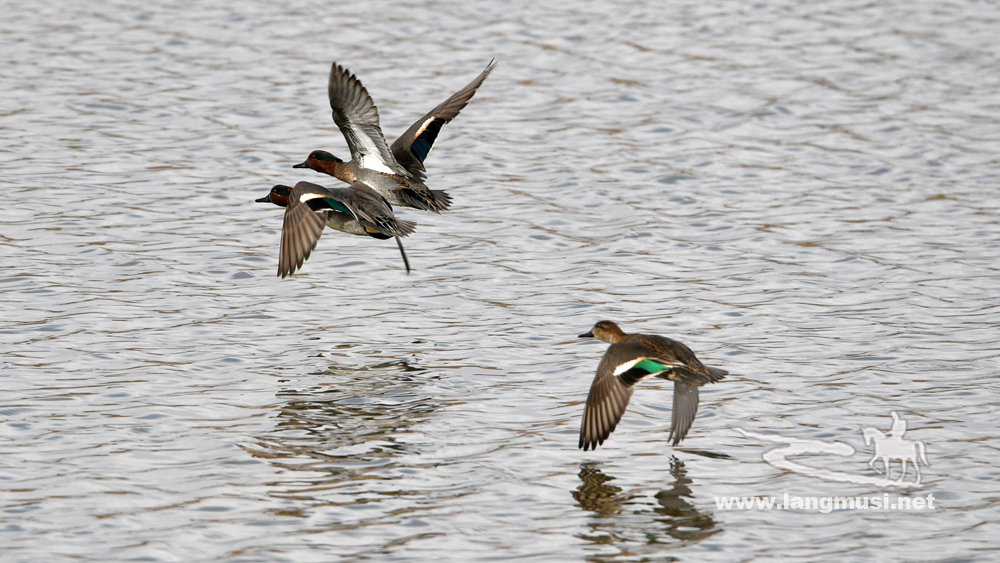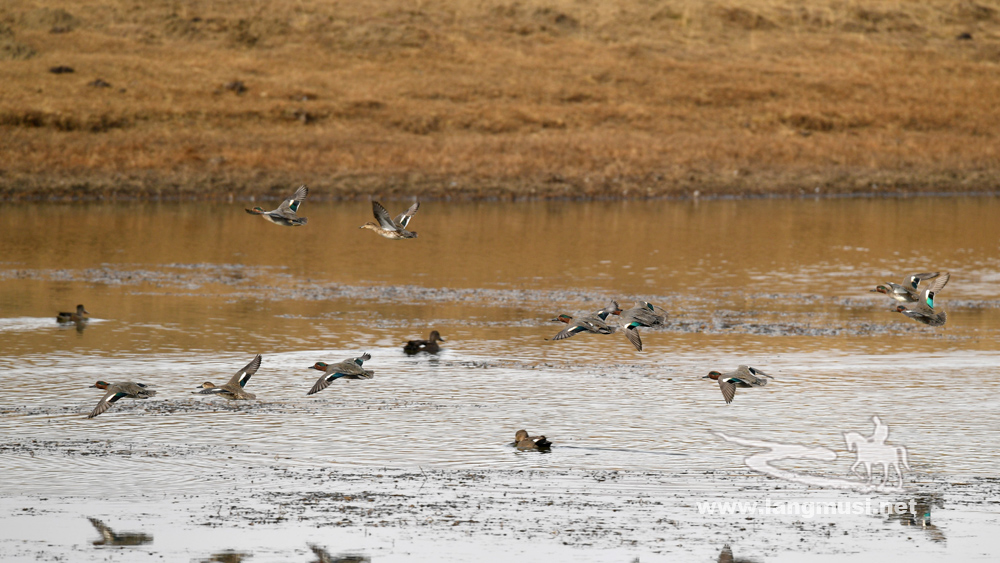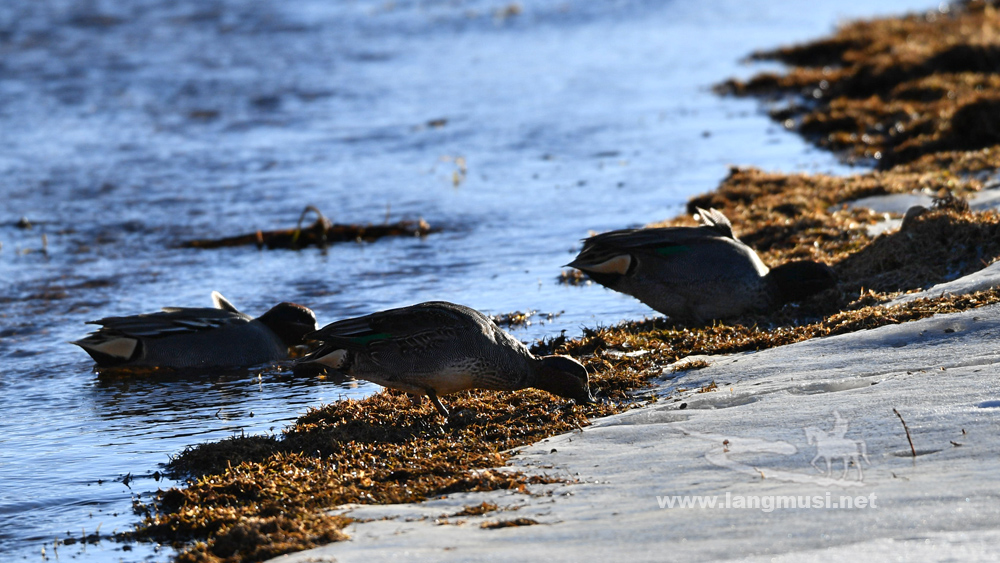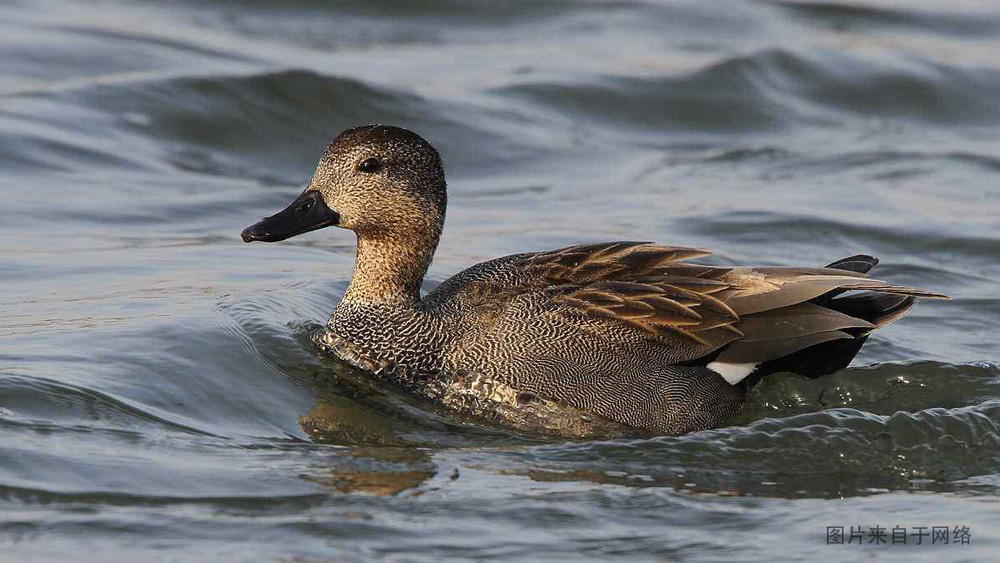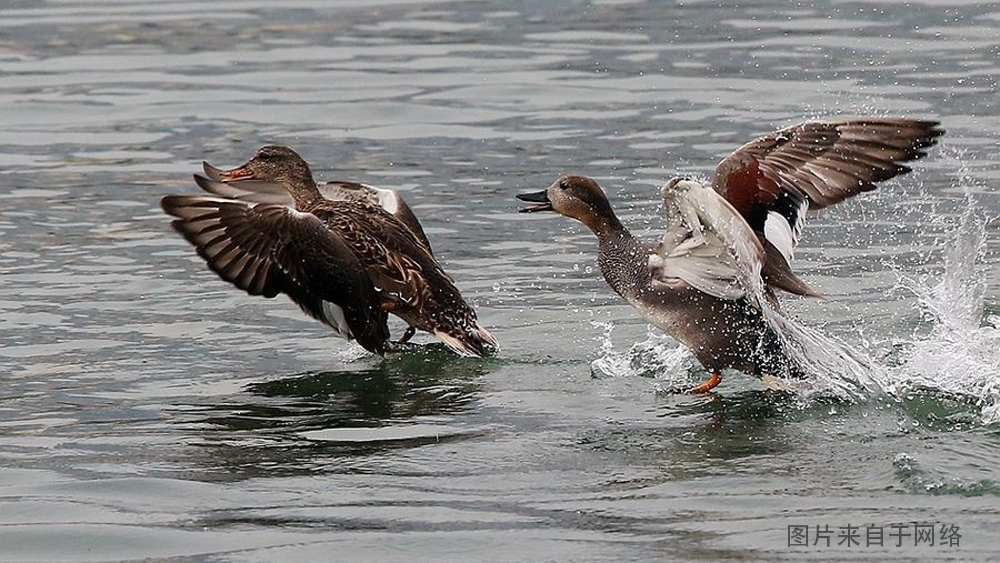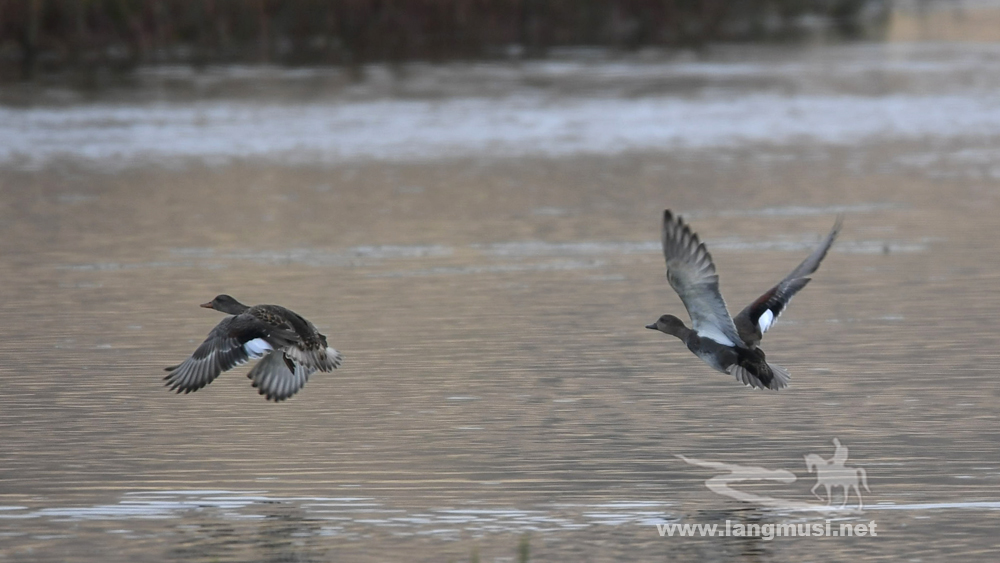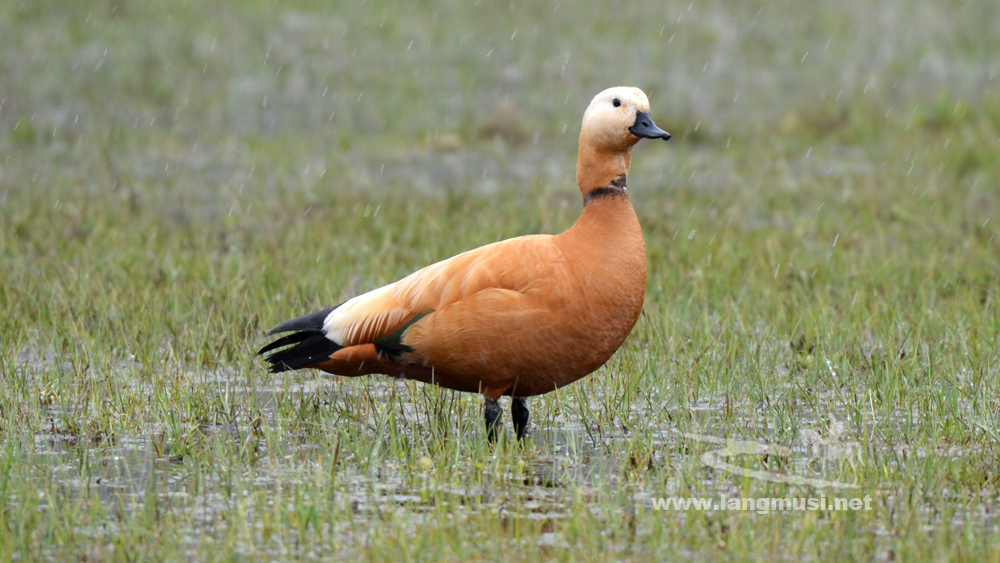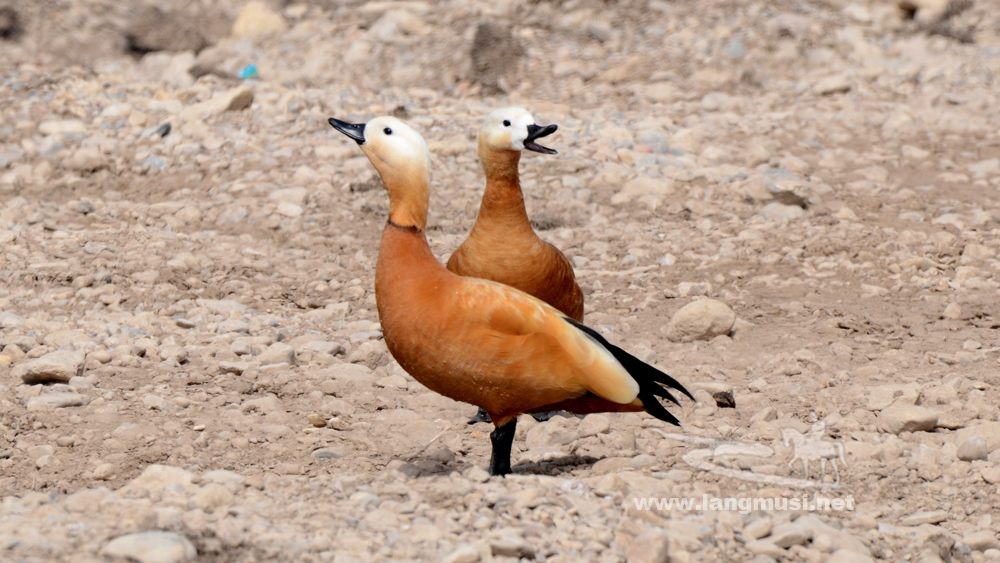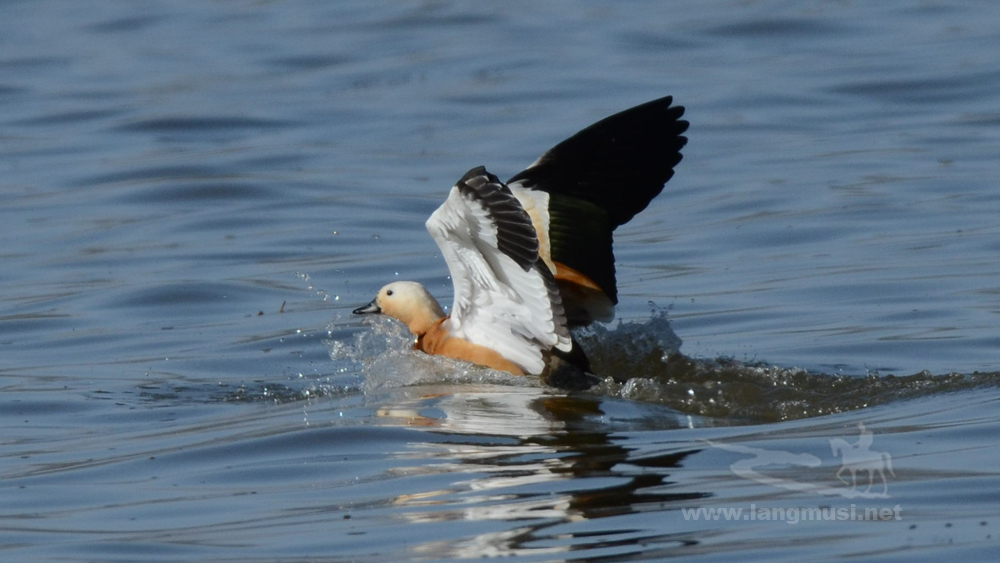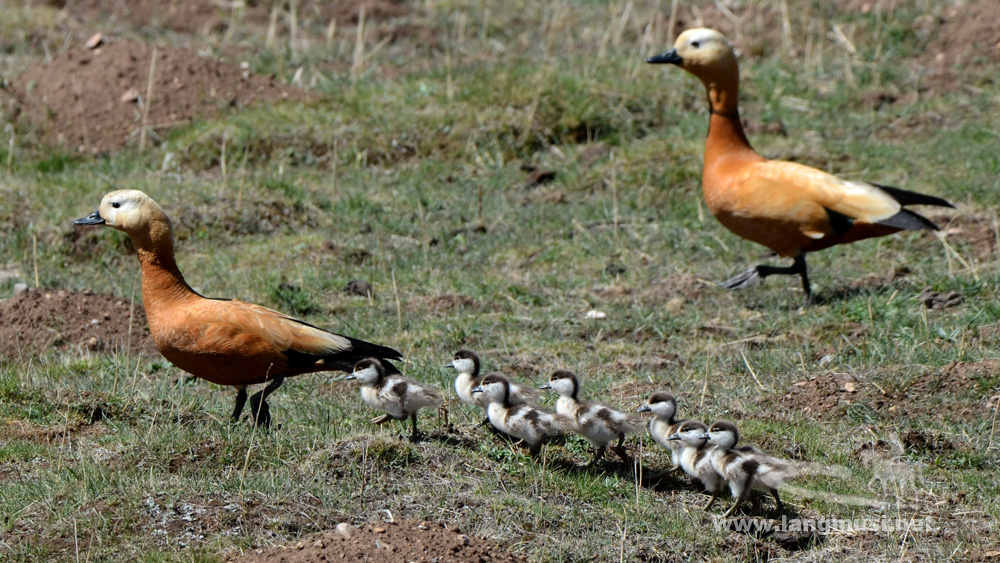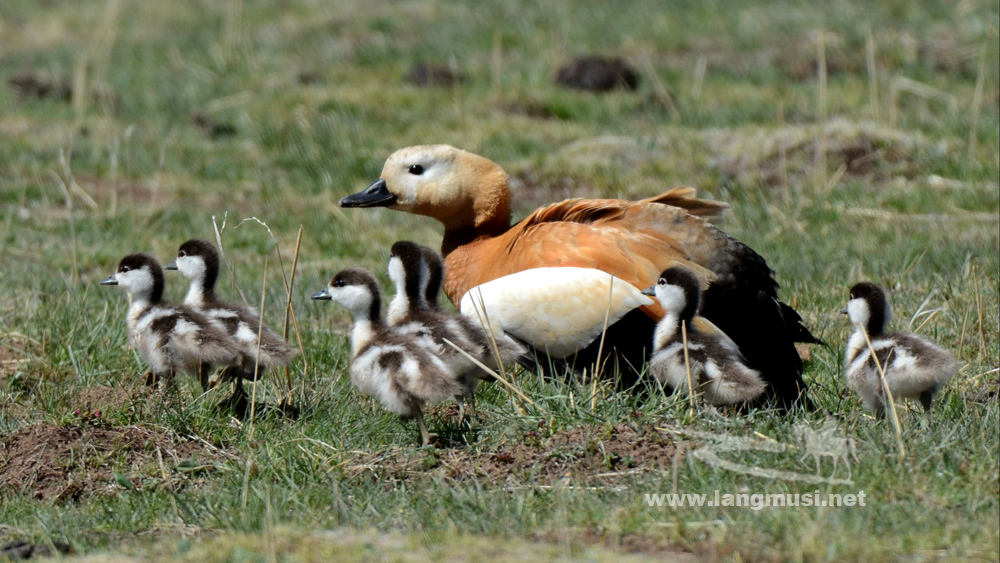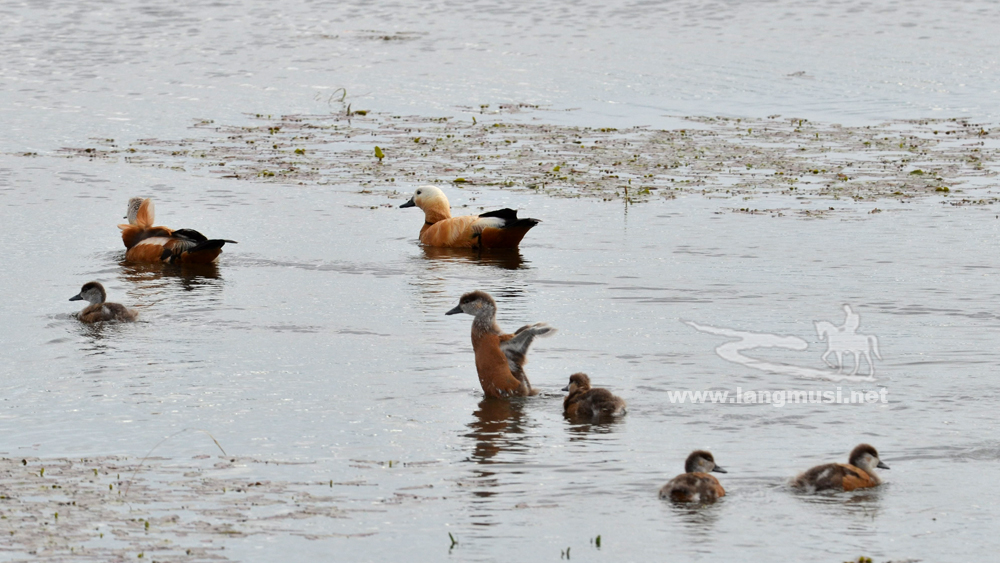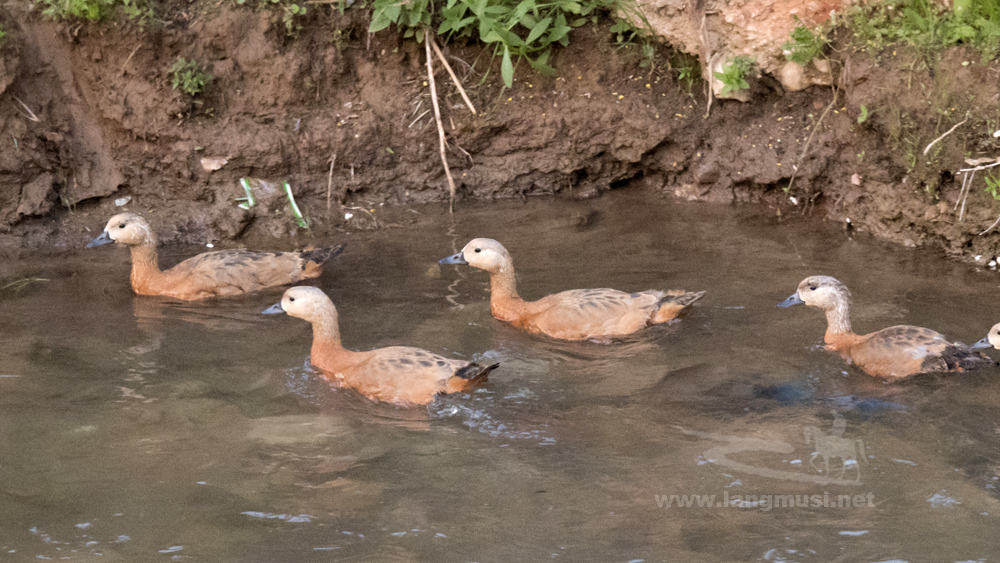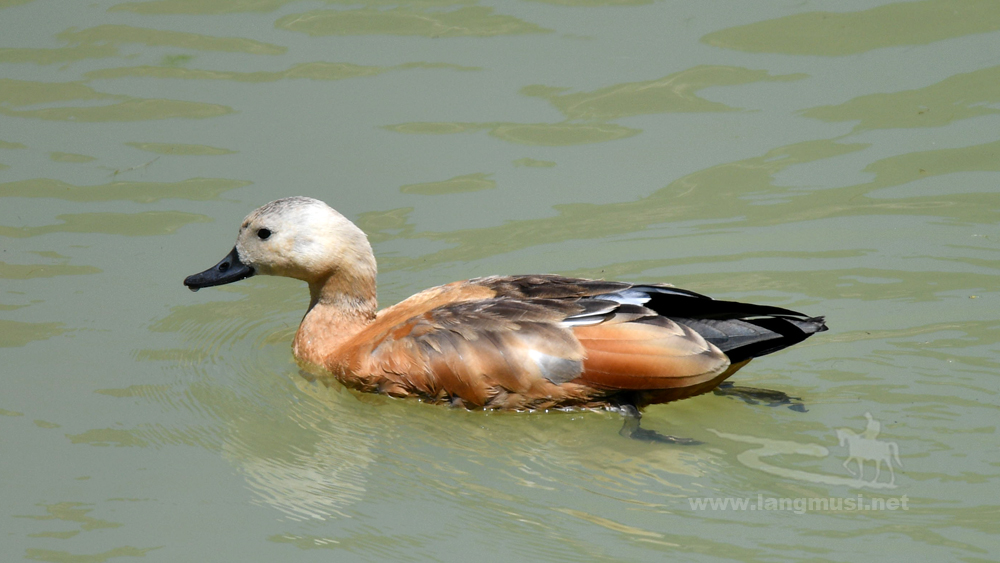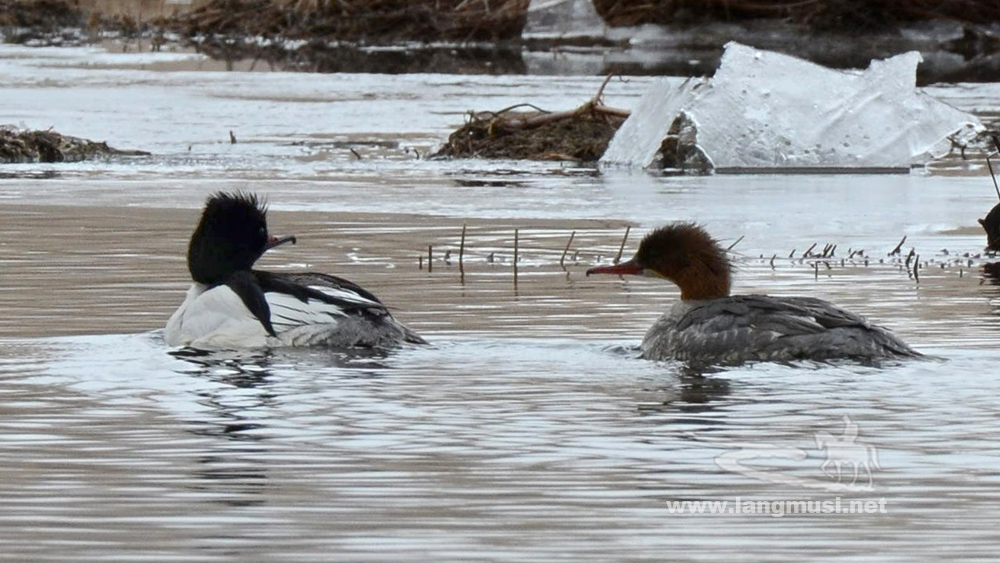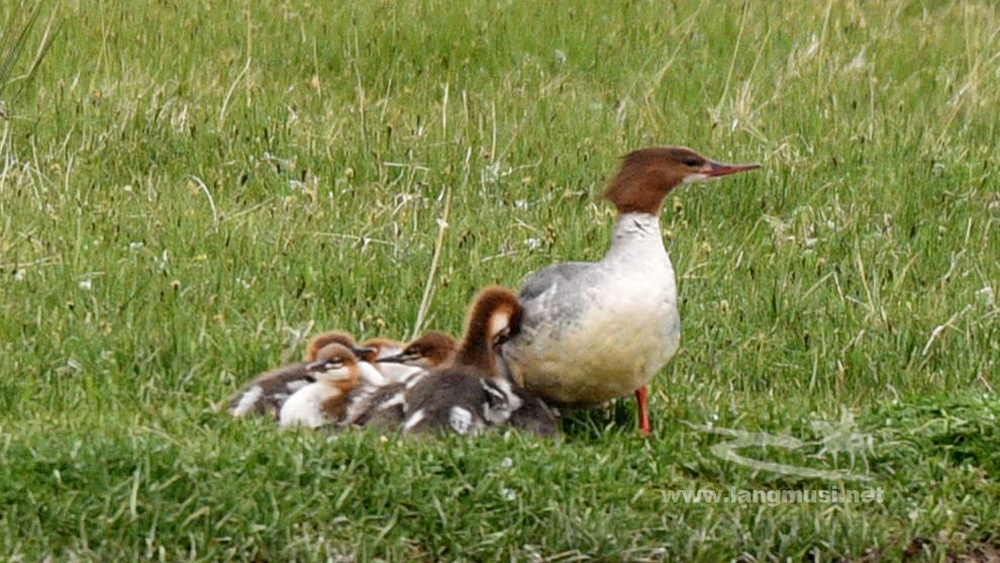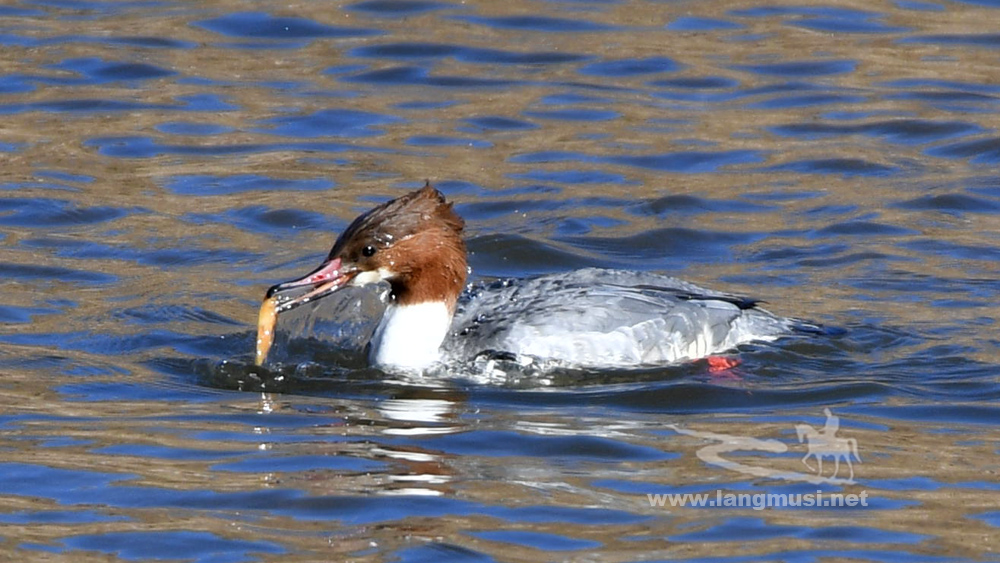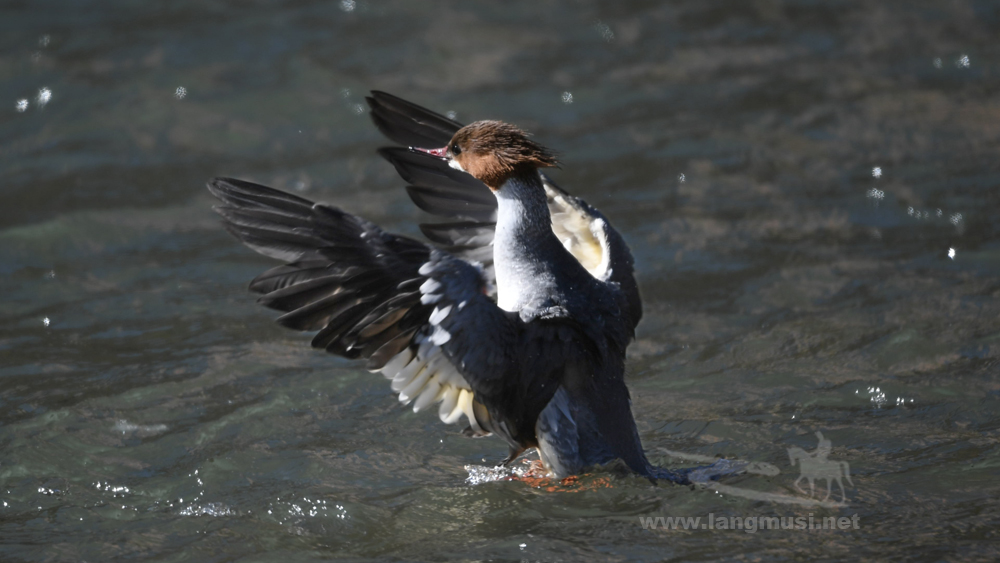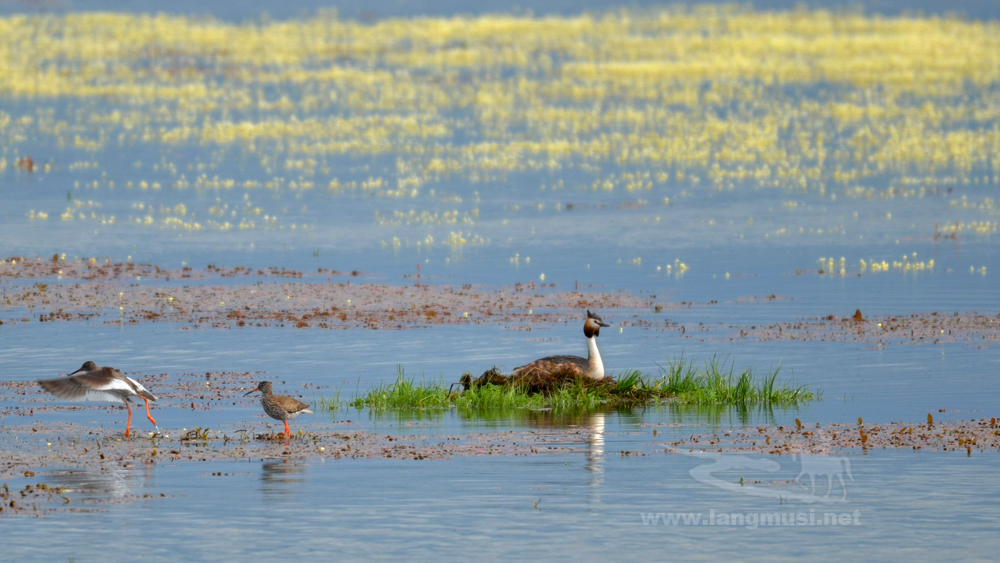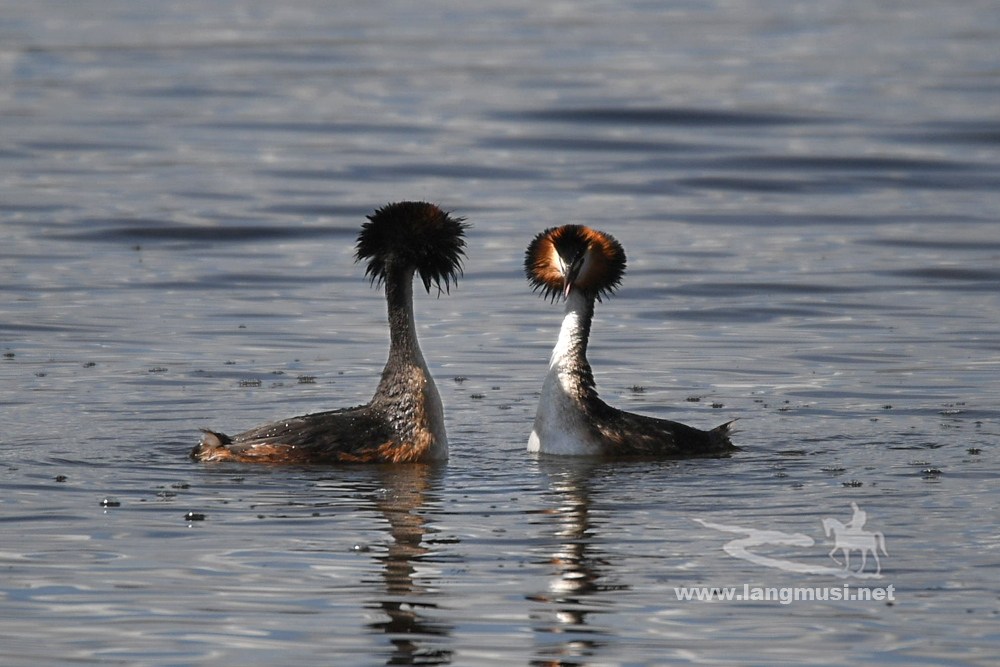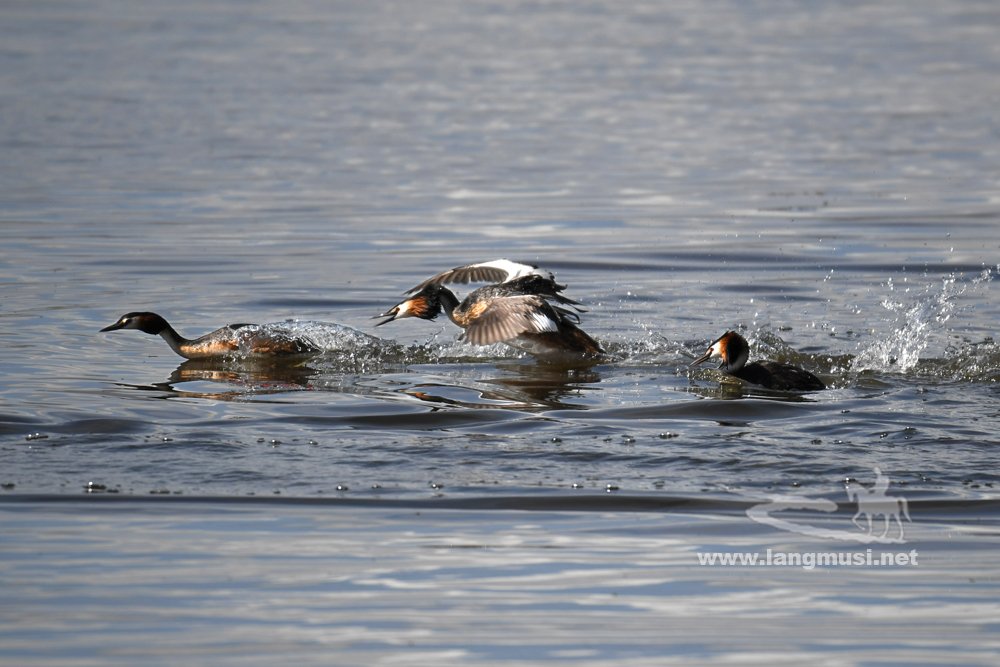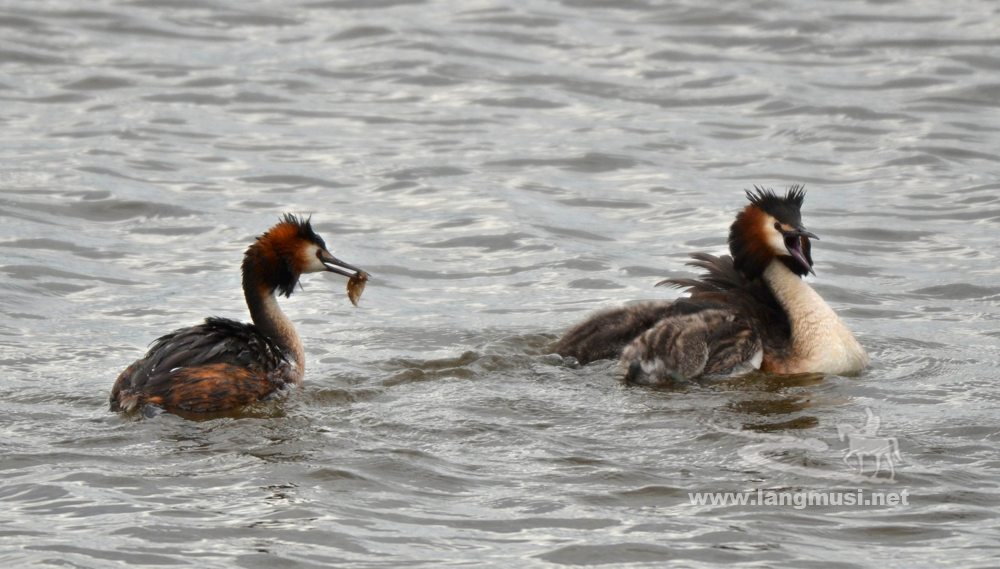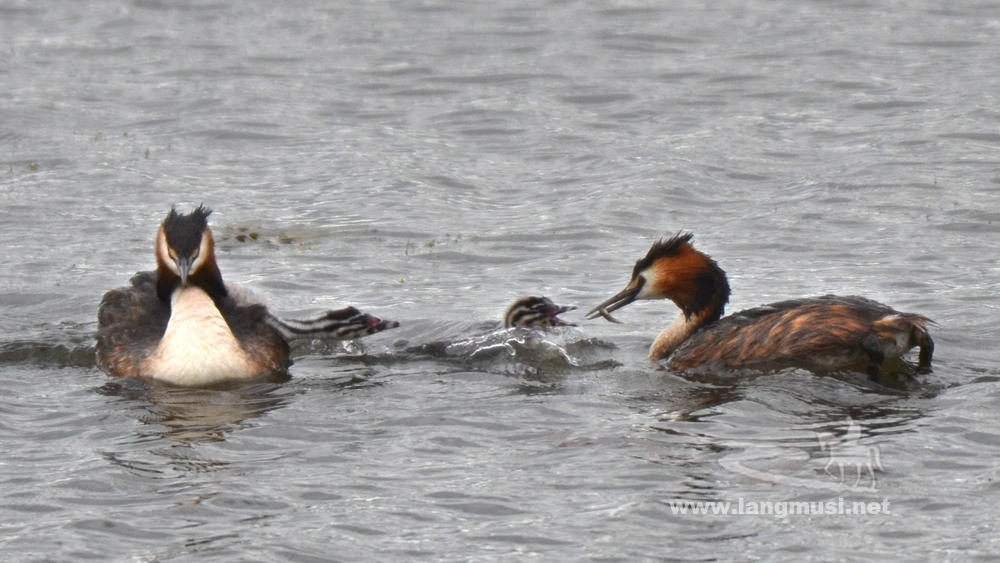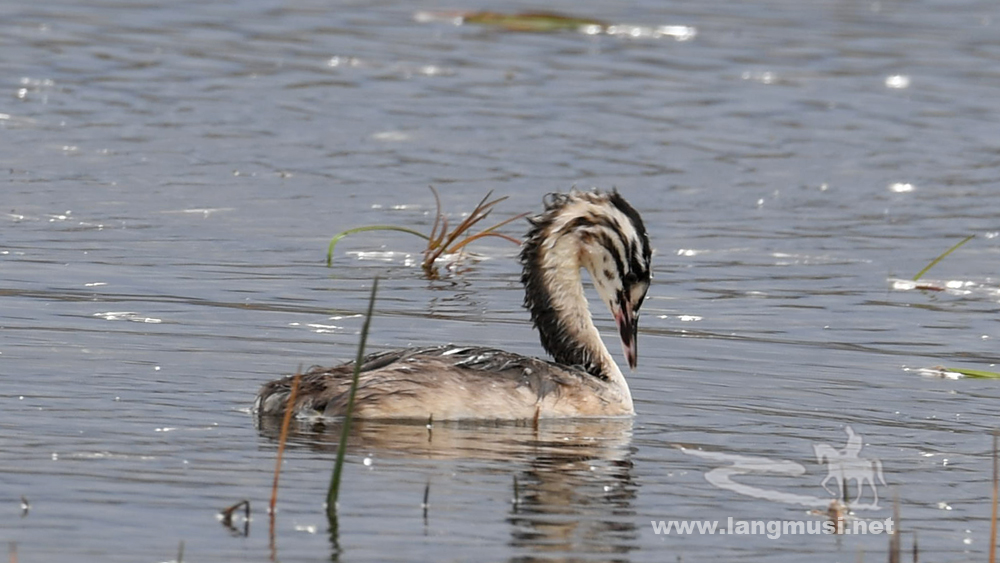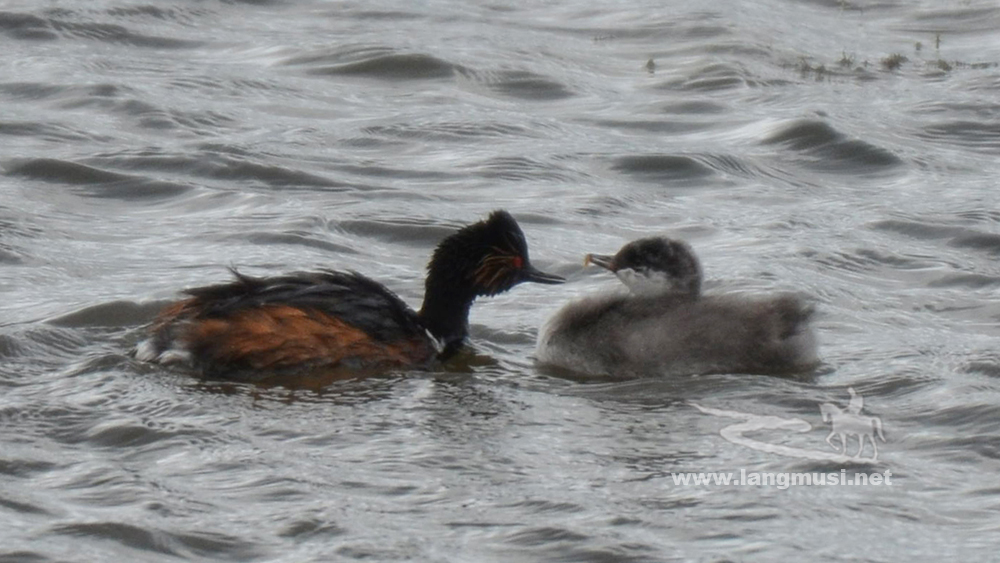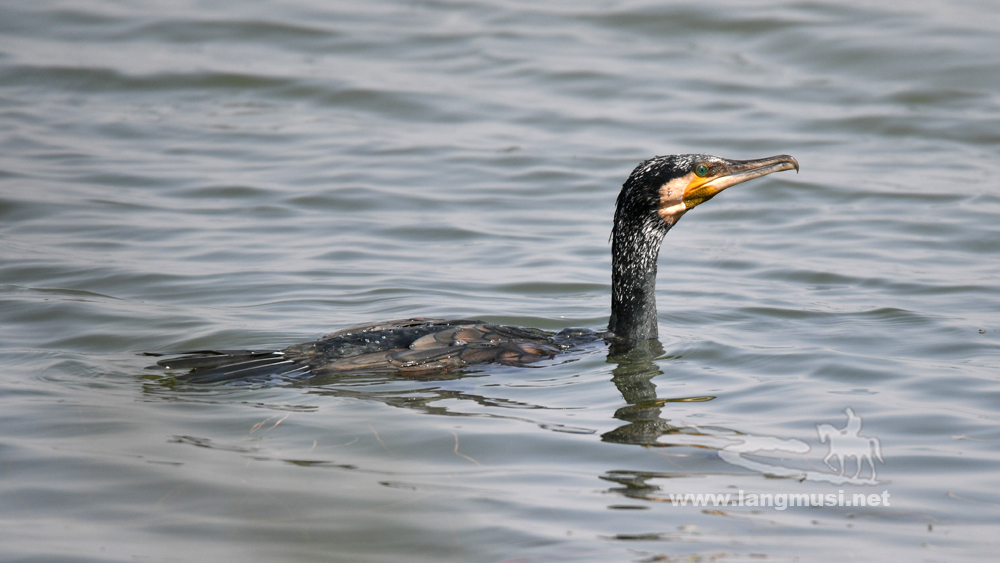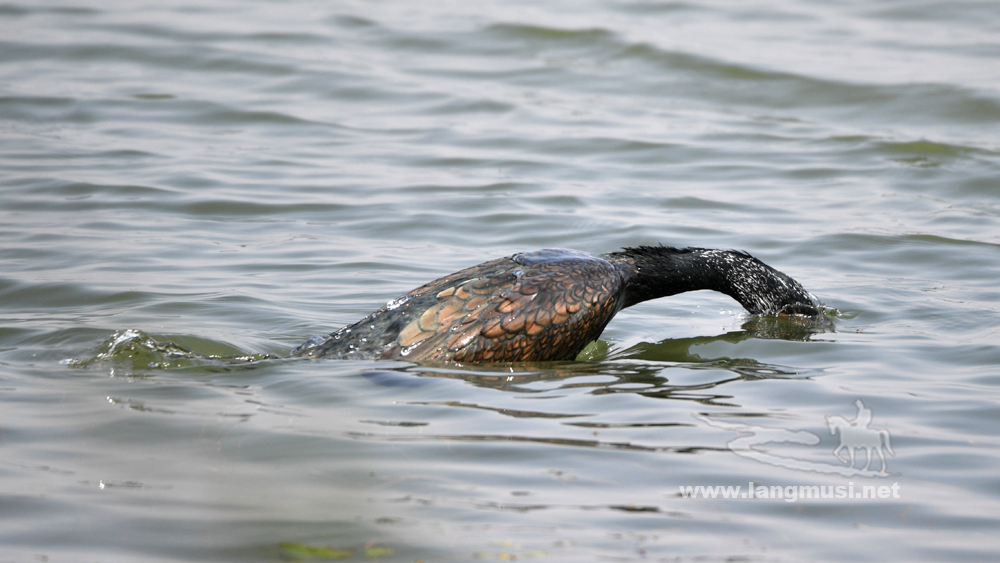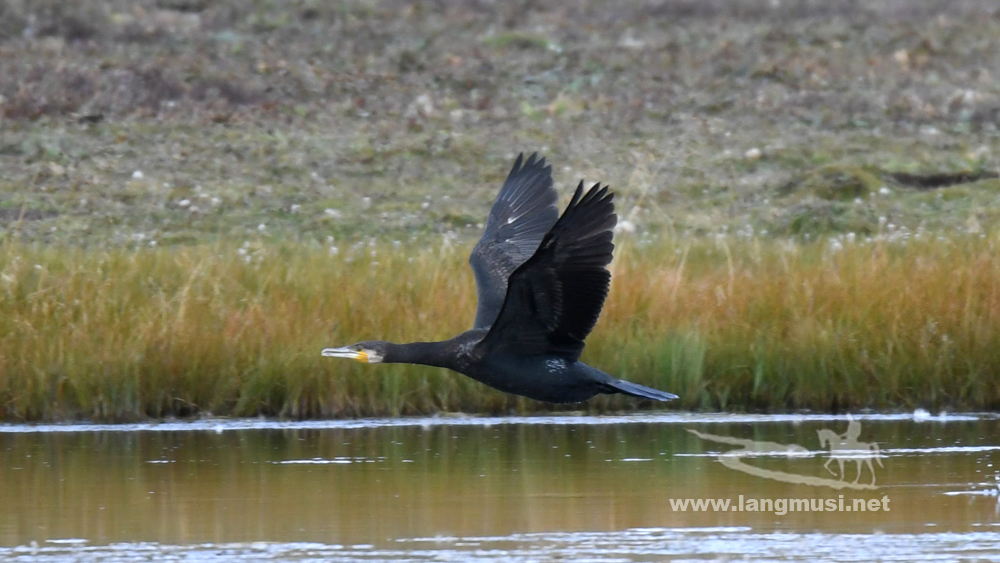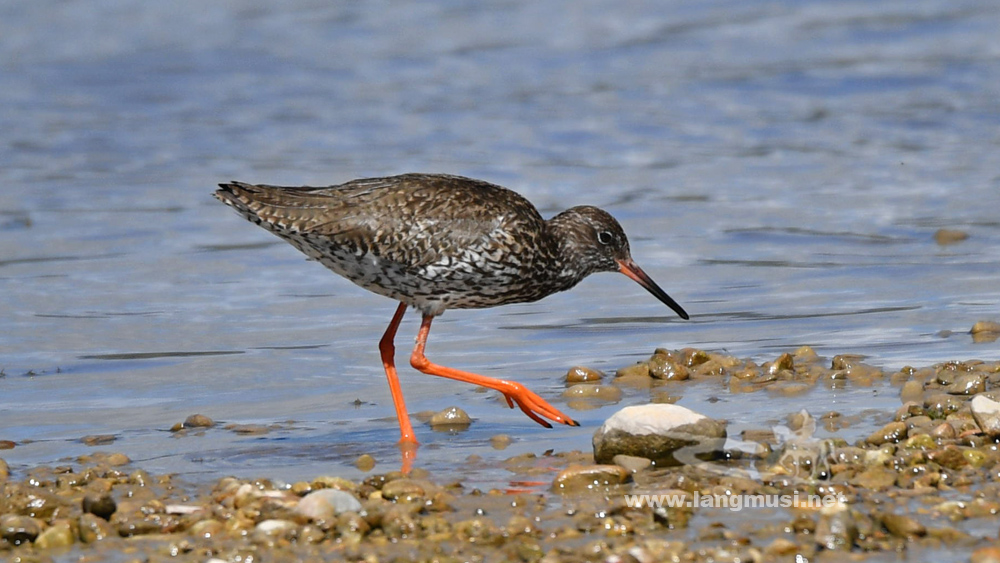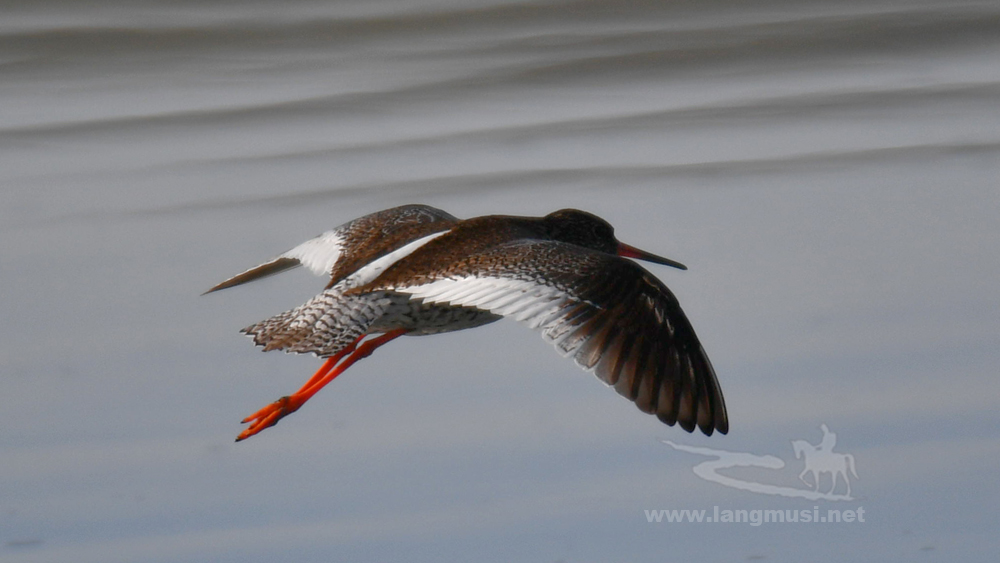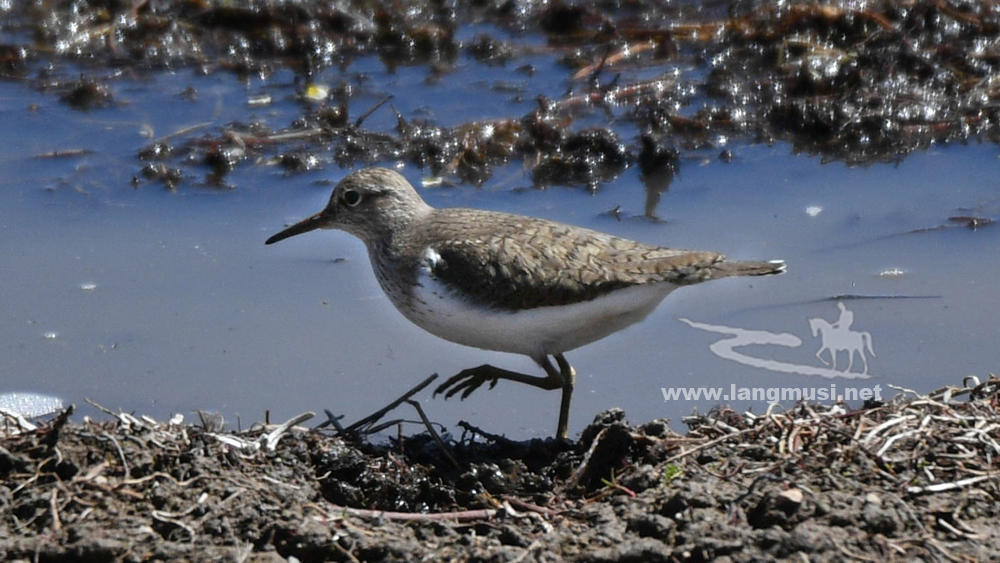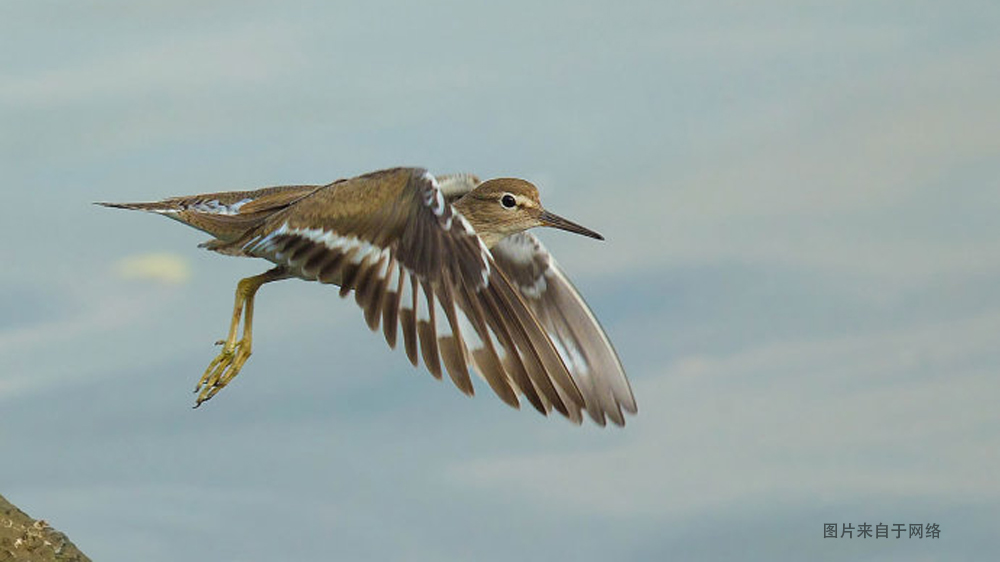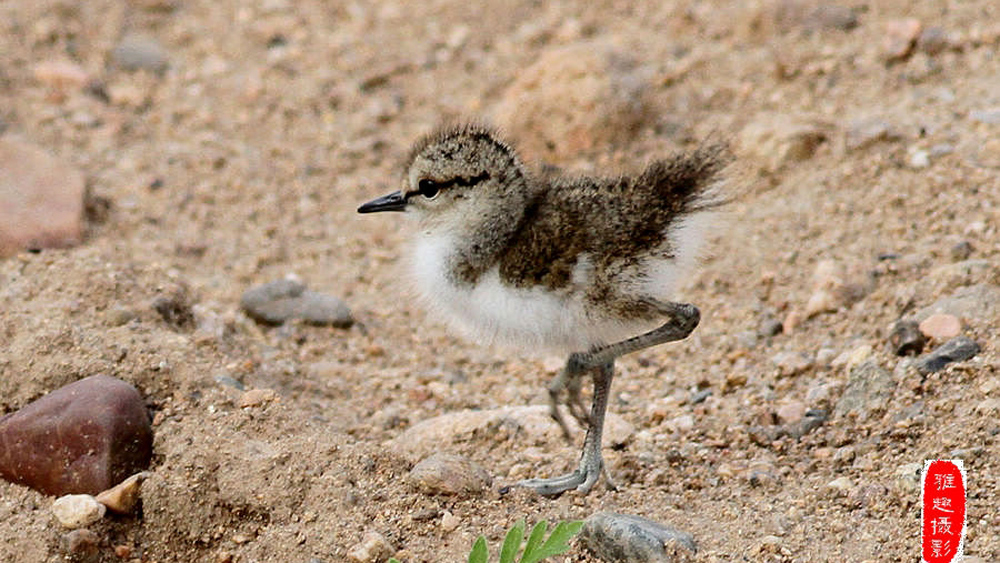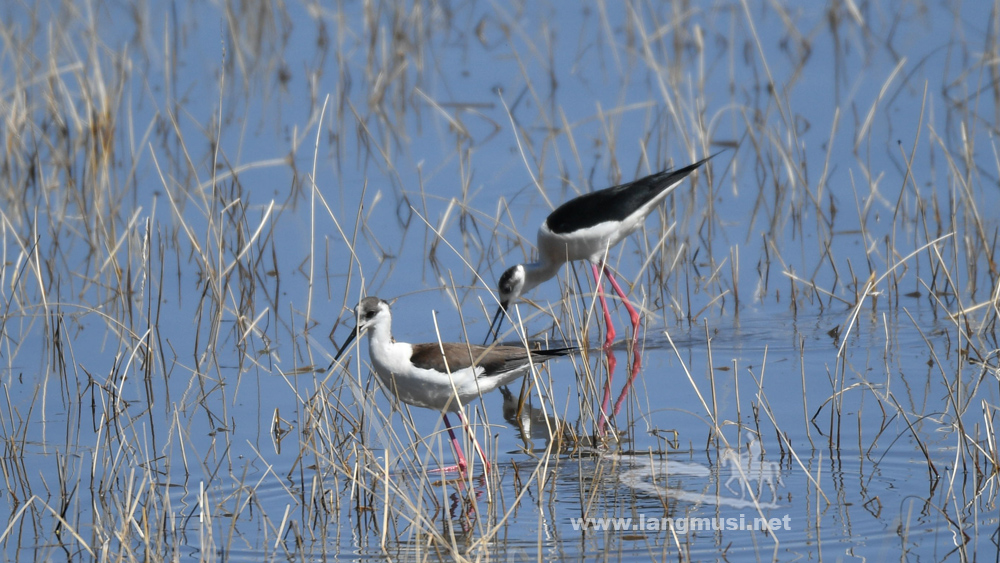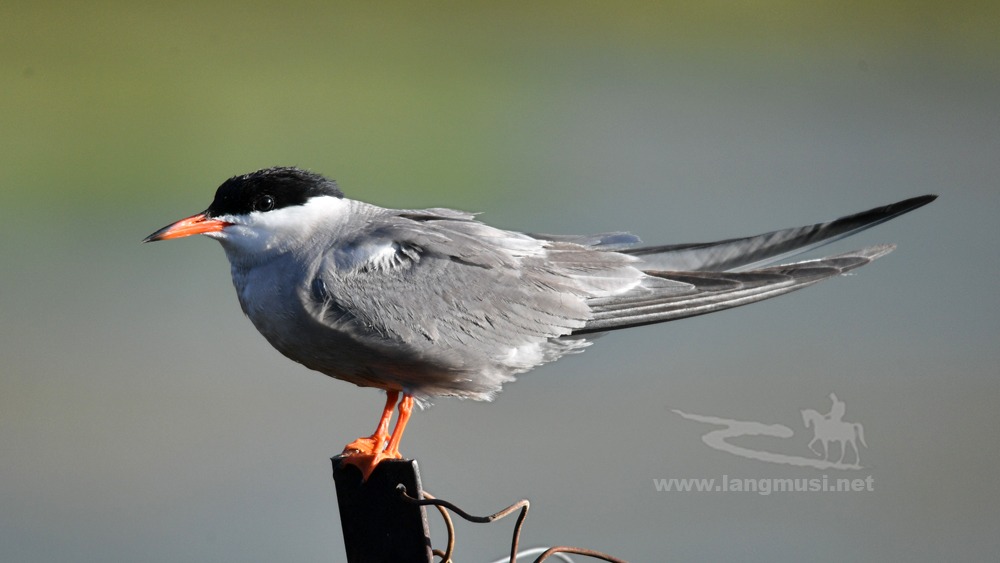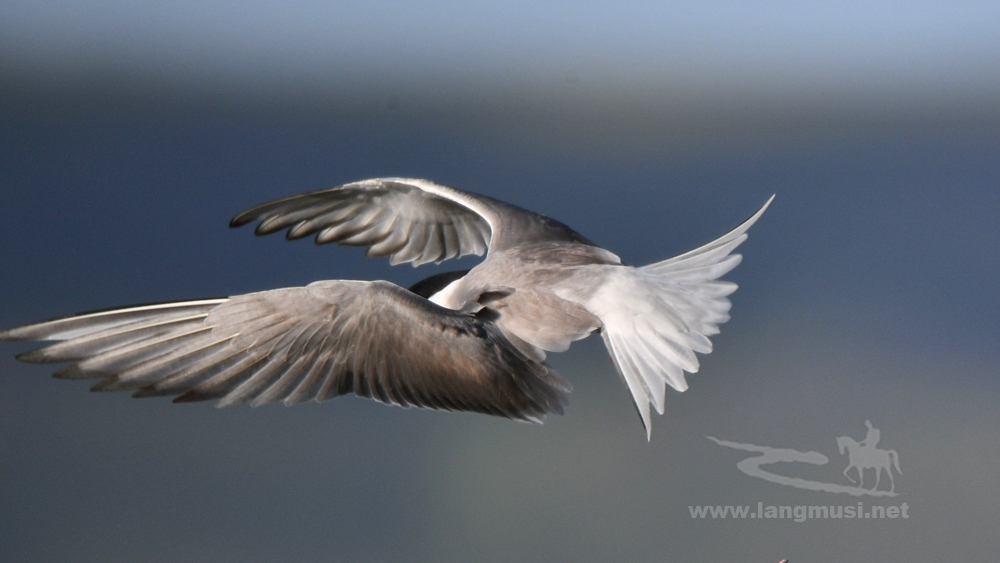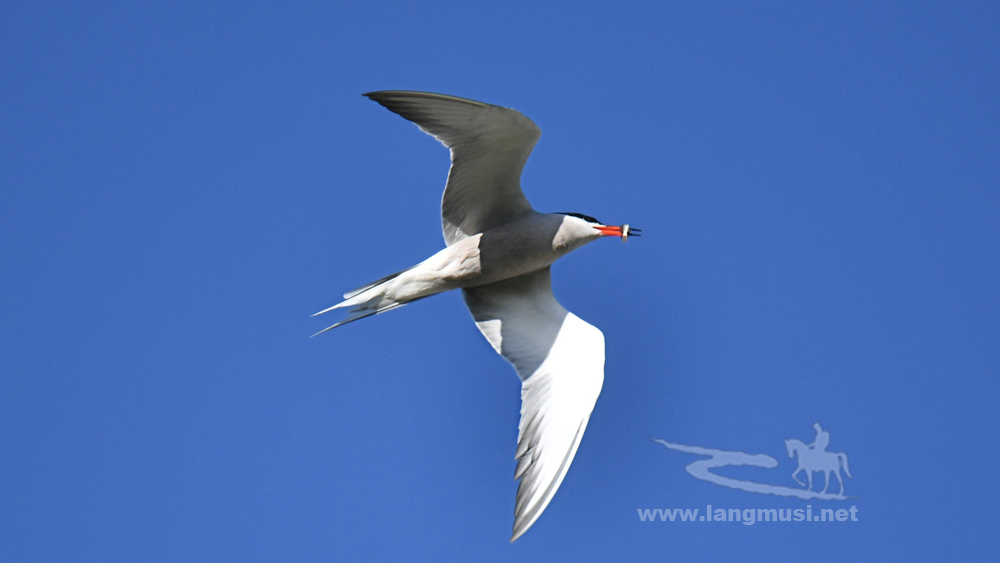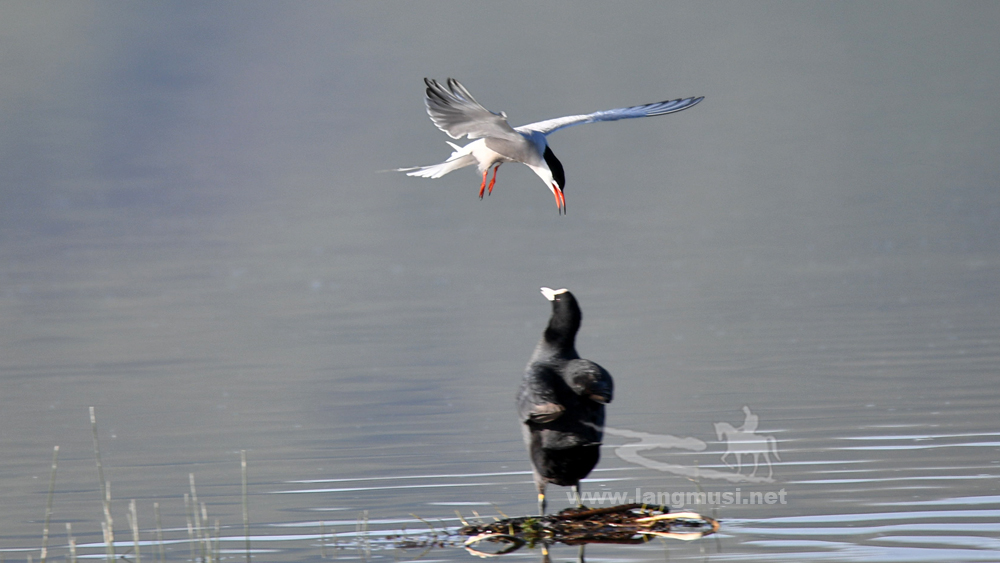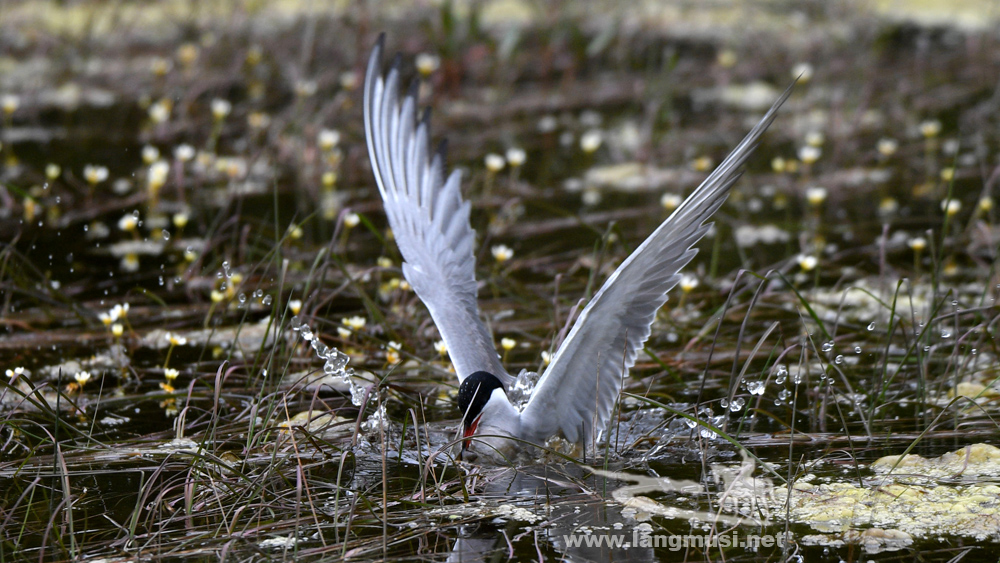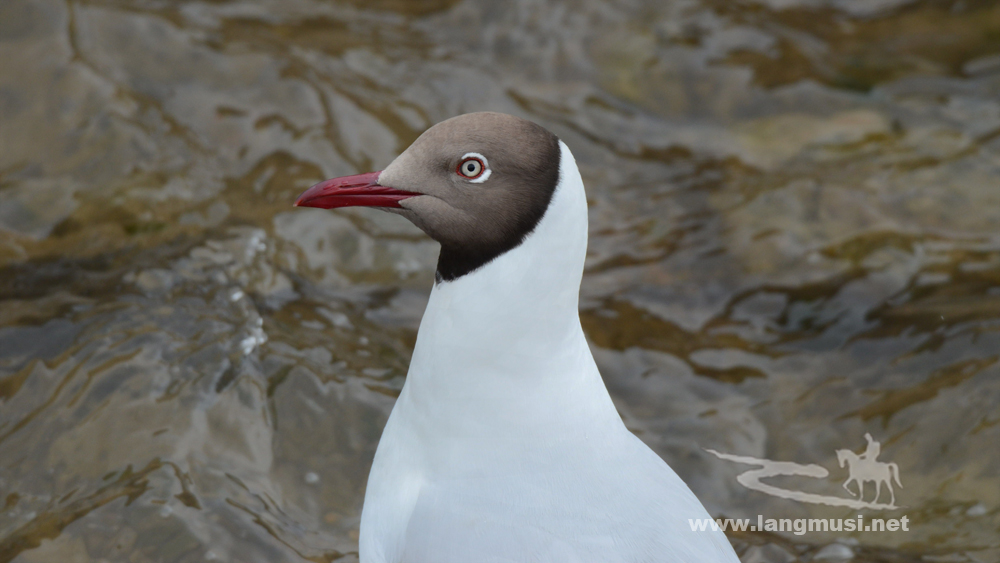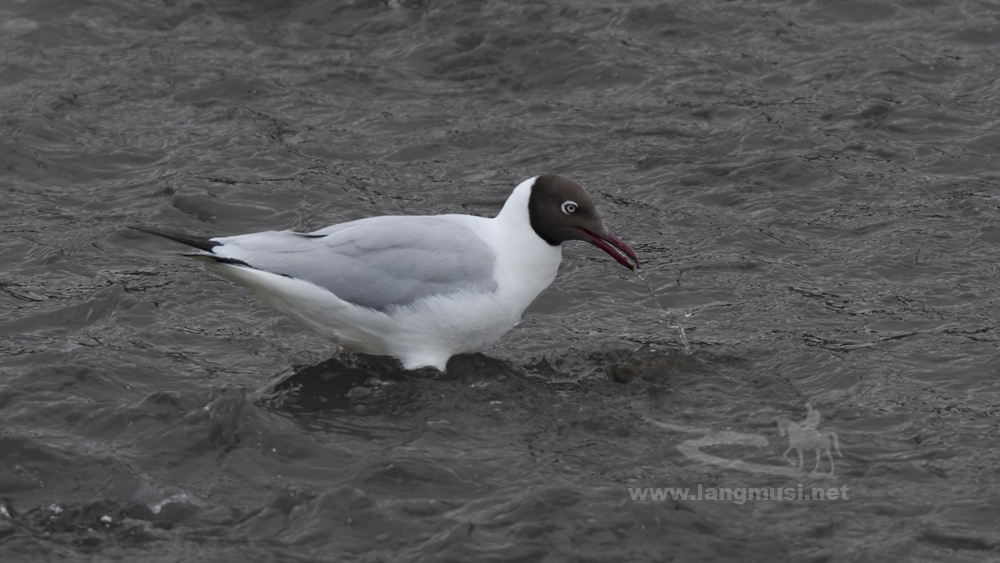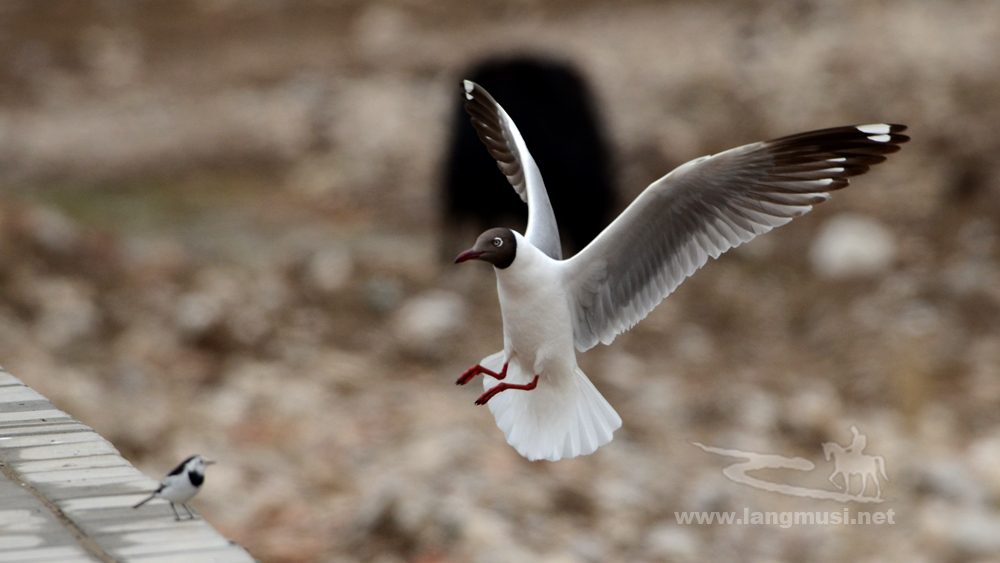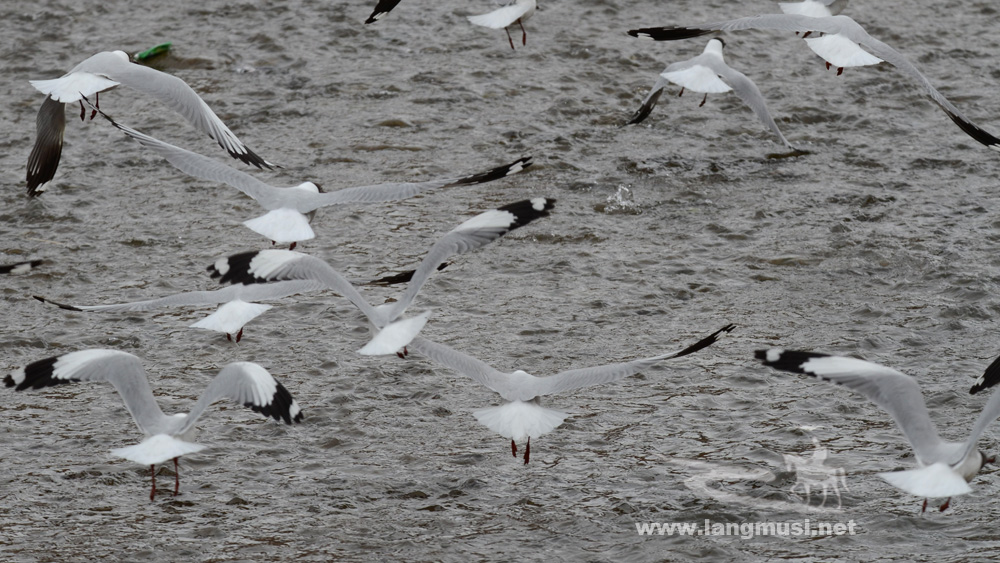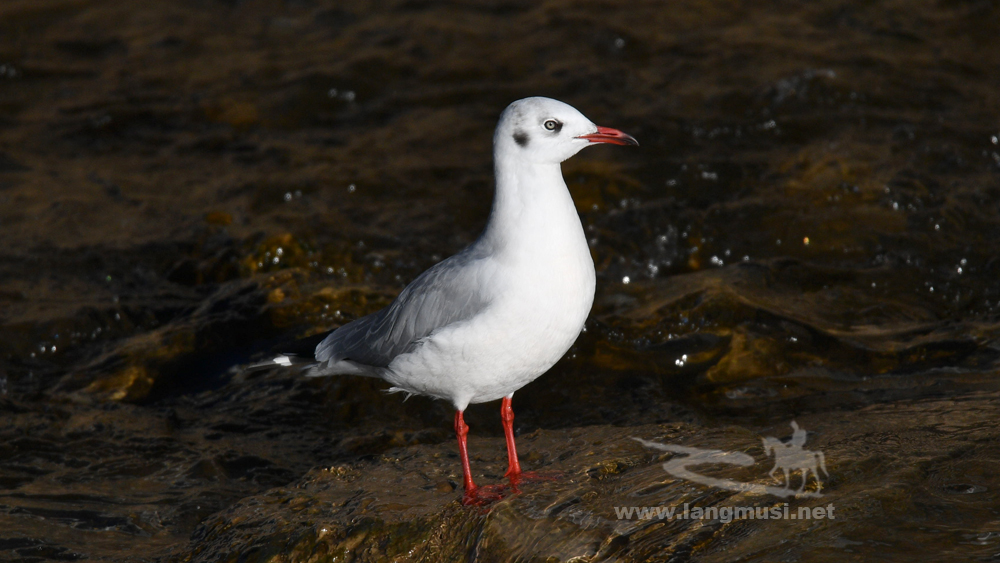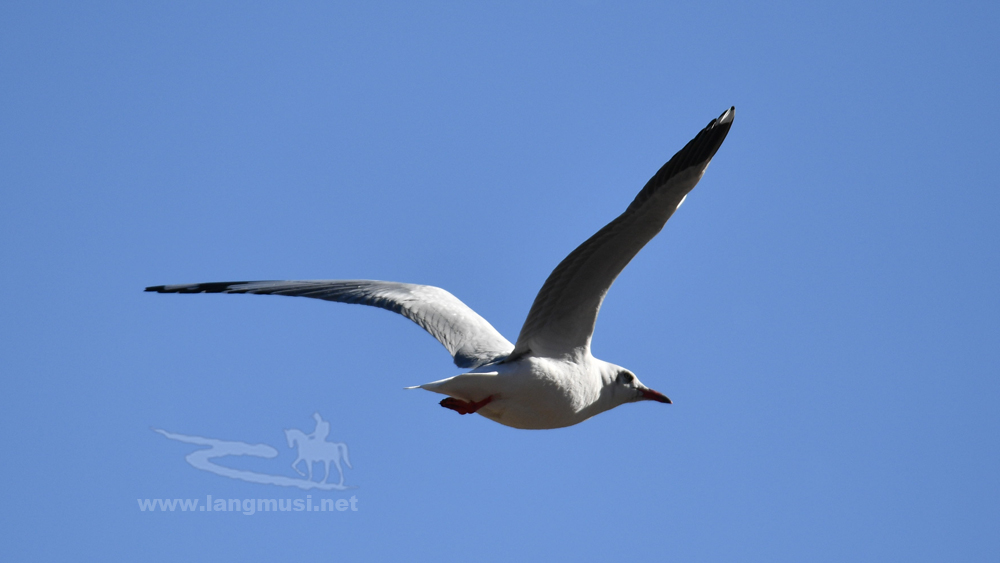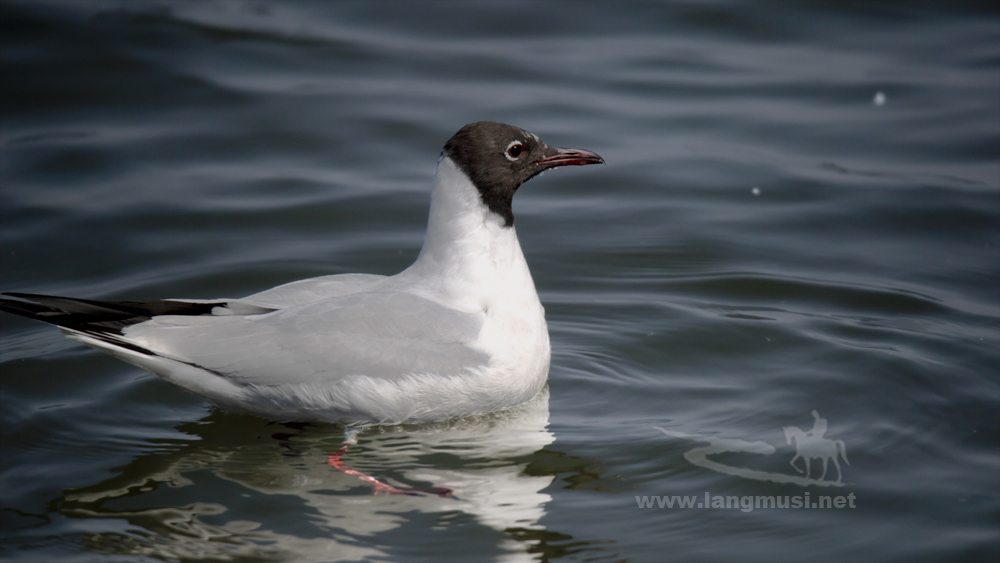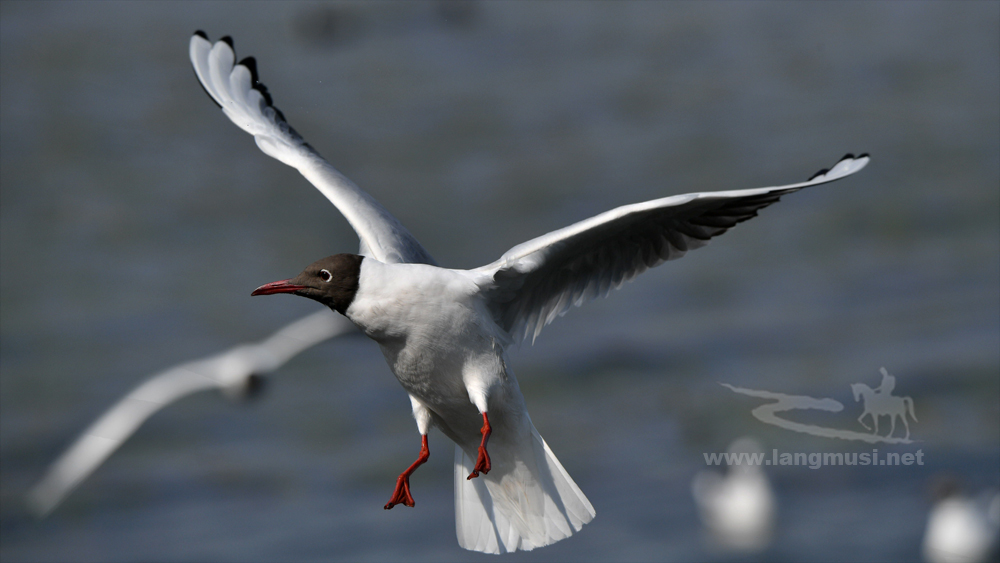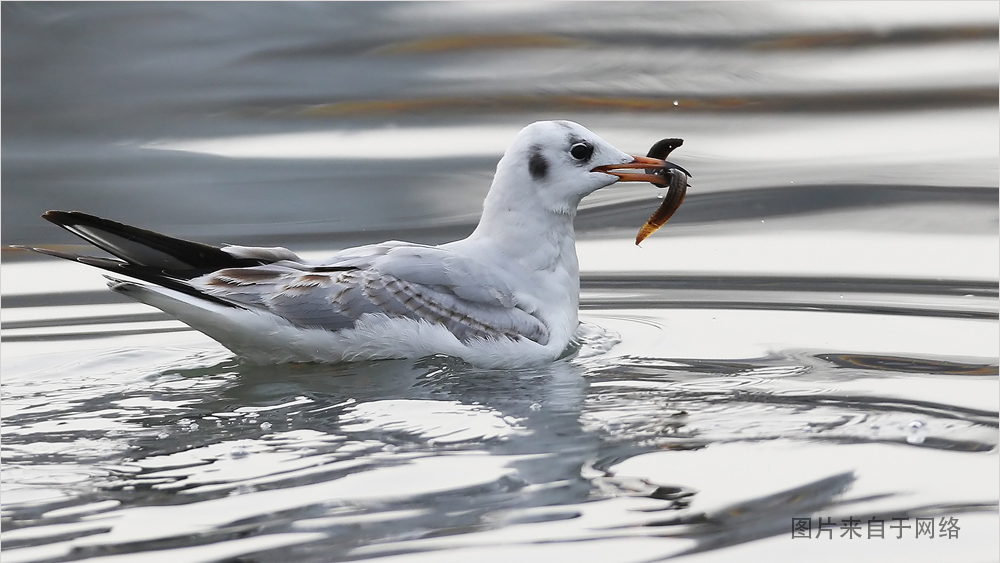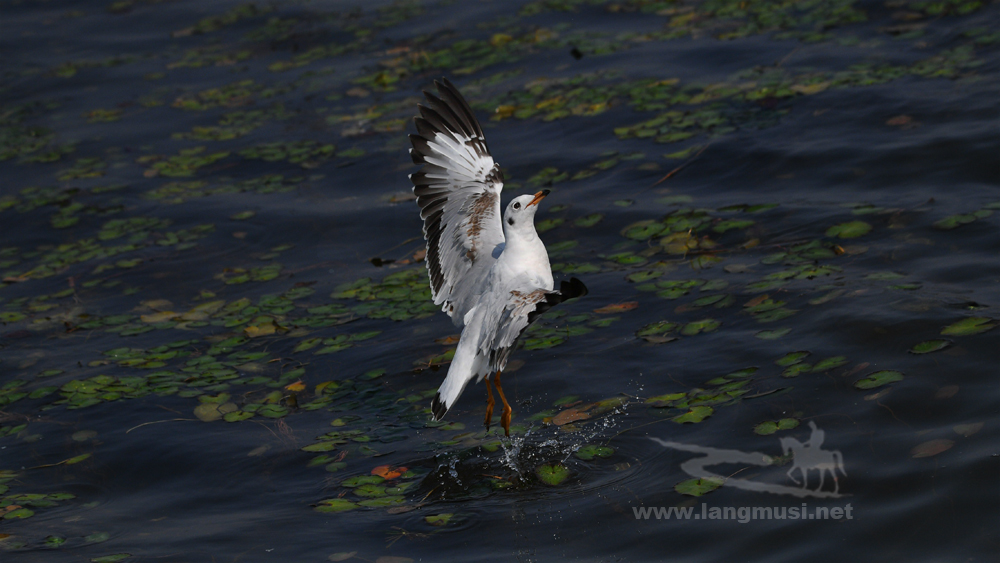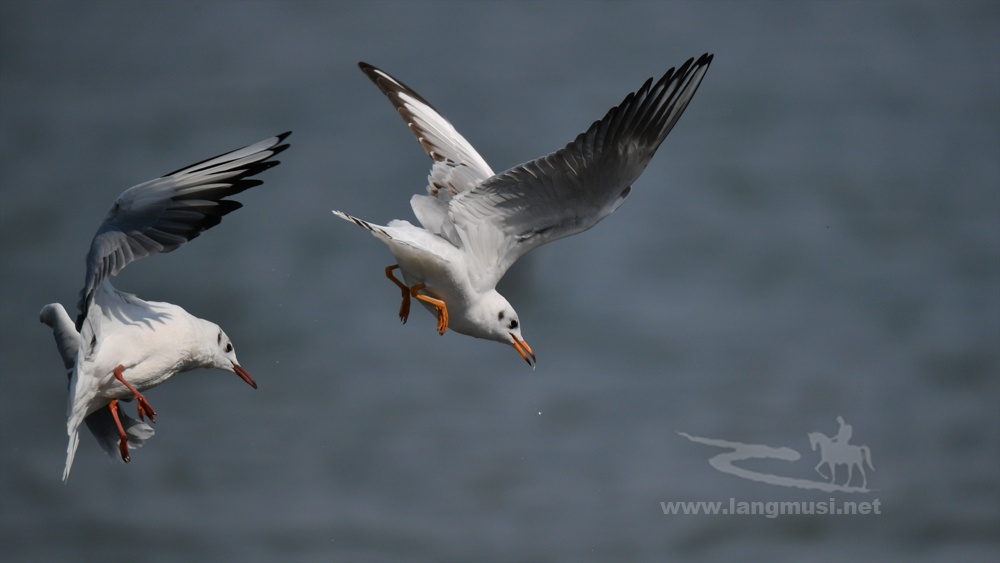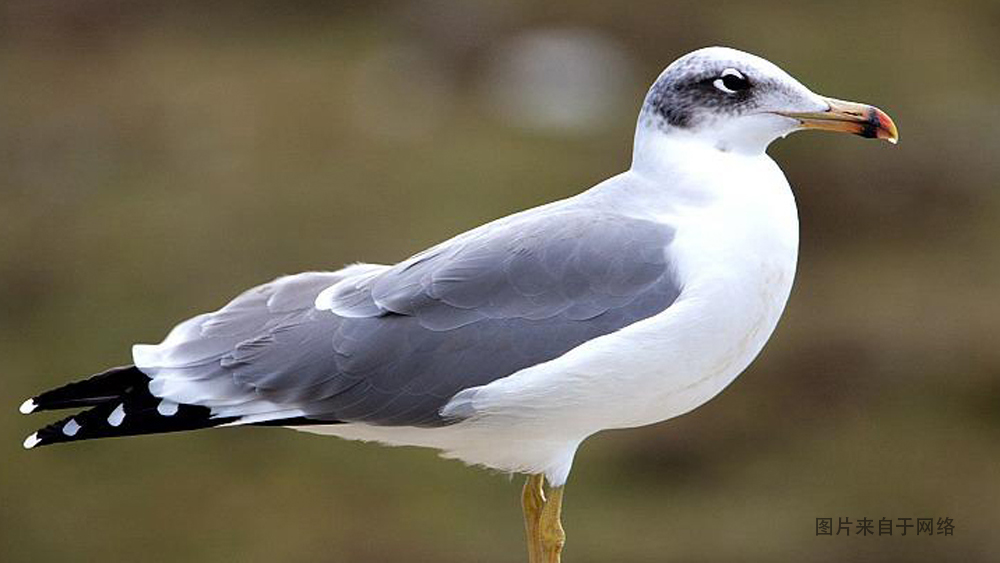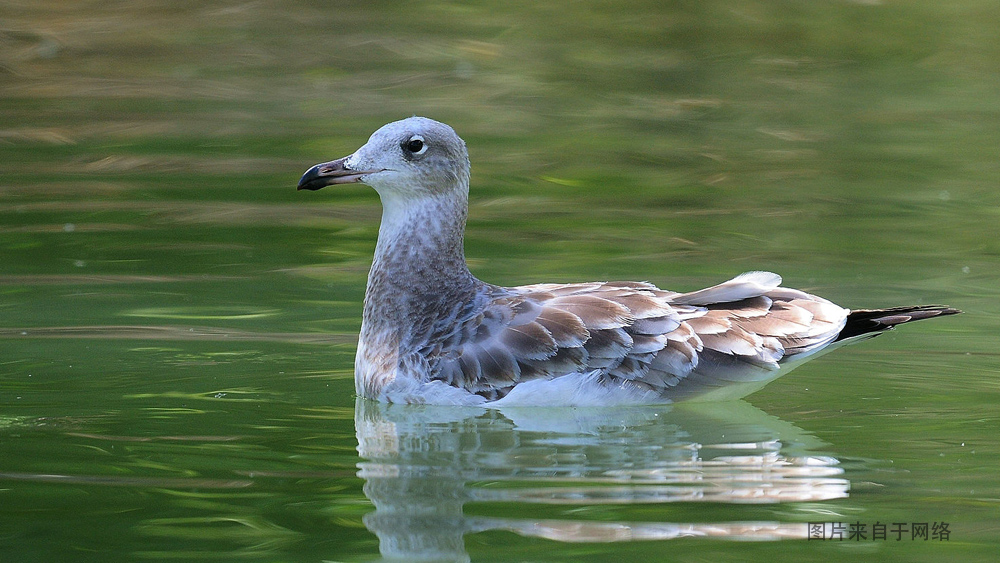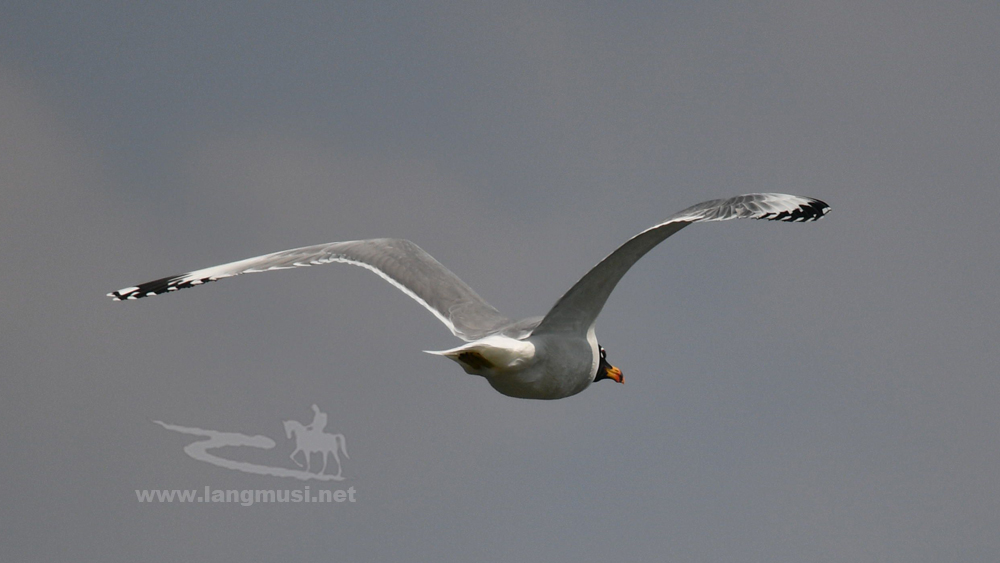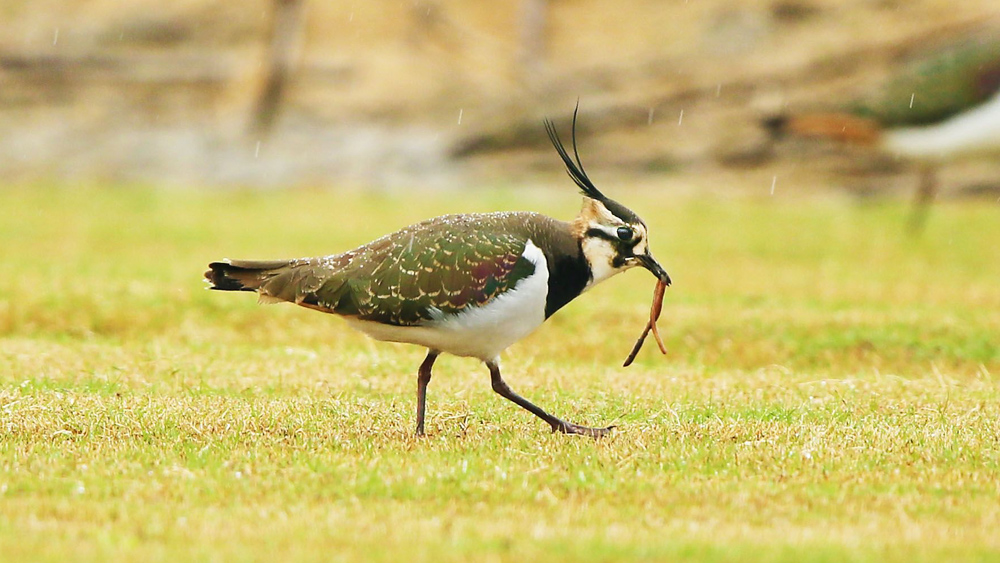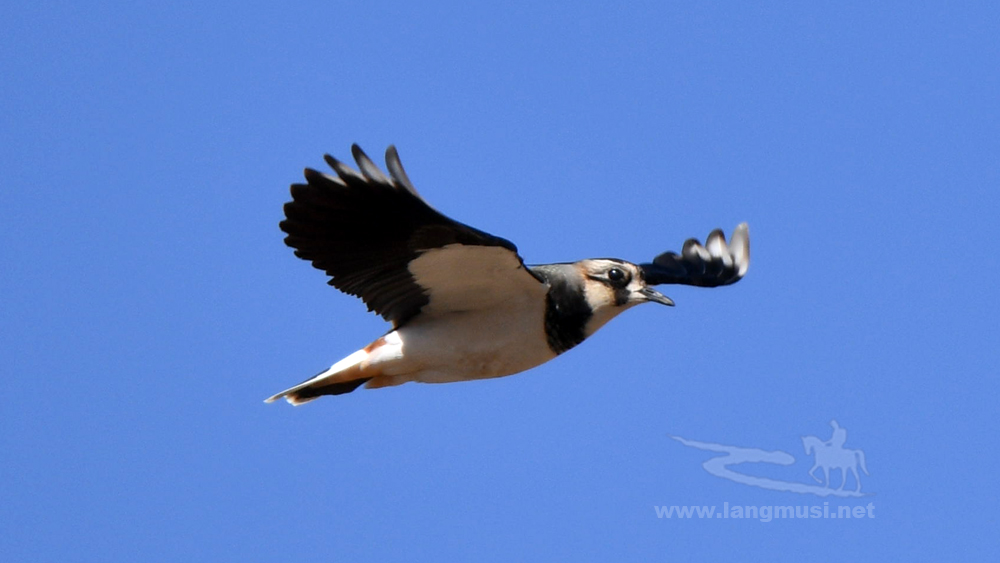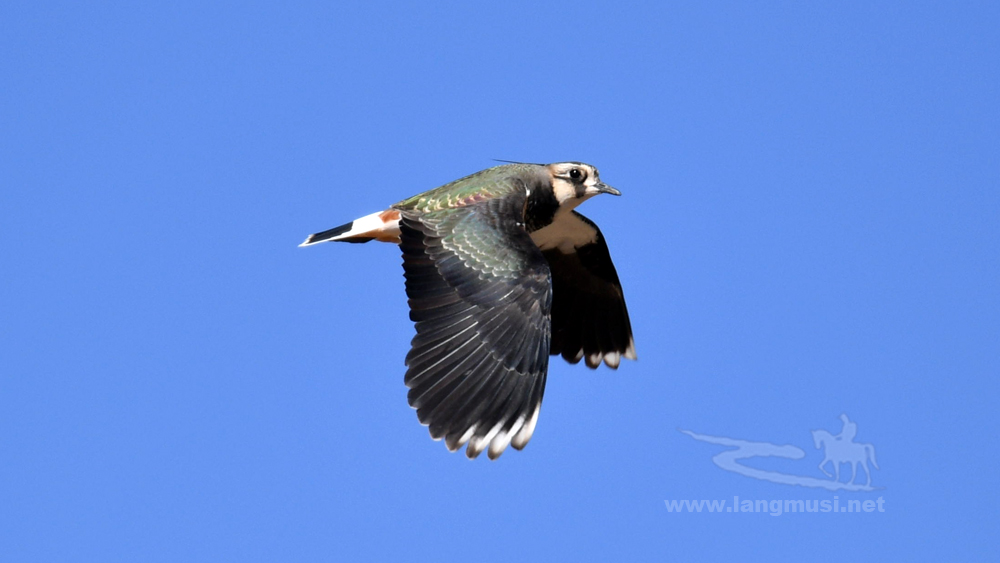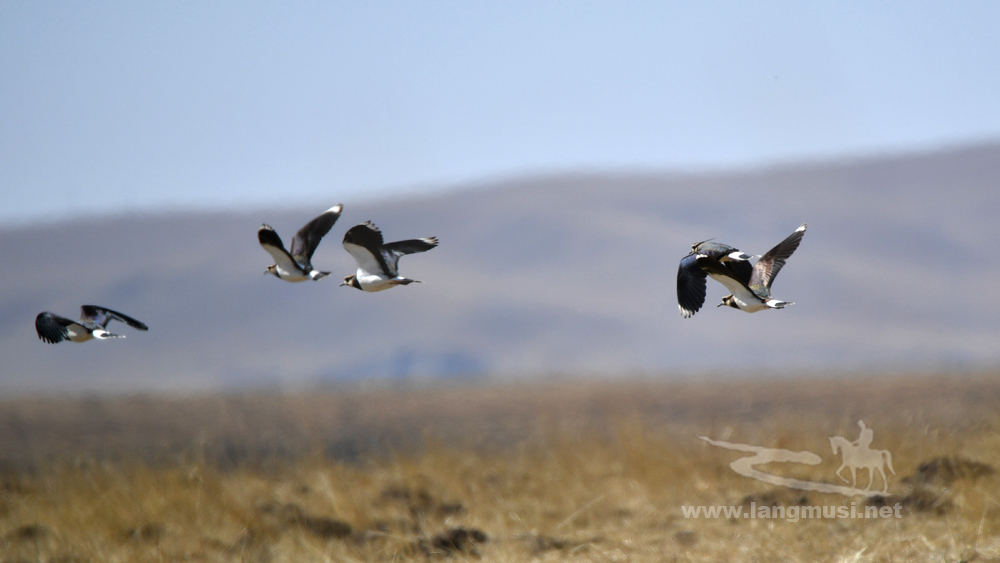The black-necked crane is a medium-sized crane in Asia that breeds on the Tibetan Plateau and remote parts of India and Bhutan.
The black-necked crane summers mainly in the high altitude Tibetan Plateau. The breeding areas are alpine meadows, lakeside and riverine marshes and river valleys. They also make use of barley and wheat fields in these areas. Wintering areas tend to be in sheltered valleys or lower altitudes. The largest populations are in China.
They feed on the tubers of sedges, plant roots, earthworms, insects and other invertebrates, frogs and other small vertebrates. They may also feed on fallen grains of barley, oats and buckwheat and will sometimes dig up and feed on potatoes, carrots and turnips.
Like many other crane species, they are believed to form long-lasting pair bonds and dancing displays are made during the breeding season. The breeding birds are territorial and will chase away any intruders of the same species immediately, though they are generally tolerant of other species. The nest site is usually a pre-existing mud island inside a large shallow wetland, sometimes shared along with bar-headed goose. Eggs are laid mainly in May and June. One or two eggs.
By 2011, the estimated population of the black-necked crane is between 8800 and 11000 individuals. However habitat modification, drying of lakes and agriculture are threats to the populations. In many areas, dogs belonging to herders are a major threat to young birds.
The black stork is seen in pairs or small flocks—in marshy areas, rivers or inland waters. The black stork feeds on amphibians and insects.
It is 95 to 100 cm in length with a 145–155 cm wingspan, and weighing around 3 kg.The sexes are identical in appearance, except that males are larger than females on average.
During the summer, the black stork is found from Eastern Asia (Siberia and China) west to Central Europe. They are not abundant in these western parts of their distribution, but more densely inhabit the eastern Transcaucasus. A population of black storks is also resident in Southern Africa.
The black stork builds a stick nest high in trees or on cliffs. It nests in Central Europe in April to May, and is a winter visitor to northern India, Nepal east to Myanmar.
Black stork parents have been known to kill one of their young, generally the smallest, in times of food shortage to reduce brood size and hence increase the chance of survival of the remaining nestlings. Stork nestlings do not attack each other, and their parents' method of feeding them (disgorging large amounts of food at once) means that stronger siblings cannot outcompete weaker ones for food directly, hence parental infanticide is an efficient way of reducing brood size. Despite this, this behaviour has not commonly been observed.
It is considered to be amongst the heaviest flying birds, at a length of 140–165 cm and a wingspan of 205–275 cm. Weight with an average of 9.8–11.4 kg for males and 8.2–9.2 kg for females.
Whooper swans require large areas of water to live in, especially when they are still growing, because their body weight cannot be supported by their legs for extended periods of time. The whooper swan spends much of its time swimming, straining the water for food, or eating plants that grow on the bottom.
Whooper swans pair for life, and their cygnets stay with them all winter; they are sometimes joined by offspring from previous years. Their preferred breeding habitat is wetland. Both the male and female help build the nest, and the male will stand guard over the nest while the female incubates. The female will usually lay 4–7 eggs (exceptionally 12). The cygnets hatch after about 36 days and have a grey or brown plumage. The cygnets can fly at an age of 120 to 150 days.
The grey heron native throughout temperate Europe and Asia and also parts of Africa. Over much of its range, the grey heron is resident, but birds from the more northerly parts of Europe migrate southwards, some remaining in central and southern Europe, others travelling on to Africa south of the Sahara Desert.
A bird of wetland areas, it can be seen around lakes, rivers, ponds, marshes and on the sea coast. The water body needs to be either shallow enough, or have a shelving margin in which it can wade. Fish, amphibians, small mammals and insects are taken in shallow water with the heron's long bill. It has also been observed catching and killing juvenile birds such as ducklings, and occasionally takes birds up to the size of a water rail. At night it roosts in trees or on cliffs, where it tends to be gregarious.
The birds breed colonially in spring in "heronries", usually building their nests high in trees. A clutch of usually three to five bluish-green eggs is laid. Both birds incubate the eggs for a period of about 25 days, and then both feed the chicks, which fledge when seven or eight weeks old. Many juveniles do not survive their first winter, but if they do, they can expect to live for about five years. There is usually a single generation each year, but two broods have been recorded.
It is found in shallow fresh and salt water wetlands and ponds in China and adjacent temperate and subtropical East Asia.
A mid-sized goose, it measures 71–76 cm in total length and weighs 1.87–3.2 kg.
The summer habitat is high-altitude lakes where the bird grazes on short grass. The species has been reported as migrating south from Tibet, Kazakhstan, Mongolia and Russia before crossing the Himalaya.
The bar-headed goose migrates over the Himalayas to spend the winter in parts of South Asia (from Assam to as far south as Tamil Nadu). The modern winter habitat of the species is cultivated fields, where it feeds on barley, rice and wheat, and may damage crops. Birds from Kyrgyzstan have been noted to stopover in western Tibet and southern Tajikistan for 20 to 30 days before migrating further south. Some birds may show high wintering site fidelity. They nest mainly on the Tibetan Plateau.
It has mottled and barred grey and white plumage and an orange (west) or pink (east) beak and legs. A large bird, it measures between 74 and 91 centimetres in length, with an average weight of 3.3 kilograms. Males are generally larger than females.
Its distribution is widespread, with birds from the north of its range in Europe and Asia migrating southwards to spend the winter in warmer places. It is the ancestor of the domestic goose.
Greylag geese travel to their northerly breeding grounds in spring, nesting on moorlands, in marshes, around lakes and on coastal islands. They normally mate for life and nest on the ground among vegetation. A clutch of three to five eggs is laid; the female incubates the eggs and both parents defend and rear the young. The birds stay together as a family group, migrating southwards in autumn as part of a flock, and separating the following year. During the winter they occupy semi-aquatic habitats, estuaries, marshes and flooded fields, feeding on grass and often consuming agricultural crops.
Greylag geese are herbivorous and feed chiefly on grasses. Short, actively growing grass is more nutritious and greylag geese are often found grazing in pastures with sheep or cows. They have been known to feed on oats, wheat, barley, buckwheat, lentils, peas and root crops.
The coot breeds across much of the Old World on freshwater lakes and ponds. It occurs and breeds in Europe, Asia, Australia, and Africa. The species has recently expanded its range into New Zealand. It is resident in the milder parts of its range, but migrates further south and west from much of Asia in winter as the waters freeze.
The Eurasian coot is 32–42 cm long and weighs 585–1,100 g, and is largely black except for the white frontal shield. As a swimming species, the coot has partial webbing on its long strong toes.
The Eurasian coot can be seen swimming on open water or walking across waterside grasslands. It is an aggressive species, and strongly territorial during the breeding season, and both parents are involved in territorial defence. During the non-breeding season they may form large flocks, possibly related to predator avoidance. As with many rails, its weak flight does not inspire confidence, but on migration, usually at night, it can cover surprisingly large distances.
This species builds a nest of dead reeds or grasses, laying up to 10 eggs, sometimes 2 or 3 times per season. Usually only a few young survive. They are frequent prey for birds such as herons and gulls.
Chick mortality occurs mainly due to starvation rather than predation. Most chicks died in the first 10 days after hatching, when they are most dependent on adults for food. Coots can be very brutal to their own young under pressure such as the lack of food. They will bite young that are begging for food and repeatedly do this until it stops begging and starves to death. If the begging continues, they may bite so hard that the chick is killed. Coots will also lay their eggs in the nests of other coots when their environment or physical condition limits their ability to breed, or to lengthen their reproductive life.
The coot is an omnivore, and will take a variety of small live prey including the eggs of other water birds, as well as algae, vegetation, seeds and fruit. It shows considerable variation in its feeding techniques, grazing on land or in the water. In the water it may upend in the fashion of a mallard or dive in search of food.
The ferruginous duck, also white-eyed pochard is a medium-sized diving duck from Eurasia.
The ferruginous duck prefers quite shallow fresh waterbodies with rich submerged and floating vegetation with dense stands of emergent vegetation on the margins. In some areas it will use saline or brackish pools or wetlands. On passage and wintering will also frequent coastal waters, inland seas and large, open lagoons.
These are gregarious birds. In areas where it is common it will form colonies at protected sites such as islands, often in association with gulls.
Eggs are laid from the end of April or early May in a nest which is sited on the ground close to water, or sometimes a floating nest is built among emergent vegetation. The eggs are incubated for 25–27 days and the fledging period is 55–60 days. These birds feed mainly by diving or dabbling. They eat aquatic plants with some molluscs, aquatic insects and small fish. They often feed at night, and will upend (dabble) for food as well as the more characteristic diving.
The red-crested pochard is a large diving duck. Its breeding habitat is lowland marshes and lakes in southern Europe and Central Asia, wintering in the Indian Subcontinent and Africa. It is somewhat migratory, and northern birds winter further south into north Africa.
They are gregarious birds, forming large flocks in winter, often mixed with other diving ducks. They feed mainly by diving or dabbling. They eat aquatic plants, and typically upend for food more than most diving ducks.
Red-crested pochards build nests by the lakeside among vegetation and lay 8–12 pale green eggs.
Their breeding habitat consists of marshes and lakes with a metre or more water depth. Pochards breed in much of temperate and northern Europe into Asia. They are migratory, and spend winter in the south and west of Europe.
These are gregarious birds, forming large flocks in winter, often mixed with other diving ducks. These birds feed mainly by diving or dabbling. They eat aquatic plants with some molluscs, aquatic insects and small fish. They often feed at night, and will up-end for food as well as the more characteristic diving.
The mallard is a medium-sized waterfowl species although it is often slightly heavier than most other dabbling ducks. It is 50–65 cm long (of which the body makes up around two-thirds), has a wingspan of 81–98 cm, and weighs 0.72–1.58 kg.
Mallards live in wetlands, eat water plants and small animals, and are social animals preferring to congregate in groups or flocks of varying sizes. This species is the main ancestor of most breeds of domesticated ducks.
The mallard or wild duck is a dabbling duck which breeds throughout the temperate and subtropical Americas, Eurasia, and North Africa, and has been introduced to New Zealand, Australia, Peru, Brazil, Uruguay, Argentina, Chile, the Falkland Islands and South Africa.
The mallard inhabits a wide range of habitat and climates, from Arctic tundra to subtropical regions. It is found in both fresh- and salt-water wetlands, including parks, small ponds, rivers, lakes and estuaries, as well as shallow inlets and open sea within sight of the coastline. Water depths of less than 1 metre are preferred, birds avoiding areas more than a few metres deep. They are attracted to bodies of water with aquatic vegetation.
The Eastern Spot-billed Duck is one of three Spot-billed Duck species in Eurasia, with the species sometimes considered conspecific. The Eastern Spot-billed Duck is the only one that has made an appearance in North America, with a handful of sightings in the Aleutian Islands. All Eurasia's Spot-billed Ducks are closely related to the Mallard.
Strongly migratory. In the summer, breeding birds are found in eastern Siberia, Japan, and elsewhere in eastern Asia. In the winter, they are found in southern China, the Phillipines, and Indonesia. Found in areas of shallow water such as ponds and freshwater marshes, with significant amounts of aquatic vegetation.
Primarily vegetarian, feeding on aquatic plants, seeds, and grasses and sedges. Will occasionally feed on insects. During the breeding season, they can be found nesting alone, or in small loose groups. They are much more gregarious in winter where they often form larger flocks.
The Eurasian teal or common teal is a common and widespread duck which breeds in temperate Eurasia and migrates south in winter. It is a highly gregarious duck outside the breeding season and can form large flocks. It is commonly found in sheltered wetlands and feeds on seeds and aquatic invertebrates. In the breeding season, it is a common inhabitant of sheltered freshwater wetlands with some tall vegetation, such as taiga bogs or small lakes and ponds with extensive reedbeds. In winter, it is often seen in brackish waters and even in sheltered inlets and lagoons along the seashore.
The Eurasian teal is the smallest extant dabbling duck at 20–30 cm (7.9–11.8 in) length and with an average weight of 340 g in drake (males) and 320 g in hens (females).
The Eurasian teal usually feeds by dabbling, upending or grazing; it may submerge its head and on occasion even dive to reach food. In the breeding season it eats mainly aquatic invertebrates, such as crustaceans, insects and their larvae, molluscs and worms. In winter, it shifts to a largely granivorous diet, feeding on seeds of aquatic plants and grasses, including sedges and grains. Diurnal throughout the breeding season, in winter they are often crepuscular or even nocturnal feeders.
It nests on the ground, near water and under cover. The pairs form in the winter quarters and arrive on the breeding grounds together, starting about March. The breeding starts some weeks thereafter, not until May in the most northernly locations. The nest is a deep hollow lined with dry leaves and down feathers, built in dense vegetation near water. After the females have started laying, the males leave them and move away for shorter or longer distances, assembling in flocks on particular lakes where they moult into eclipse plumage; they will usually encounter their offspring only in winter quarters. The clutch may consist of 5–16 eggs, but usually numbers 8–11; they are incubated for 21–23 days. The young leave the nest soon after hatching and are attended by the mother for about 25–30 days, after which they fledge. The drakes and the hens with young generally move to the winter quarters separately. After the first winter, the young moult into adult plumage. The maximum recorded lifespan – though it is not clear whether this refers to the common or the green-winged teal—was over 27 years, which is rather high for such a small bird.
The gadwall is 46–56 cm long with a 78–90 cm wingspan. The male is slightly larger than the female, weighing on average 990 g against her 850 g.
The gadwall breeds in the northern areas of Europe and Asia, and central North America.
It is a bird of open wetlands, such as prairie or steppe lakes, wet grassland or marshes with dense fringing vegetation, and usually feeds by dabbling for plant food with head submerged. It nests on the ground, often some distance from water. It is not as gregarious as some dabbling ducks outside the breeding season and tends to form only small flocks. This is a fairly quiet species; the male has a hoarse whistling call, and the female has a mallard-like quack. The young birds are fed insects at first; adults also eat some molluscs and insects during the nesting season.
It is a distinctive waterfowl, 58 to 70 cm in length with a wingspan of 110 to 135 cm. The birds moult at the end of the breeding season and the male loses the black collar, but a further partial moult between December and April restores it.
Its typical breeding habitat is large wetlands and rivers with mud flats and shingle banks, and it is found in large numbers on lakes and reservoirs. Though more common in the lowlands, it also inhabits higher altitudes and in central Asia is one of the few waterbirds, along with the bar-headed goose, to be found on lakes at 5,000 m. The male and female form a lasting pair bond and the nest may be well away from water, in a crevice or hole in a cliff, tree or similar site. A clutch of about eight eggs is laid and is incubated solely by the female for about four weeks. The young are cared for by both parents and fledge about eight weeks after hatching.
The ruddy shelduck is a mainly nocturnal bird. It is omnivorous and feeds on grasses, the young shoots of plants, grain and water plants as well as both aquatic and terrestrial invertebrates. On land it grazes on the foliage, in the water it dabbles in the shallows, and at greater depths, it up-ends, but it does not dive.
The ruddy shelduck is usually found in pairs or small groups and rarely forms large flocks. However, moulting and wintering gatherings on chosen lakes or slow rivers can be very large.
The main breeding area of the bird is from southeast Europe across central Asia to Lake Baikal, Mongolia, and western China. Eastern populations are mostly migratory, wintering in the Indian subcontinent.
The common merganser (North American) or goosander (Eurasian) is a large duck of rivers and lakes in forested areas of Europe, northern and central Asia, and North America.
It is 58–72 cm long with a 78–97 cm wingspan and a weight of 0.9–2.1 kg; males average slightly larger than females but with some overlap.
In most places, the common merganser is as much a frequenter of salt water as fresh water. In larger streams and rivers, they float down with the stream for a few miles, and either fly back again or more commonly fish their way back, diving incessantly the whole way. In smaller streams, they are present in pairs or smaller groups, and they float down, twisting round and round in the rapids, or fishing vigorously in a deep pool near the foot of a waterfall or rapid. When floating leisurely, they position themselves in water similar to ducks, but they also swim deep in water like cormorants, especially when swimming upstream. They often sit on a rock in the middle of the water, similar to cormorants, often half-opening their wings to the sun. To rise from water, they flap along the surface for many yards. Once they are airborne, the flight is strong and rapid. They often fish in a group forming a semicircle and driving the fish into shallow water, where they are captured easily.
Nesting is normally in a tree cavity, so it requires mature forest as its breeding habitat; they also readily use large nest boxes where provided, requiring an entrance hole 15 cm (5.9 in) in diameter. In places devoid of trees (like Central Asian mountains), they use holes in cliffs and steep, high banks, sometimes at considerable distances from the water.
The species is a partial migrant, with birds moving away from areas where rivers and major lakes freeze in the winter, but resident where waters remain open.
The great crested grebe is noted for its elaborate mating display. The great crested grebe is the largest member of the grebe family found in the Old World, with some larger species residing in the Americas. They measure 46–51 cm long with a 59–73 cm wingspan and weigh 0.9 to 1.5 kg.
The great crested grebe breeds in vegetated areas of freshwater lakes. The subspecies P. c. cristatus is found across Europe and Asia. It is resident in the milder west of its range, but migrates from the colder regions. It winters on freshwater lakes and reservoirs or the coast. The African subspecies P. c. infuscatus and the Australasian subspecies P. c. australis are mainly sedentary.
Usually two eggs are laid, and the fluffy, striped young grebes are often carried on the adult's back. In a clutch of two or more hatchlings, male and female grebes will each identify their 'favourites', which they alone will care for and teach. Unusually, young grebes are capable of swimming and diving almost at hatching. The adults teach these skills to their young by carrying them on their back and diving. The great crested grebe feeds mainly on fish, but also small crustaceans, insects and small frogs.
Insects, which make up the majority of this bird's diet, are caught either on the surface of the water or when they are in flight. This grebe dives to catch crustaceans, molluscs, tadpoles, and small frogs and fish.
The black-necked grebe makes a floating cup nest on an open lake. The nest cup is covered with a disc. This species will lay one (sometimes two) clutch of three to four eggs.
Although it generally avoids flight, the black-necked grebe travels as far as 6,000 kilometres during migration. In addition, it becomes flightless for two months after completing a migration to reach an area where it can safely moult. During this moult, the grebe can double in weight. The migrations to reach these areas are dangerous, sometimes with thousands of grebe deaths.
The great cormorant is a large black bird, but there is a wide variation in size in the species wide range. Weight is reported to vary from 1.5 kg to 5.3 kg. Males are typically larger and heavier than females.
The great cormorant breeds mainly on coasts, nesting on cliffs or in trees (which are eventually killed by the droppings), but also increasingly inland. Three or four eggs are laid in a nest of seaweed or twigs. The great cormorant can dive to considerable depths, but often feeds in shallow water. It frequently brings prey to the surface. A wide variety of fish are taken.
Many fishermen see in the great cormorant a competitor for fish. Because of this, it was hunted nearly to extinction in the past. Thanks to conservation efforts, its numbers increased. Increasing populations have once again brought the cormorant into conflict with fisheries.
The great cormorant across the Northern Hemisphere. It breeds in much of the Old World and the Atlantic coast of North America. It feeds on the sea, in estuaries, and on freshwater lakes and rivers. Northern birds migrate south and winter along any coast that is well-supplied with fish.
The common redshank is a widespread breeding bird across temperate Eurasia. It is a migratory species, wintering on coasts around the Mediterranean, on the Atlantic coast of Europe from Ireland and Great Britain southwards, and in South Asia. They are uncommon vagrants outside these areas.
They are wary and noisy birds which will alert everything else with their loud piping call. Like most waders, they feed on small invertebrates. Redshanks will nest in any wetland, from damp meadows to saltmarsh, often at high densities. They lay 3–5 eggs.
The adult is 18–20 cm long with a 32–35 cm wingspan.
The common sandpiper forages by sight on the ground or in shallow water, picking up small food items such as insects, crustaceans and other invertebrates; it may even catch insects in flight. It nests on the ground near freshwater. When threatened, the young may cling to their parent's body to be flown away to safety.
It is a gregarious bird and is seen in large flocks, and has the distinctive stiff-winged flight, low over the water, of Actitis waders. The common sandpiper breeds across most of temperate and subtropical Europe and Asia, and migrates to Africa, southern Asia and Australia in winter. It is widespread and common.
The breeding habitat of all these stilts is marshes, shallow lakes and ponds. Some populations are migratory and move to the ocean coasts in winter; those in warmer regions are generally resident or short-range vagrants.
These birds pick up their food from sand or water. They mainly eat insects and crustaceans.
This bird has a circumpolar distribution, its four subspecies breeding in temperate and subarctic regions of Europe, Asia and North America. It is strongly migratory, wintering in coastal tropical and subtropical regions. As long distance migrants, common terns sometimes occur well outside their normal range. The common tern breeds over a wider range of habitats than any of its relatives, nesting from the taiga of Asia to tropical shores, and at altitudes up to 2,000 m in Armenia, and 4,800 m in Asia. It avoids areas which are frequently exposed to excessive rain or wind, and also icy waters, so it does not breed as far north as the Arctic tern. The common tern breeds close to freshwater or the sea on almost any open flat habitat, including sand or shingle beaches, firm dune areas, salt marsh, or, most commonly, islands. The common tern breeds in colonies which do not normally exceed 2,000 pairs. Colonies inland tend to be smaller than on the coast. As with many birds, the same site is re-used year after year, with a record of one pair returning for 17 successive breeding seasons. Terns are expert at locating their nests in a large colony. The peak time for egg production is early May, with some birds, particularly first-time breeders, laying later in the month or in June. The clutch size is normally three eggs.
The common tern nests on any flat, poorly vegetated surface close to water, including beaches and islands. The nest may be a bare scrape in sand or gravel, but it is often lined or edged with whatever debris is available. Up to three eggs may be laid, their dull colours and blotchy patterns providing camouflage on the open beach. Incubation is by both sexes, and the eggs hatch in around 21–22 days, longer if the colony is disturbed by predators. The downy chicks fledge in 22–28 days.
Eggs and young are vulnerable to predation by mammals such as rats and American mink, and large birds including gulls, owls and herons.
12 years is a typical lifespan.
The brown-headed gull is a small gull which breeds in the high plateaus of central Asia from Tajikistan to Ordos in Inner Mongolia. It is migratory, wintering on the coasts and large inland lakes of the Indian Subcontinent.
This gull breeds in colonies in large reedbeds or marshes, or on islands in lakes, nesting on the ground. Like most gulls, it is highly gregarious in winter, both when feeding or in evening roosts. It is not a pelagic species, and is rarely seen at sea far from coasts.
This is a bold and opportunist feeder, which will scavenge in towns or take invertebrates in ploughed fields with equal relish.
This bird takes two years to reach maturity.
The black-headed gull is a small gull that breeds in much of Europe and Asia, and also in coastal eastern Canada. Most of the population is migratory and winters further south, but some birds reside in the milder westernmost areas of Europe.
It breeds in colonies in large reed beds or marshes, or on islands in lakes, nesting on the ground. Like most gulls, it is highly gregarious in winter, both when feeding or in evening roosts. It is not a pelagic species and is rarely seen at sea far from coasts.
The black-headed gull is a bold and opportunistic feeder. It eats insects, fish, seeds, worms, scraps, and carrion in towns, or invertebrates in ploughed fields with equal relish. It is a noisy species, especially in colonies.
This species takes two years to reach maturity. Like most gulls, black-headed gulls are long-lived birds, with a maximum age of at least 32.9 years recorded in the wild.
The Pallas's gull or great black-headed gull is a large gull.
This species breeds in colonies in marshes and islands from southern Russia to Mongolia. It is migratory, wintering in the eastern Mediterranean, Arabia and India. This gull nests on the ground, laying between two and four eggs.
It occurs in western Europe only as a rare vagrant. The species also occurs as a vagrant in differing parts of the Indian Ocean, south of its normal range, and along the northern and eastern coasts of Africa, where it visits annually on an irregular basis.
This is a very large gull, being easily the world's largest black-headed gull and the third largest species of gull in the world, after the great black-backed gull and the glaucous gull. It measures 55–72 cm in length with a 142 to 170 cm wingspan. Weight average 1.6 kg in males and 1.22 kg in females. The legs are yellow and the bill is red. Young birds attain largely grey upperparts quite rapidly, but they take four years to reach maturity.
Although they are noisy at colonies, Pallas's gulls are mostly silent when breeding.
These birds are predatory, taking fish, crustaceans, insects and even small mammals.
It is common through temperate Eurasia. It is highly migratory over most of its extensive range, wintering further south as far as north Africa, northern India, Pakistan, and parts of China. It migrates mainly by day, often in large flocks. Lowland breeders in westernmost areas of Europe are resident.
It is a wader which breeds on cultivated land and other short vegetation habitats. 3–4 eggs are laid in a ground scrape. The nest and young are defended noisily and aggressively against all intruders, up to and including horses and cattle. In winter, it forms huge flocks on open land, particularly arable land and mud-flats.
The northern lapwing is a 28–33 cm long bird with a 67–87 cm wingspan and a body mass of 128–330 g. It has rounded wings and a crest. It is also the shortest-legged of the lapwings. It is mainly black and white, but the back is tinted green. The male has a long crest and a black crown. Females and young birds have shorter crests, and have less strongly marked heads, but plumages are otherwise quite similar.
It feeds primarily on insects and other small invertebrates. This species often feeds in mixed flocks with golden plovers and black-headed gulls, the latter often robbing the two plovers, but providing a degree of protection against predators. Like the golden plovers, this species prefers to feed at night when there is moonlight.
